The Complete Guide to Branding for Travel and Tourism
By Erick Tomaliwan
Share this article:
- Facebook icon
- LinkedIn icon
- Twitter icon

Your tours and activities shouldn’t be the only unforgettable thing. Guests should remember your tour name , too. That’s where the importance of branding comes into play.
As a marketing tactic, branding personifies your tourism business. It gives you a voice, looks, personality, and values — which makes you more relatable to your guests and other travelers. Ultimately, a well-defined brand helps you appeal to the right audience, as well as leave a lasting impression.
If you want to create a brand identity or tweak your current one, this article is just for you. We outline what you need to know about positioning and differentiating your business — which includes:

The importance of a tourism branding strategy
How to create a memorable travel brand.
- 15 travel branding ideas
So let’s get started:
Frequently, tour and activity operators lose sight of their brand when they rely heavily on Online Travel Agents (OTAs) for bookings. Although these channels help to expand your reach, they don’t necessarily do your brand justice. That’s because you’re just another listing on their site — meaning you get absorbed into their brand identity instead.
Think of it this way. A traveler who books your tours and activities on Tripadvisor encounters the Tripadvisor brand throughout the booking journey — not yours. Consequently, they don’t get much of a chance to become familiar with your business. When it comes to referrals or repeat bookings, they’ll remember Tripadvisor, but will have a harder time recalling your name.
Although this may seem like it isn’t a huge deal — since you can give a glimpse of your brand in-person — it’s not a long-term solution. While listing on OTAs is still a great marketing strategy, it’s important to build your brand outside of these sites. And here are four main reasons why:

1. Branding gets more bookings
When your tour and activity company looks polished and legitimate, guests will be more likely to book with you. That’s because professional translates to trustworthy. With a unique brand voice and beautiful brand design, you’ll make your business stand out as the best option for a safe and unforgettable experience.
2. Branding improves recognition
Without a doubt, your brand is the face of your business. Guests won’t just remember your name, but your logo as well. So whenever they interact with you — whether it’s browsing your website, reading your emails, or seeing your Facebook ads — they’ll be able to recognize your business instantly.
3. Branding makes you memorable
Many think of branding as a logo and a slogan. But it’s so much more than that. From start to finish, a brand is a visual, emotional, and tangible experience that you create for your guests. When you get this right, guests will remember for a long time — not just a couple of weeks after the tour or activity. And those that think of you will be loyal to you.
4. Branding increases your value
Brand equity is the value of your brand name. Having a well-known brand name will help establish your company as a leader in your niche and give your business a boost for further expansion — like opening up a tour office in another location. Since brand equity is all about brand recognition, you can increase your value by building a stronger brand and delivering consistent exposure — which brings us to the next section
If you’re starting your own tour company and haven’t defined your brand yet, make this a priority. Early branding will provide your team with direction, and help customers grasp what your tourism business is all about.
Even if you’re well-established, it’s never too late to fine-tune your brand. Instead of targeting a huge customer base, try thinking of fresh business ideas in tourism and hospitality, and narrowing your focus on a particular niche. Why? Because it can give you a competitive edge and improve your online visibility.
So follow these steps to build a better brand identity:
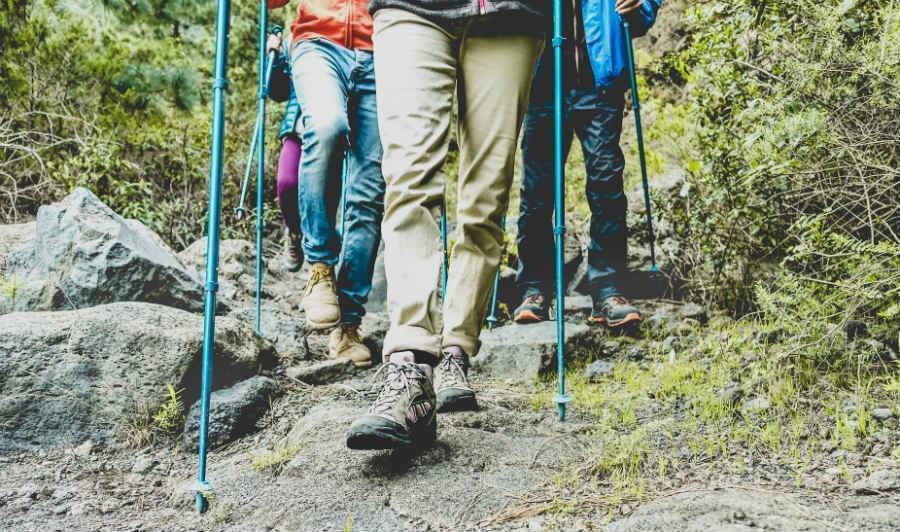
1. Craft your brand story
Every business has a backstory. There’s always a reason why a company comes to be. Sometimes, it sparks out of an opportunity, but more often than not, a tourism business starts from passion — passion for adventure , the destination, or the community.
Knowing why you started will help to uncover your brand values — which are the building blocks of a compelling brand story. By writing them out and sharing publicly, you’ll have principles to guide your business decisions, as well as a reference point to build trust and credibility.
To dig deeper into your company’s purpose, ask yourself the following questions:
- How did you start your tour and activity business?
- Where’d you get the idea? What inspired you?
- How is your company different from your competitors?
- What does your tour and activity business strive to do?
- What makes your team outstanding?
Work these answers into your brand story to tell who you are as an operator and what sets you apart. Keep in mind that it doesn’t have to be lengthy — brief is best. Nor does it have to be perfect; authenticity goes a long way.
2. Identify your target audience
It’s easier to match your brand to your target audience than the other way around. Depending on your offerings, you might already appeal to a particular group of people — different types of travelers like different types of travel experiences. So branding before knowing your target audience could lead to something that doesn’t make any sense.
For example, let’s say you run a craft beer bike tour. It’s safe to assume eco-friendly, locavore millennials will want to try this experience. But if you build a brand that speaks more to DIY, suburban mothers, there’s going to be a disconnect, and you’ll have a much harder time reaching those initially interested.
Who’s most likely to book your tours and activities then? Where are they from, how old are they, what’s their lifestyle, interests, and personality? These are just a few examples of demographic, physiographic, and geographic attributes you should consider.
Use this information to create a brand identity that your target audience will strongly identify with. You can also use it to gain insight into their communication style, preferred method of booking, and where they hang out online. All of which can help you with your marketing efforts.

3. Align with your destination brand
What’s a destination brand? It’s a shared vision that aims to generate visitor interest by promising a unique travel experience based on everything a place offers. Usually, a Destination Marketing Organization (DMO) builds the destination brand and provides direction for local businesses to follow suit.
Take Ireland as an example. Most travelers visit the Emerald Isle for the pub culture, castle hopping, and traditional folklore. So Tourism Ireland promotes it as a destination to “fill your heart.” This brand position makes new visitors believe they’ll have heart-warming moments while also giving tour and activity operators insight into what they want out of their trip.
That’s why it’s a good idea to find a role within your destination brand. Visitors arrive with preset expectations thanks to it, and naturally, book things to do that match. If you deliver on what they’re looking for, they’ll have a positive and memorable experience — which impacts their perception of the destination, as well as your business.
Of course, this doesn’t mean you have to copy and paste the destination brand. You can still express your brand identity while playing a part in the overarching destination story. It just comes down to making a connection between the two. Like with the above example, a bus tour company might make its brand more enchanting to go along with that of Tourism Ireland.
4. Figure out your brand voice and tone
Your personality, attitude, and values shine through when you communicate with others. The same applies to your tour and activity business. Every written message — whether online or offline — reveals your company’s characteristics and mission. That’s known as your brand voice.
A clear and distinct brand voice helps to position yourself in the marketplace and associate with your target audience. However, it’s got to be the same across all channels to be effective. Being sassy on social media but helpful on the blog only makes readers confused — which means they won’t get an accurate picture of your business.
On the other hand, your tone of voice is interchangeable because it reflects your mood. Its purpose is to have an emotional impact on the reader based on the context of the message. For example, a serious tone works well for a payment request whereas a booking confirmation is better off sounding joyful.
To figure out your brand voice and tone, start by:
- Reviewing your company’s mission statement and values
- Looking at your current content for common themes
- Considering how your target audience communicates
- Evaluating your destination’s brand messaging
Whatever you come up with, break it down into three or four words. These will be your primary voice characteristics for all of your messaging. You can further describe your brand voice in a content style guide with the do’s and don’ts of writing accordingly. As for the tone, you have a little more flexibility with its use, but it shouldn’t stray too far from your brand voice.

5. Give your travel brand a makeover
Here’s where the fun begins. There’s nothing more exciting than putting together a look for your tour and activity business. From a memorable logo to unique typography, you get to make your brand pop while giving your guests a great first impression.
Visual elements also contribute the most to brand recognition. For example, when someone thinks of Google, the first thing that comes to mind is the primary colours. In the tourism industry, Contiki stands out to young travelers with imagery that plays on the Fear of Missing Out (FOMO). So what does your brand design need to get noticed?
- Logo: This is the foundation of your brand identity because it goes everywhere — on your website, social media, merchandise, promotional materials, and more. Whether it’s a logomark or logotype, the design should be simple, memorable, timeless, and accurately symbolize your company’s mission and culture.
- Typography: Believe it or not, fonts come with personality traits. While Serif fonts (Arial, Verdana) come across as reliable and mature, Modern fonts (Impact, Rockwell) give off a bold and progressive vibe. Knowing this, you can use a specific font to influence how guests perceive your business.
- Colour Palette: Similar to fonts, colours have an emotional impact on people. For instance, red means passion, green is natural and blue goes with trust. With the right mix of colours, you can reveal a lot about your business while making your guests feel a certain way.
- Imagery: Photos and videos show the kind of experiences you offer. But images also engage and inspire viewers — helping them picture having the experience, too. That’s why you should use imagery wherever you can. Just remember that brand images should be cohesive too, so consider using presets to promote uniformity.
6. Build consistency into your tour website
This is where everything comes together. Not only is your website a digital storefront, but it’s also the face of your company. Online visitors go there seeking more information about your tours and activities. While doing so, they get a clear picture of who you are as a business, too.
For this reason, it’s important to have brand consistency throughout. That means every page should resemble the other. From the look to voice to feel, your brand should be apparent no matter where someone clicks.
There are several ways to show off your brand on your website. So here are a few must do’s to get you on the right track today:
- Create an About Us page: Sometimes, online visitors want to learn more about your business beyond the Booking page. So share your brand story with them in your About Us section. Here, it’s a good idea also to outline your mission and core values. That way, a conscientious traveler can see what makes you an ethical tourism example .
- Use relevant keywords: Once you know your target audience, you can figure out what search queries they frequently use for travel shopping. These terms will dictate what long-tail keywords you should sprinkle throughout to optimize your website — which includes page titles, headers, body text, meta-descriptions, image alt-text, and your URLs.
- Maintain a uniform design: Your brand should be recognizable based on your look alone. So on your website, make sure you use the same colour palette, typography, and imagery on every page. As well, place your logo at the top, and create a branded favicon (the icon next to the URL) to remind visitors where they’re browsing.
- Remember your brand voice: You have written content everywhere on your website. So there’s a perfect opportunity to strengthen your brand by ensuring all of your copy sticks to your brand voice. You may even consider keeping a blog to establish this further. Just remember that whoever contributes should follow your content style guide.
- Customize your booking process: After taking the time to build your brand into your website, it’d be a shame for your Booking page to miss the mark. Online visitors shouldn’t feel like they leave your site when they go to book. That’s why it’s best to use an online booking system that doesn’t lead to a separate domain and allows for some customization.

15 extra travel branding ideas
Branding your tour and activity business isn’t a one-and-done type of job. The more you do, the more your brand strengthens over time, especially if you make branding part of your strategic planning process . So here are a bunch of additional ways you can help build your brand:
- Hire a professional photographer to take high-quality images of your experiences
- Do the same with a professional videographer
- Partner with a travel influencer that fits your brand
- Create a Facebook contest to create hype for your brand
- Only post content on social media channels that your target audience uses
- Make your tour guides into brand ambassadors
- Contribute guest posts to publications within your industry
- Send out a survey asking guests what they think of your brand
- Come up with different slogans and test which one drives the best results
- Use Answer the Public and Quora to get blog topic ideas that are relevant to your audience
- Customize your booking notifications with your brand voice
- Design templates for your email marketing that follow your brand design
- Come up with a brand hashtag for your guests to use when posting about their experience with you
- Reward your guests for referrals with a discount code
- Let your staff take over social media to show the human side of your business
Need a little help strengthening your tourism brand?

Join the 30-Day ‘Things to Do’ Challenge for Tour Operators
Complete one small task every day that’ll help your brand shine online.
Related Articles

Defining your value proposition: standing out against the competition
You’re not the only one vying for the attention of your ideal customers Demand for epic experiences is growing —…
- Business Tips
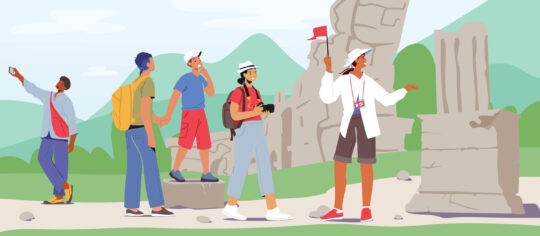
How to start a Tour Operator business in 2024: A step-by-step guide
Dreaming of running a successful tour company? Check out these strategies!
Search Blog
Subscribe to our newsletter.
Get tips and strategies to grow your business and impress your guests.
Blog Categories
- Booking Management
- Guest Experience
- Marketing Strategies
- Operator Highlights

Ultimate Guide to Travel & Tourism Sector Branding
Ultimate Guide to Travel & Tourism Sector Branding
Tourism marketing is a crucial activity (and increasingly so) in the tourism sector. That is why tourism branding takes particular relevance as a differential and success factor.
Tourists are increasingly demanding, and tourism competition is fiercer. Tourism branding is positioned as an alternative capable of breaking down barriers and attracting, converting, and closing new tourists to destinations.
Marketers distinguish two types of branding in this domain: tourism sector branding and travel business branding. In this article, we will discuss both.
Table of Contents
What is tourism sector branding?
Tourism sector branding is building a tourism brand, from conceptualising the brand and the strategic brand platform to the graphic and visual elements.
Branding in the tourism sector aims to design and associate a tourist destination with a brand that can be marketed and adapted to different formats. It serves as a symbol for disseminating and contextualising the destination's values.
Tourism sector brands (country or city brands) must exploit branding as a critical element in the differentiation and prestige of the destination.
Definition of tourism sector branding

Providing a more specific definition, it could be said that tourism sector branding is the intelligent, creative, and strategic management of the assets (tangible or intangible) that differentiate a destination’s identity. It aims to build a distinctive, relevant, sustainable tourism brand promise and experience over time.
Branding in tourism is, therefore, a strategic and creative approach that aims to create relationships with its stakeholders and increase consumer preference and loyalty.
It is a discipline that arose from seeking a unique and differential identity. It highlights the values of a city or country. It projects its resources and qualities to internal and external audiences, differentiating itself and showing values that make the tourist feel a unique life experience.
Importance of tourism sector branding
Branding in the tourism sector allows the fundamental virtues of a destination to be grouped and communicated, enhancing and increasing the reach of tourism assets.
Branding tourist destinations is essential for companies in the tourism sector, as it influences the benefits they can achieve.
It also allows a tourist destination to be marketed and visualised through more channels, thus reaching more consumers.

It is a job that should not start from the local or national businesses themselves but from a higher institutional body, acting as the branding approach that will protect the tourism assets of the city or country. This is why we also speak of city or country marketing.
If tourists are not attracted to the place where the business or hotel is located, they may choose another destination. This is where branding in the tourism sector takes on greater importance, as it aims to increase awareness and penetration of tourism brands to improve consumers' attraction and loyalty.
Tourism sector branding strategy
Tourism sector branding develops connections between a destination and a tourist, strengthening the bonds of union and creating a discourse and an identity of its own.
One of the fundamental points to developing a branding approach adapted to the values of the destination is to know the strengths and differential points of the destination. It is necessary to create a strategy that communicates them effectively.
It must also express the values that make the destination unique—promoting the experiences and emotions that the tourist will receive so that the destination becomes the desired option for the consumer.
After all, tourists are no longer just looking to stay and visit a city. They want to be part of it. They want to live an intense and real tourist experience.

The tourism sector branding strategy should involve building an identity and a brand associated with a recognisable, versatile destination that facilitates purchasing.
The strategic approach should include the following points:
- Define the brand platform of the destination.
- Develop the consumer profile to be targeted by the strategy.
- Communicate the fundamental values that will enable the recognition and differentiation of the tourism brand .
- Determine the strategic communication channels and media.
- Design the visual and graphic elements that make the brand tangible.
It is also necessary to strategically involve private, public, institutional, political or citizen entities to achieve the desired positioning. It is a long process that implies changing the conception of the city by the citizens themselves.
Tourism sector logo: the aspects to consider
When creating a brand, it is necessary to have an identifying logo that visually encapsulates the value of the experience promised by the area.
As for any other sector, the creation of a logo for tourism must take certain decisive aspects into account:
- Positioning
Before even talking, you need to know who to target. The target audience is not just couples, families or older people. The area's characteristics or the offer of services and entertainment may appeal to lovers of nature, adventure trips, food and wine tours or cities of art. Activating a tourism marketing strategy means identifying the category of tourists to whom one's territory can offer an unforgettable experience and, secondly, intercepting them through creating a brand that communicates values and emotions.
Relaxation? Carefreeness? Natural beauty? Traditions? Cosiness? Entertainment? What are the values, feelings, and memories a place provides visitors? What makes an experience in that area unique? A clear idea of what makes a destination distinctive and what kind of stay it ensures is fundamental to defining the message conveyed through the logo. The latest trend is, for example, the pairing of sustainable tourism and land branding, to which more and more users are paying attention.
A logo does not necessarily have to depict the territory with its landscapes (indeed, the most popular examples of city branding do not represent it). However, it must lend itself to defining an incisive image that enhances its value and positioning over time.
Indeed, the prospect of a holiday must bring with it promises of fun, joy and serenity. Consequently, the colour palette to strive towards in the design of the logo is characterised by vibrant, cheerful hues. Most travel brands employ bright colours like yellow, red, green or blue. And these are not mere customs but studied communication strategies linked to the psychology of colours.
An adventurous holiday or a relaxing experience requires different graphic configurations and, thus, the choice of distinct fonts . While the former focuses on fun and excitement, the latter relies more on feelings of tranquillity and gentleness. Consequently, a dynamic, entertainment-filled holiday requires more casual and fun fonts, while a rural escape prefers graceful and subtle fonts.
Examples of branding for the tourism sector
Here are presented different countries with different tourism sector branding.
Ukraine Now
Design is the cherry on the cake of the concept. However, branding does not equal design. Branding is a strategy. It is the strategy that Ukraine's travel & tourism sector, presented in May 2018, boasted. The project was commissioned by the Ministry of Information Policy of Ukraine, and the concept was developed by the international agency Banda for about a year. Also, 27 experts from the commission on the popularisation of Ukraine participated in the project.
Why did Ukraine need a travel brand?
During the brand development, Banda Agency researched “How do foreigners perceive the country?”. It turned out that Ukraine is primarily associated with the words “corruption”, “revolution” and “hostilities”. According to the agency, this image was formed under the pressure of foreign mass media, and it had to be changed urgently.
The slogan “Ukraine Now” was invented to change the country's perception globally. The developers of the concept thought it as if to say: “We have just started to build our nation”.
The design and image of Ukraine were well received in Western countries, and the brand Ukraine Now received the prestigious design award Red Dot from the German Design Center.
Magnetic Latvia
For many years, Latvia has used the tourism slogan “Best enjoyed slowly” in its national branding. However, it negatively impacted the country: investors and tourists perceived Latvia as an insufficiently modern and slowly developing European country.
In 2017, the country started considering changing it to Magnetic Latvia. Employees of the Latvian Investment and Development Agency (LIAA) came up with the idea. The word combination Magnetic Latvia was so successful that they used it in other areas, including tourism.
“In my opinion, the result was simple and beautiful. Such a logo will evolve and fit into various fields,” explains Andris Ozols, director of LIAA.
Lithuania: Real is Beautiful
Nature, culture, food, sports and people are the criteria used to describe Lithuania in the official tourist commercial. This project was developed by the Lithuanian agency New! in November 2016. The national style was created for the Lithuanian State Department of Tourism and focused on the concept's slogan: “Real is Beautiful”.
“It is not easy to get tourists to visit a little-known country in Northern Europe, so we had to create a brand image with a strong communicative impact. Lithuania is where natural and authentic things are of great value: food, nature, architecture, culture and hospitality…
These things may be imperfect, but we are still proud because we see beauty in authentic things. That's why our slogan contains a promise: if you want to escape from fake smiles, concrete jungles, and plastic architectures, Lithuania is the perfect choice,” said Tomas Ramanauskas, creative director of the Lithuanian advertising agency New!
Poland: Move Your Imagination
The logo of the Polish tourism brand was designed by the Polish Tourism Organization (POT) in 2001. Its conceptual design consists of red stylised letters and symbols in the form of a green tree, a dark blue mountain top and waves, referring to the living Polish nature. To this day, the logo is used exclusively to promote Polish tourism in domestic and foreign markets. However, although Poland's national brand was developed in the early 20th century, London-based consultancy Brand Finance valued it at $650 billion in October 2018.
The brand's creators hope every trip to the country will make travellers turn on their wit and imagination while enjoying Polish sights and architecture. Hence, the slogan of the Polish travel brand is “Move your imagination”.
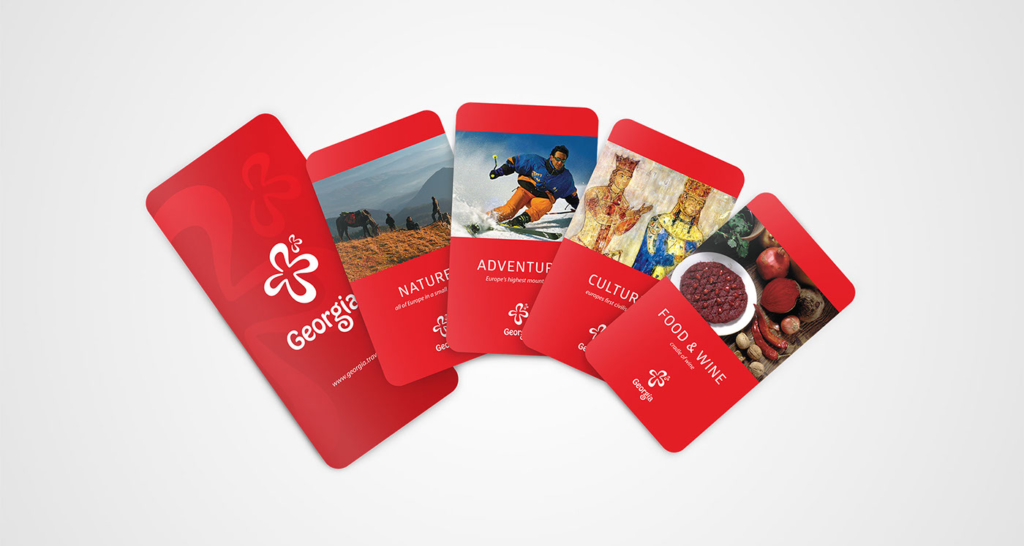
The Georgian National Tourism Agency (GNTA) took the initiative to create a tourism brand for Georgia. In this way, it wanted to ensure sustainable tourism development and increase the recognition of Georgia as a unique tourist destination. The national branding was created in collaboration with the creative agency Topuria Design.
“Georgia is one of the most unique tourist destinations in the world. We aim to help tourists discover the country's potential, diversity and richness. They, in turn, after looking at our tourism brand and Georgian national flavour, should want to return to the country once again,” GNTA admitted.
Azerbaijan: Take Another Look
Azerbaijan unveiled a new identity for the country in the fall of 2018. When creating it, the Azerbaijan Tourism Board was inspired by the phrase: “Take another look”, motivating international tourists to immerse themselves in the unique stories and secrets of the country. The country's national image was developed by the creative agency Landor.
In this brand concept, the designers combined two forms and transformed them into a central symbol – the first letter of the country's name, “a”. The logo resembles a “lens”, which offers a new look at Azerbaijan. There were mixed reactions to the tourism brand. Many people accused the creators of plagiarising Mastercard.
The story of Armenia's logo for $400,000 became one of the most discussed topics of the summer of 2016. Then, Vazgen Kalajyan, executive director of the American advertising agency GK Brand Tribe Globa, posted the process of working on Armenia's visual identity on his LinkedIn page. The concept caused a storm of indignation among the public: people felt that the brand “has nothing to do with Armenia and Armenians at all” and does not correspond to the country's culture, history and values.
The “Eternal Sun” logo is an opening flower, which, according to the authors, symbolises the contribution of Armenians to the scientific, artistic and business spheres. “Like the sun's rays, the flower's petals diverge, recreating the shape of the symbol of Armenia's eternity. The flower petals are coloured in red, blue and orange, similar to the colours of the Armenian flag,” the designers wrote.
Uzbekistan: Naturally Irresistible
Uzbekistan's Intellectual Property Agency approved Uzbekistan's tourism logo in 2014. The Uzbek National Tourism Company Uzbektourism designed it. The country's national slogan is “Naturally irresistible”.
The Uzbekistan logo contains the inscription “Uzbekistan” in a free font. As in the case of Poland, the mountains and domes on the logo are drawn only symbolically and convey culture, landmarks, and national colours. The colour scheme was chosen following the country's flag: blue, red, green.
What does branding for the travel business mean?
For a travel company, branding means creating, developing and disseminating a set of values to distinguish itself from the competition and position itself in the minds of consumers. It means communicating all aspects of a company or a specific product.
Branding is a marketing technique , but it is not marketing!
You communicate marketing to the market about your travel business, products, or services. On the other hand, branding is what your consumers say about you and your products.
Branding is not a short-term strategy but a medium- to long-term strategy. Investing in branding allows you to reap the benefits of your efforts over time. A brand can evolve according to market demand or consumer needs, wants or desires.
Why should a travel agency do branding?
Some people say that small online travel agencies can do without branding. Nothing could be more wrong! This belief is partly dictated by the fact that the branding process needs to be managed, and travel agencies often cannot afford the cost of a brand manager. Many travel business owners associate branding with quality or customer satisfaction. This is partly true, but these are only the results of branding. Branding today is no longer a trend-driven choice but also a necessity to stand out in the online tourism market.
Therefore, to the question of whether a travel agency should do branding, the answer is yes, for the following reasons:
- Distinguishes from competitors
- Increases corporate value
- It serves to create a perception in the tourist
- Increases brand awareness in the tourism market
- Generates consumer trust
- Builds customer loyalty
Let's now discuss an example of successful branding.
Bookatrekking – example of a successful branding
Bookatrekking stands as a stellar example of successful branding in adventure travel. With an extensive portfolio of hiking trips to over 60 destinations, the company has strategically crafted a detailed and effective branding strategy that consistently elevates its brand awareness.
One key element of Bookatrekking's successful branding is its ability to convey a strong and cohesive identity across various touchpoints. From its website and promotional materials to social media channels , the company maintains a consistent visual language, logo, and messaging that instantly resonates with its target audience. This uniformity creates a memorable and recognisable brand image.
The company's commitment to customer experience and quality is also reflected in its branding. Positive reviews, testimonials, and captivating visuals from actual trekking experiences like Tre Cime di Lavaredo Hike contribute to building trust and credibility. Bookatrekking effectively communicates its core values and commitment to providing exceptional adventure experiences, fostering a connection with its audience.
Furthermore, Bookatrekking's branding extends beyond the trips themselves. The company has invested in marketing campaigns, partnerships, and community engagement initiatives, reinforcing its presence in the adventure travel niche. This multifaceted approach ensures the brand remains top-of-mind for individuals seeking trekking adventures.
This team leverages social media platforms, content marketing, and online communities to engage with its audience. Using captivating visuals, compelling storytelling, and interactive content helps create a sense of community and encourages user-generated content, amplifying its reach and impact.
By maintaining a well-defined and consistent brand presence , Bookatrekking has positioned itself as a trusted and reputable choice for hiking enthusiasts. The company's ability to convey its unique selling propositions, coupled with a solid online presence, has contributed to the continuous growth of its brand awareness and success in the competitive adventure travel industry.
How do you create a branding strategy for online travel agencies?
When people talk about strategy or strategic actions, they always think of something overly complex that will take a lot of time and resources to define. Hence, they tend to avoid anything resembling a strategy. But strategy is fundamental to determining the tactical actions that enable you to achieve specific marketing and corporate objectives.
If you have never created a branding strategy or want to understand how to make one from scratch, you must first know who you are addressing and your competitors.
Who is your brand for?
You must define every aspect of your target buyer and create a fictitious representation of your ideal customer. You must understand their problems, anxieties, fears, desires or needs, what makes them happy, and how you can help them. In short, it represents how you define everything about your consumer. It is good to remember that since it is a fictitious representation, you have to update it according to the actual characteristics of the buyer personas.
Answer the following questions:
- Who do you want to sell to?
- Who are your consumers?
- What needs or requirements do they have?
- Who are your buyer personas?
Great, move on.
Identify competitor brands
Who is fighting against you for a place in the minds of consumers? Knowing your opponents' brands is indispensable when defining a strategy. What do competitor brands position themselves for?
- High quality or low quality?
- High cost or low cost?
- High quality and low cost?
- Low quality and low cost?
- High quality and high cost?
- High cost and low quality?
It is strategic to understand precisely where a competing brand is to implement a diversification strategy. For this purpose, you need to analyse who your current competitors are in the present and who they might be in the future and examine:
- Brand purpose
- Strengths and weaknesses
- Elements of equality
- Elements of difference
- Value proposition
- Products Offered
- Brand colours
Identify the foundation principles of the brand.
What are the principles that led to the creation and development of the brand? On what pillars does the brand rest? What are the core beliefs? Answer the following questions.
Brand purpose:
- Why do you exist?
Brand vision:
- How do you see the brand in the future?
- Where do you want to go?
- What future do you want to build?
Brand mission:
- How can you realise your vision?
- What are you currently doing?
Value of brand:
- What are the principles and values that guide the company's activities?
- What values do you intend to promote?
Define brand essence
Brand essence serves to express who you are as an entity. To do branding in tourism, especially for online travel agencies, you must understand who you are and how you communicate this to the market. Remember that a brand is an intangible attribute that distinguishes you from others and helps create a perception of the potential customer. Therefore, you must understand who you are and how to talk about you.
- What adjectives would you use to define yourself if you were a brand?
- What are your human characteristics? Make a list of 3-4 adjectives that describe your personality.
- What brand do your potential customers want?
- How do you want to be seen and perceived as a brand?
- What elements would make a potential customer choose you and not your competitor?
Branding involves attracting people's attention, making them feel comfortable, conveying your personality, and communicating through your voice. Tone of voice is one of the branding elements that allows you to reinforce your communication messages and persuade the customer through emotion. It is also one of the most complex elements in its definition because a brand must be able to communicate to the customer in different ways depending on the situation.
For example, the tone of voice of a travel agency brand can be refined and elegant when it comes to conveying emotion but also confident when it comes to booking or purchasing a trip. An appropriate tone of voice can enhance a brand's memorability , depending on the context.
To define it, you always have to resort to an internal analysis:
- How do you want people to feel when they interact with you?
- What adjectives describe the brand?
- How can you differentiate yourself from the competition?
- How would you like to talk about the brand? In what language?
Create the brand message.
How can you convey a message, communicate your value and differentiate yourself from the crowd? To do this, you need to identify an online travel agency's unique value proposition first and second a tagline that identifies you. These are the two brand communication elements when referring to your message. Your value proposition positions you in people's minds for something you do better than your competitors and also answers why a consumer should choose you.
The tagline or slogan is an element of a brand's visual identity and reinforces the brand identity . Creating slogans for tourism is essential if you want to emphasise your company's value and communicate it clearly and simply to your audience. Every self-respecting tourism and non-tourism brand should have a strong tagline that people readily understand. However, some companies in the tourism sector do not do this because they manage to communicate the strength of their brand simply and authentically.
This is the case with Booking.com, which has no tagline in its brand because it does not need to communicate its values. Calling up the booking brand, what comes to mind? Probably:
- Best price guarantee
- Free cancellation
- 24-hour assistance
In 2019, Booking.com created a promotional campaign to launch the brand in the US and adopted a simple but distinctive message, “Be a booker”, to stimulate people to get in touch with the brand.

Define brand identity
A brand identity is the set of visual and stylistic elements that make a brand memorable and associated with a product or service. It represents the first point of contact between people and a company from a visual point of view. A brand identity is distinguished by its logo, tagline or slogan , font and colour palette.
Although it sounds easy, designing a brand's visual identity is complicated. Often, when starting a travel and tourism business, the mistake is to immediately create a graphic representation by creating the brand. But to make it optimal, you must be aware of each of the previous steps. If you are unaware of why you exist, what you do for the market and your values, how can you represent them graphically?
Depending on your values and vision, you must also choose the colours that best represent you because even colours, on a psychological level, communicate certain aspects of a company. When developing a brand identity, nothing must be left to chance because each element has a communicative value for customers.
Travel & tourism sector branding takes time and resources. It is a process that begins with a profound understanding of the people it addresses. However, designing and developing a brand allows both country (destination) and travel businesses to differentiate from the competition, communicate values and culture, and increase prestige and authority.
What role does branding play in the travel & tourism sector in 2024?
In 2024, branding is more crucial than ever in the travel & tourism sector as it is a powerful tool to differentiate destinations, create unique experiences, and build trust among travellers. Effective branding helps destinations and businesses stand out in a crowded market and influences consumer perceptions.
How can a destination establish a strong brand identity in the competitive travel & tourism landscape?
Establishing a solid brand identity involves comprehensively understanding the destination's unique selling points, cultural nuances, and target audience preferences. Successful branding requires a combination of digital marketing strategies, sustainability initiatives, and personalised experiences to create a memorable and positive image in the minds of travellers.
What impact does technology have on branding strategies for travel & tourism?
Technology is a game-changer in the Travel & Tourism sector's branding landscape. From virtual reality experiences to social media engagement, technology allows destinations and businesses to connect innovatively with their audience. Integrating AI for personalised recommendations, mobile apps, and seamless online experiences is crucial to effective branding in this tech-driven era.
How can sustainability be integrated into the branding of travel & tourism businesses?
Sustainability is a critical focus in 2024, and travellers increasingly value environmentally conscious practices. Brands in this sector can incorporate sustainability into their identity by adopting eco-friendly initiatives, promoting responsible tourism, and communicating their commitment to environmental stewardship. This approach attracts environmentally conscious travellers and aligns with global trends in responsible travel.
In the age of social media, how can travel & tourism businesses leverage platforms for effective branding in 2024?
Social media remains a powerful tool for branding in 2024. Travel & tourism businesses can leverage platforms like Instagram, TikTok, and X to showcase visually appealing content, engage with their audience, and create a community around their brand. User-generated content, influencer collaborations, and real-time updates are essential strategies to stay relevant and connect with the digital-savvy traveller.
Author Bio: Conrad is a professional blogger, content maker, and freelance writer. He has written many excellent and valuable posts on a variety of topics. Conrad loves outdoor activities. He believes the fresh air brings him inspiration for new ideas. You can reach him out through gu***************@gm***.com .
Stuart Crawford
Need help building your brand.
Let’s talk about your logo, branding or web development project today! Get in touch for a free quote.
Leave a Comment Cancel reply
Trusted by businesses worldwide to create impactful and memorable brands.
At Inkbot Design, we understand the importance of brand identity in today's competitive marketplace. With our team of experienced designers and marketing professionals, we are dedicated to creating custom solutions that elevate your brand and leave a lasting impression on your target audience.
Effortless booking
Maximize online conversions with the most intuitive checkout online.
Expand revenue with our powerful Automated E-commerce tools.
Upgrade your website to industry’s best. Fresh websites. Fresh revenue.
Amplify visibility and expand earnings with integrated OTAs and local partners.
Streamline check-ins, limit risk, and amplify customer data with built-in digital waivers.
Transform data into insights. X-ray reporting gives you customer and business intelligence.
Manage high-volume walk-up customers effortlessly with POS, ticketing, and gated entry.
Automate management of staff schedules, assignments, and staff communications
Control your business precisely the way you want with endless yet easy configurability.
Allocate equipment used in various products. Prevent overbookings and maximize profits.
Grow with Xola in our constantly expanding universe of integrations and apps.
Harness customer data to drive marketing campaigns and generate repeat business.
Transform your guests into passionate brand advocates. Perfect your products & services.
Manage your business with the most powerful mobile suite in the industry.
Perfect the guest experience by giving your staff the industry’s most intuitive software.
Efficiently manage guest flow, minimize wait times, and ensure maximum satisfaction.
Ticketing & Entry
Revolutionize your guest experience: Effortless check-ins, interactive displays, secure payments.
Boost revenue with automated rave reviews, actionable insights, and loyal customer engagement.
Efficient ticketing, digital waivers, and fast check-ins enhance on-site operations and guest satisfaction.
Explore Xola Universe: 80+ apps, limitless integrations, endless growth opportunities.
Simplify check-in and boost your marketing efforts with our integrated automated digital waivers.
With SOC 2 Type II and CCPA compliance Xola exceeds industry security standards and insures your data protection.
Access real-time insights for business growth with our powerful reporting.
Remarkable and hassle-free guest experiences with waitlist and virtual queuing.
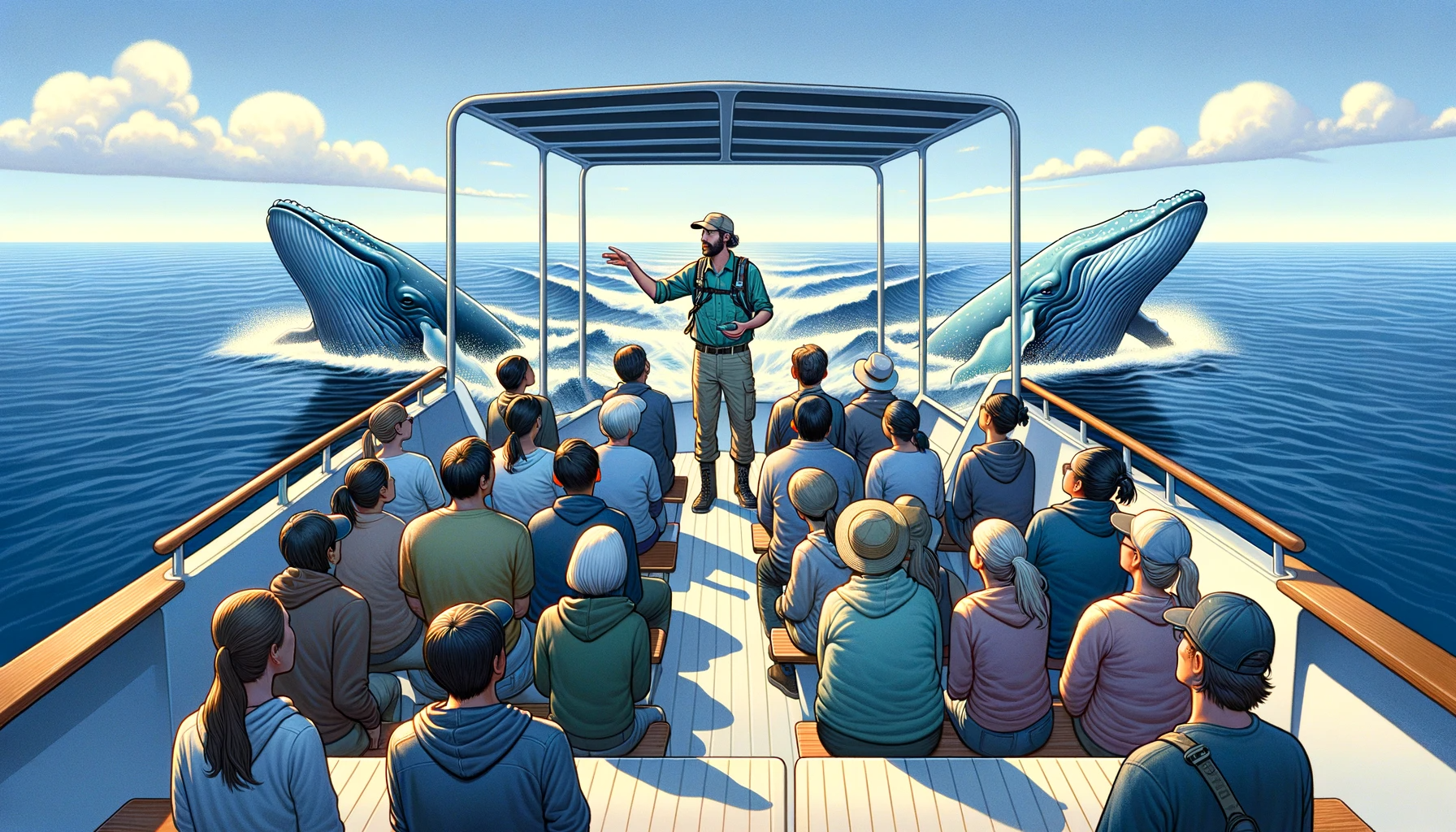
7 Skills That All Great Tour Guides Possess
- Xola University
7 marketing examples of great travel and tour brands

Odds are there’s more than one tour company competing for your customers’ attention — superior travel branding is a way to win them over.
Every tourism business knows there’s power in branding. As a tour operator, everything from the colors and fonts you use on your website to the way you conduct your tours becomes a part of your brand.
Good branding gives your travel company a personality and makes it easier for you to establish a relationship with your guests.
In this post, we’ll discuss seven travel companies that are pros at branding, plus tips on how you can use your brand to grow your business .
7 ways to grow your travel business through branding
A travel brand is made up of a series of components: company name , logo, website, mission statement, tone of voice, color scheme, etc. When these components are in sync, they make it easier for your customers to identify and connect with your tourism business.
When you solidify your brand, it becomes easier to create a cohesive marketing strategy. Your brand identity should be present in all marketing campaigns; in turn, you’ll see better conversion rates across your channels.
We’ll share key learnings from how seven major players in the travel industry leveraged the power of branding to exponentially grow their business.
1. Keep your travel branding consistent like Airbnb
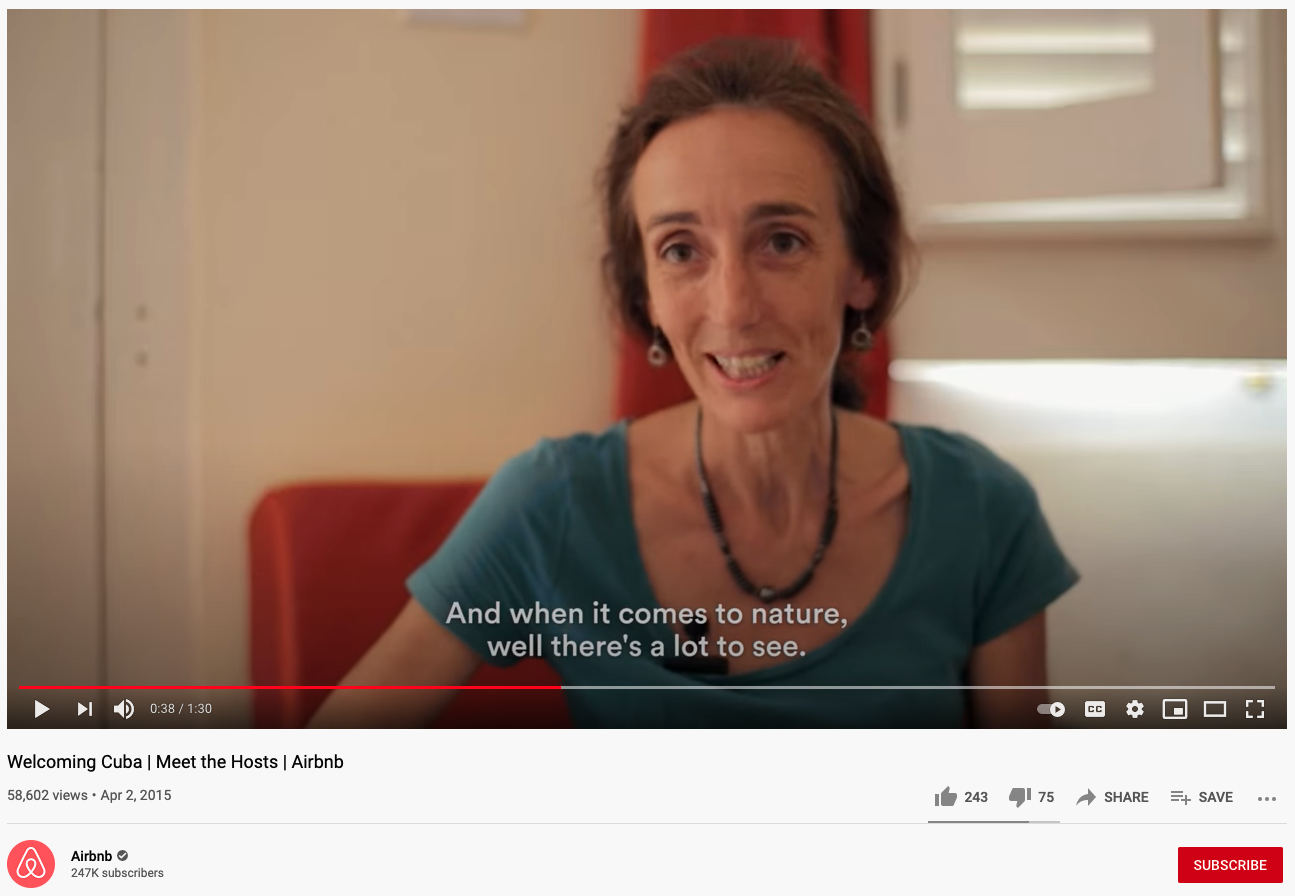
Airbnb is a brand that positions itself as more than just an accommodation option.
It doesn’t aim to compete with your typical luxury hotel; it instead appeals to the culturally curious by promising them a more authentic experience. And the company enforces this brand image across all of its platforms.
The service itself gives people a chance to stay with locals in their homes. Every additional feature the company offers, such as guidebooks and tours, is also led by locals. On Instagram, the company shares photos of unique properties and always ties them back to the host.
The brand consistently promotes the company’s overarching philosophy that interacting with the people who live in a place leads to authentic travel experiences.
What can tour operators learn from Airbnb?
Like Airbnb, tour operators should also ensure their brand image is equally represented across their online marketing platforms. As you’re building your website , remember that the brand you’re selling online should match the feel and voice seen on other platforms, such as your social media accounts.
Think of every customer interaction as a chance to introduce them to your company values and what makes your brand special.
2. Create a powerful logo like New York City
New York City gained its “I Love NY” logo in the 1970s when the city was deemed unsafe and unattractive for tourists. The new logo became the face of a big marketing campaign to bring visitors back to the city.
Today, we know that NYC’s logo is one of the most recognized around the world. You see it on souvenir T-shirts and mugs sold in and outside the city. It’s an iconic symbol that will forever be associated with the positives of traveling there.
This is all to say that a recognizable logo can attract new customers.
What can tour operators learn from NYC?
Aesthetics play a key role in branding. You want customers not only to remember your name but also to recognize your logo.
An effective logo helps make your tour company easy to spot both on and offline. It’s a way for guests to instantly recognize your company no matter what platform they’re on.
3. Engage users through storytelling like National Geographic
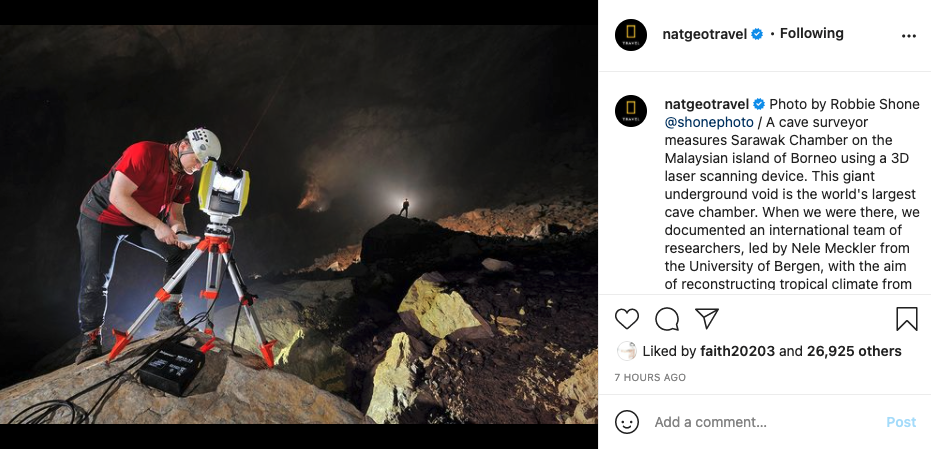
National Geographic has built an outstanding outdoor exploration brand through professional photography and storytelling. More significantly, the media company found a way to differentiate itself from other travel accounts on Instagram specifically — because, let’s face it, there are loads of them.
Instead of just identifying a photo’s location, Nat Geo Travel often features the photographer’s first-hand experience or a traveler reminiscing on that moment in the captions.
It’s a strategy that makes the massive account of nearly 43 million followers feel more personable. The captions show that there are real people behind the photos, making it easier for people to connect with them.
What can tour operators learn from Nat Geo Travel?
Social media is a great place to play around with storytelling.
You can share user-generated content and guest’s firsthand experiences in your captions or even share behind-the-scenes aspects of running a local tour business. The more personable your brand is, the easier it is for your guests to relate to it.
Keep this in mind when you’re writing your tour descriptions , too. Use descriptive language to paint a scene for your guests — whether it’s the aroma of sizzling garlic during a cooking class or the crystal clear water during a snorkeling tour.
4. Learn from Expedia’s user experience
Expedia is a trusted travel brand because it takes the hassle out of booking a trip. People can book hotels, flights, and car rentals on one single platform, which then stores all the information for them.
Expedia’s brand is based on the idea that a stressful process can be simplified. The company upholds this ethos throughout its website, using eye-catching images and social proof in the form of guest reviews to assist guests in their research process.
The brand wants to be seen as a trusted travel partner for post-pandemic travelers, or “a brand that is there for travelers from start to finish,” company exec Shiv Singh recently said .
What can tour operators learn from Expedia?
User experience is just as much part of your brand as your logo. Think about the process of booking tours on your website and whether that matches your brand identity. Is it seamless? Is it intuitive? Is it easy for guests to communicate with you? How is the process impacting your brand identity? After answering these questions, you can start brainstorming ways to optimize your site to drive more bookings .
5. Stay true to your brand like Southwest Air Lines.
Southwest Air Lines has successfully built a cult brand that counts on a band of loyal flyers across the U.S. The airline is known for exceptional customer service, kind flight attendants, and quirky characteristics like colorful airplanes and no assigned seating.
Much of the brand’s identity can be credited to its company culture. Southwest prides itself in putting its employees and customers first, and much of its brand messaging focuses on those values.
Most importantly, the airline delivers. The company tries to reinforce its brand with every interaction. What makes Southwest such a successful brand is that its advertising and marketing are all true.
What can tour operators learn from Southwest?
Southwest is an example of how company culture can influence a brand image. If your company has a fun and engaging brand, make sure to hire tour guides that promote that image. The airline stays true to its values and principles, and tour operators should do the same.
6. Build a reputation like Tripadvisor
The Tripadvisor brand has become synonymous with travel research. The company is seen as a reliable source of travel information because it has curated a massive database of user-generated content, specifically reviews.
The brand is widely recognized as a barometer for quality, so much so that tour operators around the world ask guests to rate their experiences on Tripadvisor.
Tripadvisor rewards brands for getting reviews in competitions like “Travelers’ Choice,” which highlights top-rated destinations, hotels, restaurants, experiences, and more.
What can tour operators learn from Tripadvisor?
Leverage user-generated content to promote your reputation and build a brand that consumers trust. You can do so by displaying testimonials on your website, asking guests to review your experiences, and growing your social media following.
7. Appeal to your niche audience like World Nomads
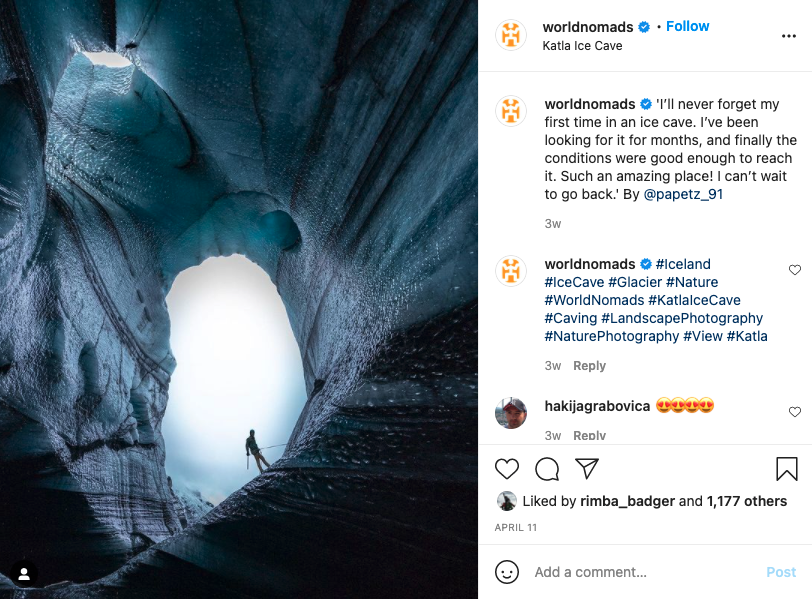
If you looked at the World Nomads Instagram page, you probably wouldn’t guess it belongs to a travel insurance company.
Travel insurance isn’t necessarily the most exciting industry, but World Nomads has spun a lively and engaging brand online. It bills itself as not just a “travel insurer,” but an “adventurous lifestyle brand.”
Rather than appealing to everyone, the brand directly targets an audience it knows will use its services: adventure travelers . It promotes this brand identity on Instagram by sharing photos of scenic landscapes around the world, and on its website, where there’s an entire section dedicated to adventure travel stories.
The company even has a scholarship program for aspiring travel photographers, filmmakers, and writers to further connect with its audience.
What can tour operators learn from World Nomads?
Tour operators can create engaging travel content on their websites and social accounts to appeal to their target audience. Rather than creating a brand that appeals to just anyone, you can focus on a content plan that specifically speaks to your ideal guest.
You should also consider what channels your target audience is using to reach you. If your niche is millennial adventure travelers, they’re more than likely booking travel on their phones. In that case, it’s especially important that your website be optimized for mobile .
The key takeaway? You don’t have to be a massive company to develop a good travel brand, but it sure helps to learn from them.
Feel free to refer back to this post for pro-level travel branding techniques as you work on nailing down your own.
Writer Carla Vianna
Related Articles

How to set up email tracking in GA4
Keeping in touch with past, present, and future guests via email brings you closer together. It also gives you an

A detailed guide to GA4 paid ad tracking for tours and attractions
The success of your paid ad campaigns lies in the ability to measure and analyze relevant KPIs — like ad

What is experiential marketing: Definition, why it works & examples
Experiential marketing campaigns are so effective in drawing in customers because people crave real-life experiences more than ever these days.
Get the latest news and resources.
For tours and attractions delivered straight to your inbox each week.
Transform your business now.


Branding for the Travel and Tourism Industry: Crafting Memorable Travel Experiences
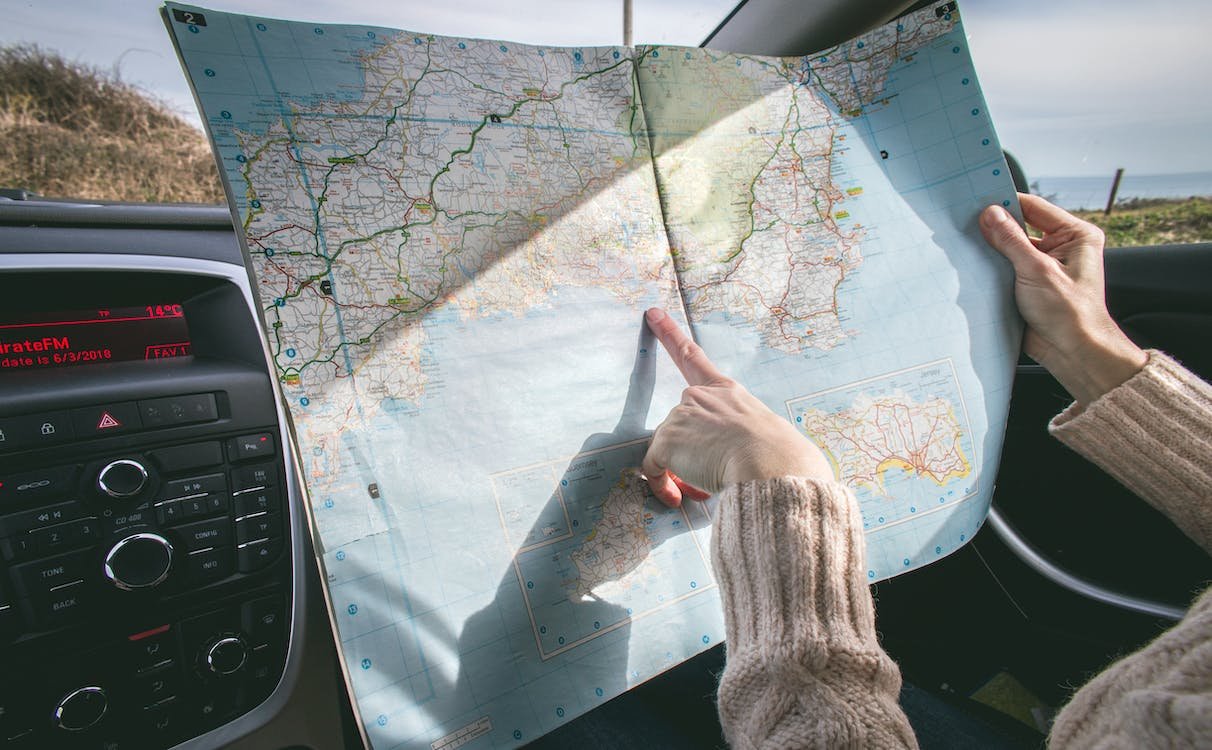
This Article has been revised, edited and added to, by Poulomi Chakraborty.
Why Branding Matters More Than Ever
Comparing two branding strategies: emotion vs. practicality, which approach wins, establishing a unique brand voice, visual identity: more than just a logo, consistency across all touchpoints, establishing a distinctive brand voice, developing a compelling visual identity, leveraging brand storytelling, consistency is key, innovating within brand guidelines, the power of storytelling on social media, engaging with your audience, using influencers to broaden reach, choosing the right platforms for your brand, creating engaging and shareable content, building relationships with influencers, utilizing social media for customer feedback and service, tracking metrics and adapting strategies, creating a seamless user experience, personalization: the key to customer delight, rewarding loyalty, the role of high-quality content, seo optimization: being found is fundamental, sharing customer stories, utilizing data analytics for targeted marketing, email marketing: personalization at scale, the power of retargeting campaigns, integrating video marketing, maximizing social media platforms, leveraging user-generated content, understanding the impact of online reviews, proactive communication with guests, leveraging positive reviews in marketing, handling negative feedback constructively, encouraging review diversity, regular monitoring and analysis.
In the bustling world of travel and tourism, creating a standout brand isn’t just about being seen—it’s about being remembered. As travel destinations and experiences become more accessible, the challenge isn’t just to attract tourists but to create memorable experiences that echo long after the trip ends. This article explores how brands in the travel and tourism sector can craft such unforgettable experiences, ensuring they capture the hearts and minds of travelers everywhere.
The Essence of Branding in Travel and Tourism
The travel and tourism industry is inundated with options. From exotic beach resorts to adventurous mountain retreats, the choices are limitless. In this ocean of possibilities, how does one destination or travel service stand out from another? The answer lies in effective branding.
Branding in travel isn’t just about a logo or a catchy slogan; it’s the emotional response a company elicits from its customers. It’s what travelers recall when they think back to their journey and what prompts them to return or recommend the experience to others.
Let’s explore two different approaches to branding in the travel industry: emotional branding and practical branding. Each has its merits and can be the key to unlocking profound connections with travelers, but they cater to distinctly different aspects of the traveler’s psyche.
Emotional Branding: Tapping Into the Traveler’s Heart
Emotional branding focuses on creating a story that travelers can relate to on a personal level. It’s about building a narrative that resonates with the emotional desires and aspirations of the traveler.
For instance, consider a boutique hotel that markets itself not just as a place to stay but as a sanctuary where every room offers a unique story, where each meal is a culinary journey, and where the overall experience promises to rejuvenate both body and soul.
This type of branding seeks to create a deep emotional impact. It’s about making the traveler feel special, understood, and cared for. Emotional branding can be seen in campaigns that use powerful imagery, compelling stories, and evocative language that aim to make the heart soar and the spirit wander.
Practical Branding: Addressing the Traveler’s Mind
On the other hand, practical branding focuses on the usability, convenience, and functional aspects of the travel experience. This approach is about straightforward communication and the promise of satisfaction through excellent service and value for money. Consider an airline that highlights its on-time performance, generous luggage policies, and attractive frequent flyer programs.
Practical branding appeals to the rational side of consumers. It’s about providing clear, tangible benefits that make the decision-making process easier for travelers. This method involves direct messages that detail the advantages of choosing one service over another, focusing on aspects like affordability, accessibility, and convenience.
Both branding strategies have their place in the travel and tourism industry, and often, the most successful brands find a way to integrate both emotional and practical elements.
The key is to understand your target audience deeply and determine what drives their travel decisions. Are they looking for an escape, an adventure, a story to tell? Or are they more concerned with convenience, budget, and the specifics of the service?
Emotional branding tends to create more profound, lasting relationships with customers, leading to higher brand loyalty and word-of-mouth marketing. Practical branding, while perhaps less glamorous, builds trust through reliability and consistency, which are also crucial in securing repeat business.
Crafting a Unique Brand Identity
A distinctive brand voice is crucial in the crowded travel industry. It helps potential travelers instantly recognize your brand across various platforms—whether on social media, in advertising, or in email campaigns.
This voice should reflect your brand’s personality. Is it adventurous and daring, luxurious and elite, or perhaps eco-friendly and conscious? Once you decide, every piece of content you create should resonate with this tone.
Consider a travel agency that specializes in eco-tours. Their brand voice might be informative, focused on sustainability and nature conservation, and passionate about responsible travel. This consistent voice not only informs but also connects emotionally with like-minded travelers who value environmental consciousness.
Your visual identity, including your logo, color scheme, typography, and imagery, should convey your brand’s ethos at a glance. A well-designed visual identity makes your brand more recognizable and enhances the overall aesthetic of your promotional materials, which in turn, can make them more appealing to your target audience.
For instance, a luxury cruise line might use clean, elegant lines in their logo, a sophisticated navy blue and gold color palette, and high-quality images that showcase the opulence of their offerings. This visual consistency ensures that whenever potential customers see their materials, the luxury aspect of the brand is immediately apparent.
Consistency is key in branding. Every touchpoint, from your website to your booking process, from customer service to the way you handle complaints, should reflect your brand identity. This consistency builds trust and helps customers form a clear expectation of what their experience with your brand will be like.
A family resort might focus on being welcoming and fun, featuring kid-friendly content and imagery, offering easy booking options, and providing impeccable on-site services that cater to both children and adults. This cohesive approach reassures families that they are choosing a resort that truly understands and caters to their needs.
Creating a distinctive brand voice is fundamental for startup founders in the travel and tourism industry. This voice should not only reflect the core values and personality of the brand but also resonate with the specific desires and needs of the target audience.
To develop this voice, founders should engage in deep market research to understand the language, tones, and emotional triggers that best connect with their intended customers.
This could involve analyzing competitor communication, understanding cultural nuances of the target market, and identifying the unique value proposition that sets their offering apart.
Once defined, this brand voice should be consistently used across all marketing channels, reinforcing the brand’s identity and enhancing customer recognition.
A compelling visual identity goes beyond just a logo—it encompasses all visual aspects of a brand, including color schemes, typography, and imagery. Startup founders should ensure that their visual identity aligns with their brand voice and values, creating a cohesive and attractive brand image.
Choosing the right colors can evoke specific emotions and associations—blue can convey trust and stability, ideal for travel insurance companies, while vibrant colors like orange and yellow might be more suited to adventurous travel experiences.
Imagery should be carefully selected to tell the brand’s story effectively. High-quality, authentic images that showcase real experiences are more engaging than generic stock photos.
For instance, a startup focused on eco-tourism might use images that highlight nature, local communities, and sustainable travel practices, reinforcing their commitment to responsible tourism.
Storytelling is a powerful tool for startups to create an emotional connection with their audience. The brand story should encompass the origins of the company, the founders’ vision, and how it aims to transform the travel experience. Effective storytelling can transform abstract brand values into relatable narratives that captivate potential customers.
For travel startups, this might involve sharing the personal travel experiences that inspired the business, highlighting challenges in the industry that the company aims to address, and showcasing how customers’ lives are enriched by choosing their services. Sharing these stories through blog posts, videos, and social media can help build a community around the brand.
Consistency in brand identity is crucial, particularly for startups looking to establish their place in the market. This means maintaining a uniform appearance and tone across all platforms, from the website to social media, from email campaigns to physical marketing materials. Consistent branding not only aids in brand recognition but also builds credibility and trust with consumers.
Startups should create a brand style guide that details all elements of the brand identity, including logo usage, color palette, typography, and key messaging. This guide will ensure that any content created for the brand, whether in-house or outsourced, remains consistent with the brand’s core identity.
While consistency is crucial, it is also important for startups to stay flexible and innovate within their brand guidelines. As market dynamics change and new trends emerge, the brand identity may need to adapt to stay relevant and appealing.
Startup founders should regularly review and potentially refresh their branding to ensure it continues to resonate with their target audience without losing the core elements that define their brand.
Leveraging Social Media to Enhance Brand Presence
Social media is an invaluable tool for storytelling, allowing brands to narrate their identity and values in a dynamic, engaging way. Effective use of social media can transform casual viewers into engaged followers and eventually into guests.
For example, a regional tourism board could use Instagram to share hidden gems in the area, with each post telling a part of the region’s story, from historical landmarks to local festivals, creating a tapestry that invites travelers to experience the story themselves.
Engagement goes beyond posting regularly on social media. It involves interacting with your followers, responding to comments, and even engaging with other brands. This kind of active engagement can make potential customers feel valued and seen, increasing their likelihood of choosing your brand for their travel needs.
An adventure travel company, for instance, could use Facebook to run polls about potential new destinations, ask followers to share their travel stories, or create interactive maps where users can suggest places they want to visit. Such strategies not only keep the audience engaged but also provide invaluable insights into their preferences and expectations.
Influencers can be powerful allies in travel branding. They can introduce your brand to their followers, who might not have discovered it otherwise. Choosing the right influencers whose brand aligns with your values and whose audience matches your target demographic is crucial.
A boutique hotel might partner with travel bloggers who focus on luxury escapes or unique accommodations, leveraging their credibility and audience to enhance the hotel’s visibility and desirability.
When it comes to enhancing brand presence on social media, startup founders in the travel and tourism industry must carefully select which platforms align best with their target demographics and brand goals.
While Instagram and Pinterest are highly visual, ideal for showcasing stunning travel destinations, LinkedIn might be more suitable for B2B travel startups focusing on corporate clients.
Twitter, with its fast-paced nature, is excellent for real-time updates and customer service. Founders should focus their efforts on platforms where their target audience is most active and engaged, ensuring their social media strategies are not spread too thin across too many platforms.
The key to social media success is creating content that is not only engaging but also encourages shares and interactions. For travel brands, this could include breathtaking photography, fun and informative videos, and interactive content like polls or quizzes related to travel preferences.
Startups should also consider leveraging trending topics or hashtags to increase visibility and engagement. For example, participating in a popular travel challenge or creating a hashtag campaign around a unique travel experience can generate excitement and encourage user participation.
Influencers can serve as powerful partners in amplifying a travel brand’s presence on social media. Startups should look for influencers whose travel style or audience aligns with their brand values and offerings.
Instead of one-off campaigns, founders should strive to build long-term relationships with influencers, which can lead to more authentic and sustained engagement.
For instance, instead of simply sponsoring a post, travel brands could collaborate with influencers on exclusive travel packages or co-create content series that provide real value to the audience.
Social media is not just a platform for marketing; it’s also a powerful tool for customer service and feedback. Startups should actively monitor their social media channels for customer inquiries, complaints, and feedback, responding promptly and thoughtfully.
This interaction not only improves customer satisfaction but also boosts public perception of the brand as responsive and customer-focused. Additionally, social listening tools can be used to gather insights about customer preferences, emerging trends, and brand perception, which can inform future marketing strategies and product offerings.
To effectively leverage social media, startups must continuously track the right metrics to evaluate the success of their strategies. Metrics like engagement rate, click-through rate, and conversion rate can provide valuable insights into how well content is performing and whether it’s driving the desired outcomes.
Startups should use these insights to refine their social media strategies, experimenting with different types of content, posting schedules, and advertising campaigns to find what works best for their brand and audience.
Enhancing Customer Experience to Foster Brand Loyalty
In today’s digital age, the ease with which customers can interact with your travel brand online is often just as important as the physical experience. A seamless user experience on your website and mobile app can greatly enhance customer satisfaction and increase bookings. This includes intuitive navigation, fast loading times, responsive design, and clear, concise information.
For example, a cruise line might integrate an interactive deck plan on their website, allowing customers to virtually explore the ship, choose their cabin, and even book excursions before they board. This level of interactivity not only delights customers but also eases the process of planning their cruise, enhancing their overall experience.
Personalization is a powerful tool in building a strong travel brand. By tailoring experiences and communications to individual preferences, brands can make customers feel special and valued, which in turn boosts loyalty. This could mean offering personalized travel recommendations through a smart algorithm on your app or sending customized itinerary suggestions based on past bookings.
A luxury travel agency could use previous trip data to send personalized vacation reminders, like “It’s been a year since your last solo adventure. Here’s a curated list of serene destinations you might enjoy.”
Loyalty programs are another effective way to enhance customer retention and deepen brand loyalty. Offering points, perks, discounts, or exclusive experiences can encourage repeat business and turn satisfied customers into brand advocates.
A boutique hotel chain might offer a loyalty program where points can be redeemed not only for free stays but also for unique experiences like private dining with a local chef or guided tours of hidden local attractions.
Leveraging Content Marketing to Tell Your Brand’s Story
Content marketing is crucial for travel brands looking to establish a strong presence in the market. High-quality, engaging content can attract more visitors to your website, improve search engine rankings, and increase brand visibility.
This content can take many forms, such as blog posts, videos, podcasts, and infographics, each offering unique ways to capture the imagination of potential travelers.
For instance, a regional tourism board could create a video series showcasing local artisans, culinary traditions, and landscapes, providing a rich, engaging narrative that attracts tourists interested in authentic experiences.
Optimizing your content for search engines is a must. This means using the right keywords, ensuring your website’s structure is search engine friendly, and building quality backlinks. Effective SEO helps your brand appear higher in search results, making it more likely that potential travelers will find you when planning their next trip.
An adventure travel company might focus on keywords like “unique adventure vacations” or “eco-friendly adventure tours” to attract a specific audience interested in these themes.
There’s no better way to tell your brand’s story than through the voices of satisfied customers. Encouraging customers to share their experiences on your platforms not only provides social proof but also generates authentic content that can inspire others to book their travels with you.
A family-friendly resort could encourage guests to share their vacation photos on social media under a branded hashtag, offering a chance to win a return trip as an incentive. These real-life stories and images create a more relatable and compelling brand image.
In summary, enhancing the customer experience through seamless interactions, personalized services, and rewarding loyalty, coupled with a strong content marketing strategy that includes SEO optimization and customer stories, can significantly strengthen a travel brand’s presence in the market.
Advanced Digital Marketing Strategies for Travel Brands
In the digital age, data is king. By leveraging data analytics, travel brands can gain deep insights into customer behavior, preferences, and trends. This information can then be used to create highly targeted marketing campaigns that speak directly to the needs and desires of potential travelers.
For example, a hotel chain could analyze data from past bookings and online interactions to identify trends in the types of rooms or packages that are most popular during different seasons. Using this information, they can craft targeted promotions, such as winter wellness retreats or summer family packages, that are likely to resonate with their audience.
Email marketing remains one of the most effective digital marketing tools, especially when personalized. Segmenting your email list based on user behavior and preferences allows you to send tailored messages that are more likely to engage recipients.
A travel agency might segment their list into categories such as adventure travelers, luxury seekers, and budget vacationers. They can then send customized emails featuring blog posts, special offers, and destination tips that align with each group’s interests, significantly increasing the likelihood of engagement and conversion.
Retargeting is a powerful technique to bring back visitors who didn’t book on their first visit to your website. By displaying ads that remind them of the services or offers they viewed, you can increase brand recall and encourage them to complete their booking.
An adventure travel company could use retargeting ads to show exciting images or offer a limited-time discount to users who have visited their site and looked at specific tours but left without making a reservation. This strategy helps keep the brand top-of-mind and can effectively nudge potential customers back into the booking process.
Video marketing is incredibly effective in the travel industry due to its ability to convey experiences and emotions more vividly than text or images alone. Creating compelling video content that showcases breathtaking destinations, exciting adventures, or luxurious amenities can capture the imagination of potential travelers and drive engagement.
A city tourism board might create a series of short videos highlighting different attractions, such as culinary tours, historical sites, and nightlife. These videos can be used in various digital marketing campaigns, shared on social media, and embedded in emails to provide a dynamic view of what the city has to offer.
Different social media platforms cater to different demographics and offer unique ways to engage with potential travelers. For instance, Instagram is perfect for sharing stunning visual content, while Twitter is ideal for quick updates and customer service, and Facebook provides a platform for longer content and community building.
A beach resort might use Instagram to post beautiful sunrise and sunset photos, share guest photos on Facebook along with detailed stories about their experiences, and use Twitter for real-time weather updates and answering guest inquiries. By leveraging the strengths of each platform, travel brands can enhance their visibility and appeal to a broader audience.
Encouraging and sharing user-generated content (UGC) can significantly boost authenticity and trustworthiness. UGC, such as photos, reviews, and videos from travelers, provides prospective customers with peer perspectives that are often seen as more relatable and trustworthy than traditional advertising.
A ski resort, for example, could encourage visitors to share their experiences on social media under a specific hashtag, curating the best content to feature on their official channels. This not only provides fresh, authentic content but also engages the community and fosters a sense of belonging among past and future guests.
In summary, employing advanced digital marketing strategies like data-driven targeting, personalized email campaigns, retargeting, video marketing, optimized social media usage, and user-generated content can greatly enhance the effectiveness of online marketing efforts for travel brands.
Mastering Online Reputation Management for Travel Brands
In the travel industry, online reviews can make or break a business. Positive reviews can significantly boost bookings, while negative reviews can deter potential customers. Understanding how to manage these reviews—responding appropriately and leveraging the positive feedback—is crucial for maintaining a strong online reputation.
For example, a boutique hotel must actively monitor review platforms like TripAdvisor, Google Reviews, and Booking.com. By responding promptly and professionally to both positive and negative feedback, the hotel can demonstrate its commitment to customer satisfaction, potentially turning a negative review into a positive future booking.
Proactive communication is key to preventing issues from escalating to negative reviews. By addressing problems during a guest’s stay, you can often resolve them before they feel the need to post a negative review.
A resort might, for instance, send a mid-stay feedback request via email or through a mobile app, asking guests if everything is meeting their expectations. This not only gives guests the feeling that their comfort is a priority, but it also allows the resort to rectify any issues before the guests check out.
Positive reviews shouldn’t just be celebrated; they should be showcased. Featuring glowing testimonials on your website, in your social media posts, and in marketing emails can influence potential customers’ perceptions and decisions.
An adventure travel company could create a “Guest Stories” section on their website where they highlight detailed testimonials and photos from previous travelers who had memorable experiences. These stories not only serve as social proof but also help to humanize the brand and connect with potential customers on an emotional level.
No travel business is immune to receiving negative feedback. The key is to handle it constructively. When a negative review is posted, it’s important to respond quickly and empathetically, acknowledging the guest’s concerns and outlining steps to address the issue. This approach not only appeases the dissatisfied customer but also shows other potential customers that the brand cares about its guests.
For instance, if a guest complains about their hotel room being too noisy, the hotel management should respond publicly, apologizing for the inconvenience and offering a solution, such as a room change or a discount on a future stay. They might also explain any measures being taken to prevent similar issues in the future, such as soundproofing renovations.
Encouraging a diverse range of reviews can help potential customers get a well-rounded view of what to expect. This includes having reviews from different types of travelers (families, solo travelers, business visitors, etc.) on various platforms.
A city tour company could encourage every guest to leave a review by offering a small incentive, like a discount on future bookings or a free souvenir. By accumulating a broad spectrum of reviews, the company can demonstrate its appeal to a diverse clientele, enhancing its reputation across various demographic groups.
Regularly monitoring and analyzing online feedback is essential for continuous improvement and effective reputation management. By understanding common praises or complaints, travel brands can adapt their services to better meet their customers’ needs.
Using software tools that track mentions across social media, review platforms, and online forums can help a cruise line keep tabs on what guests are saying about their experiences in real time. This data can then be analyzed to identify trends, monitor the impact of changes made based on feedback, and refine marketing strategies.
In the vibrant realm of travel and tourism, branding transcends mere visibility; it’s about crafting enduring memories and experiences that resonate deeply with travelers. From establishing a compelling brand identity with a unique voice and visual consistency to leveraging advanced digital marketing strategies and mastering online reputation management, each step is critical in distinguishing a brand in this competitive market.
Engaging content, personalized interactions, and proactive reputation management are not just strategies but essential practices that forge lasting connections with travelers. By intricately weaving these elements together, travel brands can not only attract but also retain a loyal customer base, turning every journey into a story worth telling and a memory worth reliving. This approach ensures that a travel brand is not only seen but remembered and cherished, standing out in the global tourism tapestry as a beacon of unforgettable experiences.
- How to Dominate Google Rankings for Every Type of Loan Service
- Interactive Content Can Skyrocket Your Lead Capture. We Show How!
- How to Utilize Dynamic Content in Email Campaigns
- What is a SMART Plan? And, Why You Need One
- How AI LLMs will Revolutionize SEO (in 2023): Our Insights!
About The Author
Poulomi Chakraborty
Related posts.

The Importance of Community Engagement in Local Business Branding
This Article has been revised, edited and added to, by Poulomi Chakraborty. Community engagement goes beyond simple interaction with customers. For local businesses, it represents…
Read More »

Branding of Shoes: Walking the Path of Distinctive Footwear Identity
This Article has been revised, edited and added to, by Poulomi Chakraborty. In the dynamic world of fashion, where trends ebb and flow with the…

Branding in the Age of Social Media: Adapting to the Digital Conversation
This Article has been revised, edited and added to, by Poulomi Chakraborty. Welcome to the whirlwind world of branding in the digital age! Social media…

Branding for the Tech Industry: Building Trust in a Rapidly Evolving Landscape
Hey there! Welcome to our in-depth look at branding in the ever-shifting sands of the tech industry. You’re in for a treat, especially if you’re…

The Science and Art of Emotional Branding: Connecting with Customers on a Deeper Level
In the bustling bazaar of brands, a silent symphony plays—a melody woven with threads of emotions, echoing the subtle yet powerful dance of connections that…

Branding in the Age of AI and Automation: Adapting to the Future of Consumer Interactions
Welcome to the future of branding – where AI and automation are not just part of the landscape but crucial tools in shaping the dynamics…

Branding for Fitness Brands: Inspiring Health and Loyalty
This Article has been revised, edited and added to, by Poulomi Chakraborty. In the dynamic world of fitness, where new trends and innovations pop up…

The Power of Sound in Branding: Crafting Memorable Audio Brand Identities
This Article has been revised, edited and added to, by Poulomi Chakraborty. Imagine walking into a room and immediately recognizing a tune that takes you…
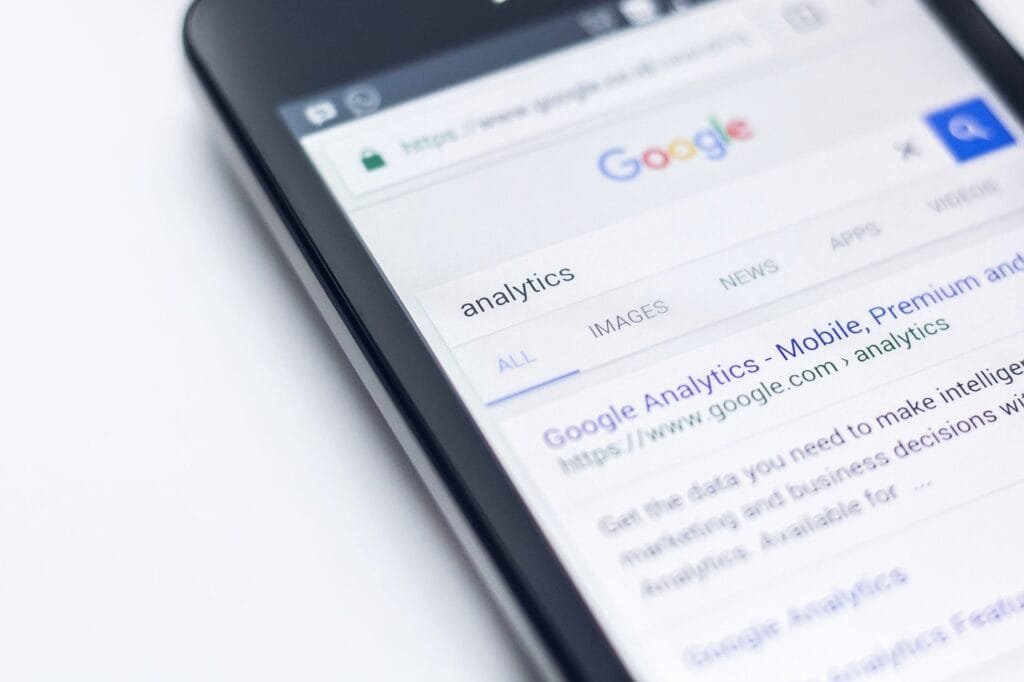
The Role of Data and Analytics in Branding: Making Informed Brand Decisions
This Article has been revised, edited and added to, by Poulomi Chakraborty. In today’s competitive market, the secret sauce to crafting a brand that resonates…

Branding for the Food and Beverage Industry: Crafting Delicious Brand Identities
In a world where every corner turned unfolds an array of culinary delights and every scroll on the smartphone reveals enticing images of sumptuous meals,…

The Role of Influencers in Branding: Leveraging Authentic Voices for Brand Promotion
In the dynamic world of branding, where consumer attention is as fleeting as the trends that captivate them, businesses are continuously seeking innovative ways to…

The Power of User-Generated Content in Branding: Authentic Engagement and Brand Advocacy
In a world driven by the digital echo, where brands jostle to echo their narrative amidst the cacophony, there lies a powerful but often overlooked…
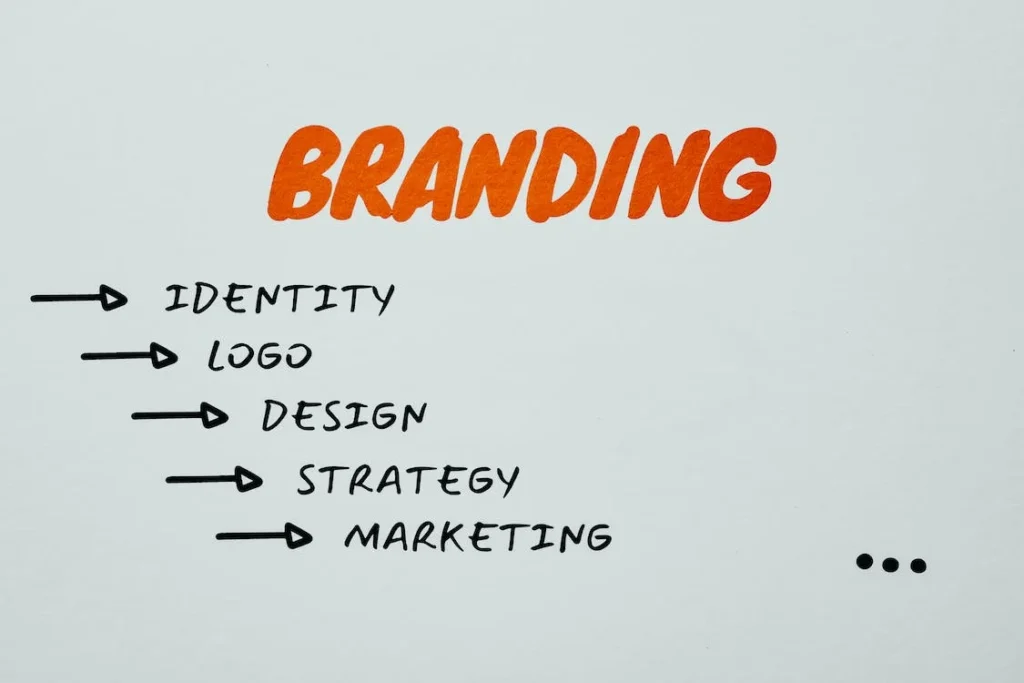
Branding for Subscription Services: Building Long-Term Loyalty
This Article has been revised, edited and added to, by Poulomi Chakraborty. In today’s digital age, the subscription service model has become a cornerstone for…

Branding for Startups: Laying the Foundation for Long-Term Success
So, you’ve finally taken the plunge. Your business idea, once a distant dream, has transformed into a tangible startup. As exciting as this entrepreneurial journey…
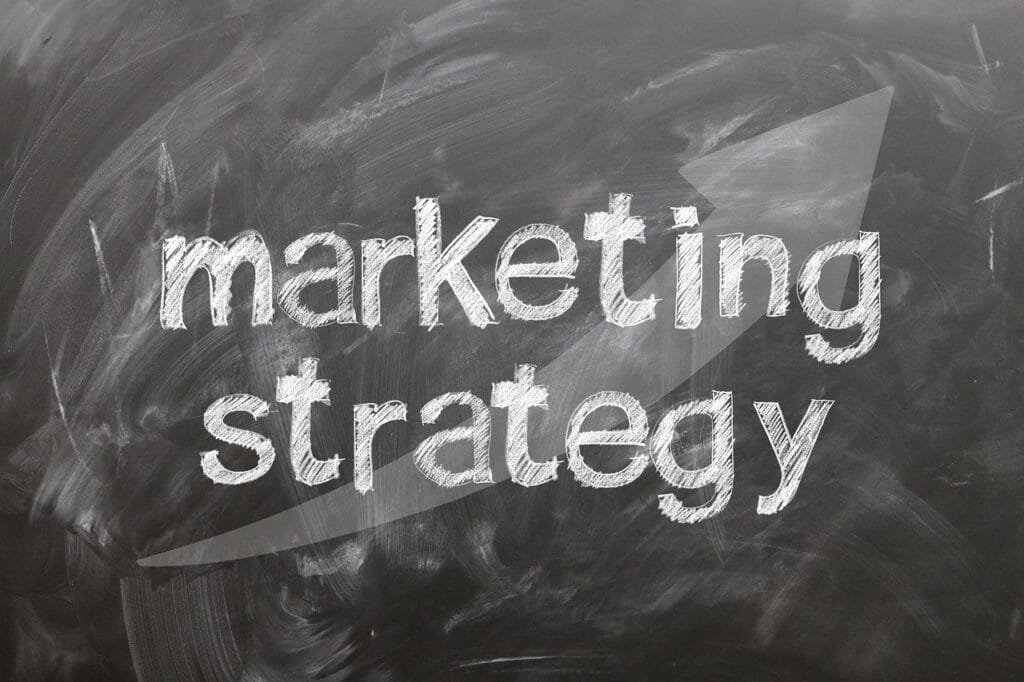
Tailor Branding: How Customization Elevates Brand Perception
This Article has been revised, edited and added to, by Poulomi Chakraborty. In a world where consumers are bombarded with countless choices, brands that stand…

Branding for Digital Products: Navigating the Intangible Landscape
This Article has been revised, edited and added to, by Poulomi Chakraborty. In a world dominated by the digital, where products are no longer tangible…
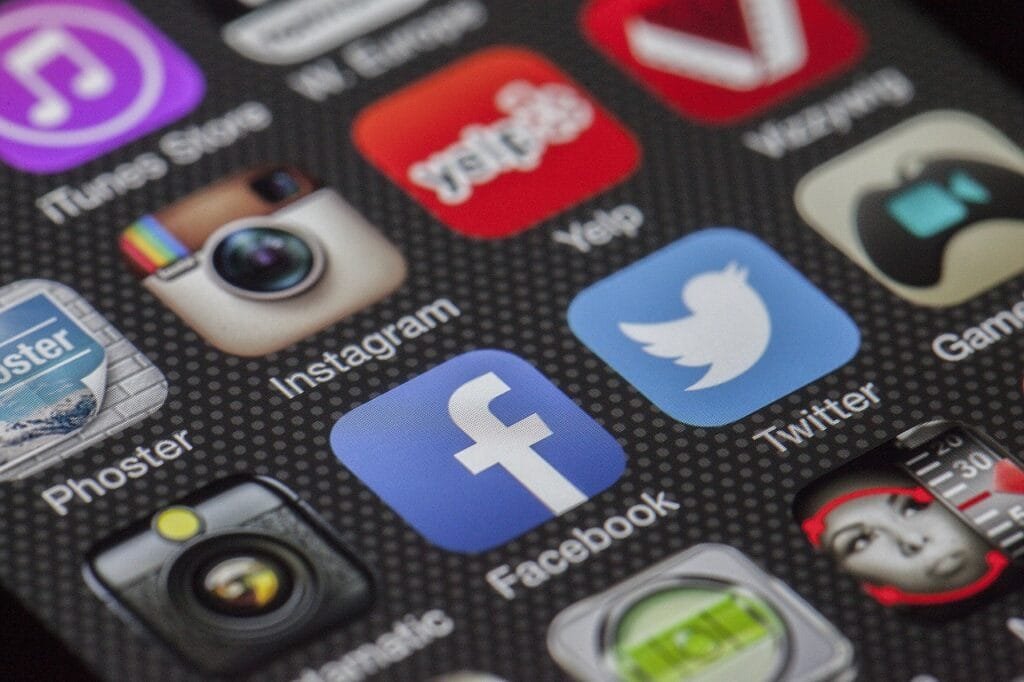
Branding for Mobile Apps: Standing Out in a Crowded Digital Landscape
This Article has been revised, edited and added to, by Poulomi Chakraborty. The digital age has brought with it an explosion of mobile apps. From…
Branding for E-commerce Platforms: Crafting Distinctive Online Shopping Experiences
This Article has been revised, edited and added to, by Poulomi Chakraborty. Welcome to the world of e-commerce branding, where your platform isn’t just a…

The Power of Personalization in Modern Branding: Crafting Tailored Brand Experiences
This Article has been revised, edited and added to, by Poulomi Chakraborty. In a world where consumers are bombarded with endless choices, personalization has emerged…

The Role of Influencers in Modern Branding: Leveraging Authentic Voices for Brand Promotion
This Article has been revised, edited and added to, by Poulomi Chakraborty. In the dynamic landscape of today’s marketing, the role of influencers has become…
The go-to guide to branding for travel and tourism

By Kevin Tjoe — 14 Mar 2022
destination marketing tourism branding
Updated March 2024 – Picture this: Your tourism guests from one year ago are standing at a barbeque, and in conversation, they happen to rave about the great experience they had with your company. When neighbor Bob asks who he should book with, will your business be remembered and recommended? This is the power of branding travel and tourism.
Whether you’re building your brand from scratch or wanting to refresh your existing business brand identity, read on for a clear guide to branding travel and tourism businesses.
The importance of branding in tourism
What is tourism branding, exactly? It can encompass the name, visual identity, tone of voice, experiences, brand values, and industry associations of your tourism organization. Branding can also have powerful benefits for your business. Some of these can include:
- Building recognition and familiarity for your business
- Helping your target audience to establish trust in your business
- Encouraging guests to find and rebook with you again
- Empowering you to scale and expand your business to other locations and markets.
So where do you begin as you’re developing a robust, memorable brand in tourism?
Essential elements for your tourism branding strategy
Whether your guests are booking through a reseller, directly on your website, or with a local agent, your brand needs to be unique and consistent. Here’s a tourism destination marketing strategy that can make that happen.
Finding the right brand name

It turns out, there’s a lot in a name. A catchy and unique brand name will increase your chances of recommendations and repeat bookings. This handy article dives into how to create the right name for your tourism brand. In short, aim to:
- Research competitor names
- Keep the brand name short and sharp
- Consider how easy the name will be to search for and find online
- Include the location within the name, and
- Trademark and protect your brand name.
Importantly, your brand name should also reflect the unique qualities and experiences your tour or activity business offers. Amaz’n Kayak Tours sounds fun and friendly, for example, while a name like Pinnacle Cruise Experiences exudes luxury and exclusivity.
Creating a strong visual identity through brand design
Every successful brand needs a strong visual identity and brand image, and it can be worth hiring professionals to help you with this process. Ideally, you’ll set up a ‘style guide’ to ensure consistent visual branding. This might typically include information on your:
- Logo Your logo, or graphic symbol, can be used across web, print, social media, reseller sites, and more. As with your brand name, your logo should reflect your tourism experiences and unique aspects of your business.
- Colors A consistent color palette used across your website, booking form , and other marketing collateral will help build recognition and familiarity. You might like to consider the colors of the landscapes in which you operate as a starting point when developing your brand color scheme.
- Imagery The photos you use to promote your tours or activities can matter a great deal when someone is weighing up whether to book. Focus on crisp, high-quality images taken on a sunny day; include the human side of your business, and be sure to capture happy guests with their permission. You might also plan to use a certain filter or color tint to ensure consistency across all images.
- Fonts and typography Fonts are more than just letters on a page; they are a reflection of your brand’s character and essence. When selecting fonts for your travel business, consider factors such as readability, versatility, and alignment with your brand’s personality. Whether you opt for classic serifs, modern sans-serifs, or playful scripts, ensure consistency across all communication channels to maintain brand cohesion.
Creating your brand story
Think about why your tour company exists: what made you start it and what you started with. Consider what makes your tours or activities special and what makes your team stand out. Think about what made you want to run tours, events, or activities in your local area, and what makes them exciting for you.
Answering these questions can help you form a compelling brand story, which can then be shared on your website, social media, and public platforms. A passionate brand story helps your target audience to form an emotional connection with your brand and makes for a far more meaningful tourism experience for guests.
Developing your brand voice

To develop your brand’s tone of voice, think about who your brand would be as a person. How would they talk? What are the quirks that make them likable? Your brand voice can be used across SEO web content , video content , booking steps, and any other marketing collateral where guests might interact with your brand.
For example, a surf lesson company might get on board with touches of laid-back surfy lingo in their automated emails. Or a company offering high-end, multi-day cruises might use more descriptive words to describe silky white sands and their indulgently soft pillows.
Syncing with your destination marketing
Tourism marketing can be unique in that you’re promoting your location as much as you’re marketing your products or services. Destination marketing , where you work with other operators to promote your location at a certain time, can be incredibly important. In fact, research from one accommodation association found that every $1 million invested into destination marketing could return around $16 million in ROI for the local economy. Destination branding is similar to destination marketing in tourism but focuses more on shaping the general perception of the location. Just consider the very different tourism experiences you’ve come to expect from London, Las Vegas, and Tokyo.
It’s important that your tourism marketing strategy aligns with destination marketing efforts for your area so that guests can build consistent and accurate expectations when booking. It can be really useful to network with other tourism operators and work with local agents , such as visitor information centers in your area. Invest in price monitoring software like Dealavo to better understand your price positioning and market dynamics.
Leveraging social media platforms for brand building
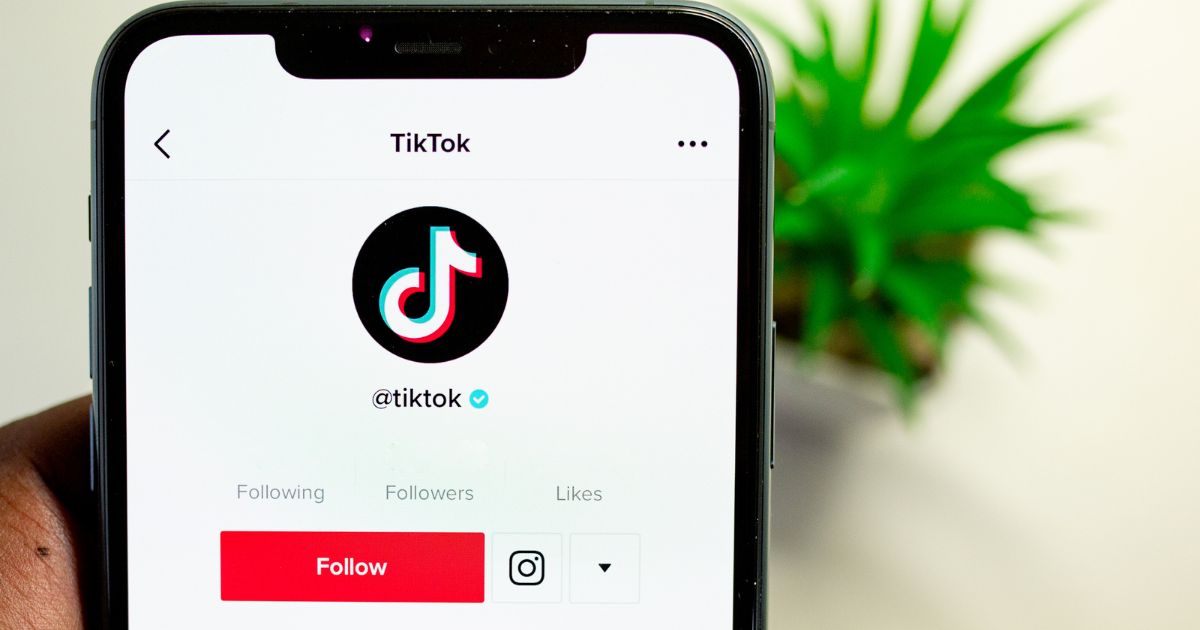
In today’s digital age, social media platforms play a crucial role in brand building for travel and tourism businesses. From Instagram to Facebook, Twitter to TikTok, these platforms offer unparalleled opportunities to showcase your travel experiences, engage with your audience, and amplify your brand message and marketing campaigns. In this modern tourism landscape, it’s important for tour operators to know how to harness the power of social media to create meaningful connections with their stakeholders and attract new customers.
Harnessing the power of testimonials and influencers
Testimonials and influencers can be powerful assets in building credibility and trust for your travel brand. Positive reviews from satisfied customers and endorsements from influential personalities can significantly impact the perception of your business and influence potential customers to book with your travel and tourism business. By exploring strategies for soliciting and leveraging testimonials, as well as collaborating with influencers you can amplify your strong brand reach and engagement.
Make a stellar start with your branding in tourism marketing
A strong, consistent brand can be one of your most valuable assets when running a tour and activity business. If you’re currently building your brand in the tourism industry, then Rezdy makes it simple to create a professional website, gain bookings via your network, and grow your reservations.
A reservation software like Rezdy equips your business with advanced tools such as real-time availability viewer, automatic guest communication, integration to various payment gateways, and further boosts automation within your business’ operations. Furthermore, Rezdy offers distribution solutions that connect you with the industry’s biggest resellers such as OTAs, local travel agencies, or even other tour and activity operators – so you can get your business out there. Rezdy Channel Manager is a distribution platform specifically catered for the tourism industry; connecting operators with access to over 25,000 active resellers worldwide.
Ready to build your brand with Rezdy? Book a free demo , or register for a FREE 21-day trial today.
If you enjoyed this article then make sure to follow the Rezdy blog . There are a lot of marketing tools and tour operator tips designed with businesses like yours in mind.
Start free trial
Enjoy 21 days to take a look around and see if we are a good fit for your business.
No obligations, no catches, no limits, nada
Marketing Basics

What’s new with Google Analytics 4? A guide for tour operators

How to get the most out of your blog as a tour operator

- Privacy Policy
Effective Segmentation Targeting and Positioning For A Travel Brand: 5 Steps
Last Updated on November 13, 2023 by The Digital Travel Expert
How I love this magic tool of segmentation targeting and positioning in marketing. Have you ever asked yourself why some travel brands beat you on the market and wondered which magic strategy they use? While there might be many ways for a brand to succeed, particularly in digital marketing, segmentation, targeting, and positioning (STP) are essential concepts in marketing that help a travel brand effectively reach and connect with its target audience.
Table of Contents
Why is segmentation targeting and positioning paramount to marketing?
Segmentation, targeting, and positioning are the cornerstone of a successful marketing strategy, providing a roadmap to connect with the right audience compellingly. Through segmentation, a brand identifies diverse consumer groups, allowing for tailored strategies that resonate with specific needs and preferences. For a travel SEO agency , this involves researching the right travel keywords and crafting relevant travel content.
Positioning, the final piece, creates a distinctive brand image, differentiating it from competitors and forming a lasting impression in the minds of consumers.
Here’s how the segmentation targeting and positioning concepts apply to a travel brand:
1. Segmentation: Definition: Segmentation involves dividing the market into distinct groups of consumers with similar needs, preferences, and characteristics.
For a Travel Brand : Segmentation in the travel industry could be based on factors such as demographics (age, income, and family size), psychographics (lifestyles, interests, and values), or behavior (travel habits and preferences).
2. Targeting:
Definition: Targeting involves selecting specific segments from the identified market segments to focus on based on the brand’s resources and objectives.
For a Travel Brand : After segmentation, a travel brand might choose to target a particular group, such as adventure-seeking millennials, luxury travelers, or families looking for kid-friendly vacations. Targeting allows the brand to tailor its marketing efforts to the specific needs of the chosen segment.
3. Positioning: Definition: Positioning is the strategic effort to create a distinctive and appealing image of the brand in the minds of the target audience relative to competitors.
For a Travel Brand: Positioning involves communicating the unique value proposition of the travel brand to its target audience. This could be based on factors such as offering exclusive experiences, emphasizing affordability, promoting sustainable travel practices, or focusing on specific destinations.
An example of segmentation targeting and positioning for travel companies
Segmentation : The travel brand identifies two main segments: luxury travelers seeking high-end experiences and budget-conscious travelers looking for affordable options.
Targeting : The travel brand decides to focus its marketing efforts on luxury travelers for one campaign, promoting exclusive resorts and personalized services. For another campaign, it targets budget-conscious travelers, emphasizing cost-effective packages and deals.
Positioning: In its communication to luxury travelers, the brand positions itself as a provider of unparalleled luxury experiences. For budget-conscious travelers, it is a reliable source of affordable yet memorable travel options.

In summary, segmentation helps a travel brand understand its diverse audience, targeting allows it to focus on specific segments, and positioning helps the brand create a unique and compelling image in the minds of its chosen audience. Together, these strategies enable the travel brand to tailor its marketing efforts effectively and connect with consumers in a meaningful way.
How SEO Helps Segmentation Targeting and Positioning For a Travel Brand
SEO (Search Engine Optimization) plays a pivotal role in enhancing the segmentation, targeting, and positioning strategies for a travel brand. Through effective SEO practices , a travel brand can optimize its online presence to better reach and engage its target audience.

Firstly , SEO helps in segmentation by identifying and optimizing relevant travel keywords that align with the different segments of the travel market. This ensures that the brand’s content is visible to those actively searching for specific travel experiences.
Secondly , SEO contributes to targeting by optimizing travel content for local search, allowing the brand to target audiences in specific geographical locations.
Lastly , SEO aids in positioning by emphasizing the brand’s unique value propositions and ensuring that this messaging is well-communicated through search engine results.
Key takeaway: By aligning SEO efforts with segmentation, targeting, and positioning strategies, a travel brand can enhance its visibility, attract the right audience, and establish a strong online presence in the competitive travel industry.
How to Leverage Social Media Marketing For Effective Market Segmentation Targeting and Positioning
Social media marketing is a powerful tool for implementing market segmentation, targeting, and positioning strategies.

Through social platforms, travel companies can gather valuable insights into consumer behavior, preferences, and demographics, aiding in effective market segmentation.
Targeting is streamlined as social media platforms offer sophisticated advertising tools that allow brands to reach specific audiences based on factors such as age, location, interests, and online behaviors.
Key Takeaway: By crafting compelling and shareable content , hotels or travel brands can strategically position themselves in the minds of their audience, reinforcing a unique identity and value proposition.
Thankfully : The real-time nature of social media also enables brands to adapt and refine their strategies based on immediate feedback, contributing to a dynamic and effective marketing approach .
FAQs about Segmentation Targeting and Positioning STP
What are the 4 types of target market segmentation explained.
The four primary types of target market segmentation are demographic, psychographic, behavioral, and geographic.
Demographic segmentation involves categorizing the market based on identifiable characteristics such as age, gender, income, and education.
Psychographic segmentation focuses on consumers’ lifestyles, interests, values, and attitudes.
Behavioral segmentation analyzes the purchasing behavior of consumers, considering factors like brand loyalty, usage patterns, and decision-making processes.
Lastly, geographic segmentation divides the market based on location, such as countries, regions, cities, or climate zones.
Combining these market segmentation and targeting types(aka marketing STP) allows large and small businesses to refine their digital marketing strategies and tailor their approaches to better meet the needs and preferences of specific target audiences.
What is STP in marketing?
STP in marketing refers to Segmentation, Targeting, and Positioning. It is a strategic approach that helps businesses identify and understand their target market, divide it into distinct segments based on specific characteristics, and then tailor their marketing efforts to effectively reach and appeal to those segments.
What is an example of STP for Hotel and Travel Businesses?
Consider a luxury hotel chain implementing STP for its marketing strategy.
In the segmentation phase, they identify distinct groups within their market, such as high-income business travelers, honeymooners seeking romantic getaways, and families seeking premium vacation experiences.
For targeting, the hotel chain focuses its efforts on high-income business travelers, offering exclusive corporate packages, personalized services, and state-of-the-art business facilities.
Simultaneously, they target honeymooners with romantic packages and families with offers like spacious suites and family-friendly amenities.
In the positioning phase, the hotel strategically communicates its image as a luxurious retreat, emphasizing personalized services, exquisite accommodations, and a commitment to creating unforgettable experiences.
This STP approach allows the hotel to tailor its marketing efforts, ensuring that each segment receives messages and offers that resonate with their specific needs and preferences.
Can a business use multiple segmentation criteria simultaneously?
Yes, businesses often use a combination of demographic, psychographic, behavioral, and geographic segmentation criteria to create a more comprehensive understanding of their target market.
Why is segmentation targeting and positioning important for a brand?
Positioning is crucial because it creates a distinct and compelling image of the brand in the minds of the target audience. It differentiates the brand from competitors and communicates a unique value proposition.
How does targeting work in travel SEO?
Targeting in travel SEO involves optimizing content to appeal to specific traveler segments. For instance, targeting adventure seekers with content on thrilling activities or targeting luxury travelers with high-end accommodation offerings.
How does customer feedback influence marketing segmentation?
Customer feedback provides valuable insights that can refine segmentation strategies. Understanding customer preferences , satisfaction levels, and concerns helps in adjusting targeting and positioning approaches.
8 Questions Quiz: Mastering Segmentation Targeting and Positioning
Answers are found at the end of the quiz: test your skills

1. Segmentation: What is the primary goal of market segmentation? i. Increase advertising costs. ii. Divide the market into distinct consumer groups. iii. Target everyone equally.
2. Targeting: How does targeting enhance marketing efforts? i. By reaching a broad audience. ii. By concentrating resources on specific market segments. iii. By avoiding tailored strategies.
3. Positioning: What is the essence of brand positioning? i. Creating confusion in the market. ii. Communicating a clear and distinctive brand image. iii. Ignoring customer perceptions.
4. Demographic Segmentation: What are examples of demographic factors? i. Climate and weather. ii. Age and income. iii. Interests and values.
5. Psychographic Segmentation: What does psychographic segmentation focus on? i. Geographic locations. ii. Lifestyles, interests, and attitudes. iii. Purchasing behavior.
6. Behavioral Segmentation: What does behavioral segmentation analyze? i. Consumer demographics. ii. Brand loyalty, usage patterns, and decision-making. iii. Climate and geography.
7. Geographic Segmentation: How does geographic segmentation divide the market? i. Based on income levels. ii. Based on consumer behaviors. iii. Based on location, such as countries or regions.
8. Effective Positioning: Why is effective positioning crucial for a brand? i. To confuse customers. ii. To communicate a unique brand image and value proposition. iii. To target all consumers equally.
Answers: 1. ii, 2. ii, 3. ii, 4. ii, 5. ii, 6. ii, 7. iii, 8. ii
Additional Reading on STP Marketing(For HomeWork:))
Cross-Industry STP Applications:
Explore how the principles of Segmentation, Targeting, and Positioning can be applied in unconventional industries. For example, how can STP be used in the non-profit sector or government initiatives?
STP in Niche Markets:
Discuss how STP strategies can be adapted for highly specialized or niche markets. This could include topics such as luxury pet travel, extreme adventure tourism, or unique cultural experiences.
STP in Crisis Management:
Investigate how STP principles can be applied during times of crisis, such as a global pandemic. How can businesses adjust their segmentation, targeting, and positioning to navigate unexpected challenges?
STP and Cultural Sensitivity:
Delve into the nuances of cultural considerations in STP. How should businesses adapt their strategies when operating in diverse global markets with varying cultural norms and expectations?
STP and Emerging Technologies:
Explore the intersection of STP marketing with emerging technologies such as artificial intelligence, virtual reality, or blockchain. How can these technologies enhance or disrupt traditional STP practices in the travel and hospitality industry?
Wrapping up
🌍✈️ Join the Conversation: Unlock the Secrets of STP in Travel! ✈️🌍
Dear Travel Enthusiasts and Digital Experts,
Your insights are the compass guiding the journey of effective Segmentation Targeting and Positioning in the dynamic world of trave l! 🗺️✨ Share your wisdom on the most effective strategies for STP in the travel industry. Have a go-to segmentation tactic? A targeting approach that sets sails to success? Or a positioning magic that leaves a lasting impression? 🚀
👉 Drop your comments below and let’s craft the ultimate travel marketing roadmap together! Your experiences could be the wind beneath someone else’s marketing sails. 🌬️✨ #TravelSTPInsights #MarketingMagic
Safe travels, Digital Travel Expert ✈️
Share this:
Recommended for you.

Leave a Reply Cancel Reply
Save my name, email, and website in this browser for the next time I comment.
Notify me of follow-up comments by email.
Notify me of new posts by email.
Cyber Monday Deal Up to 60% Off

Discover the Hidden Power of Travel Agency Branding: Watch Your Revenue Soar!
by George Pilpilidis

Table of content
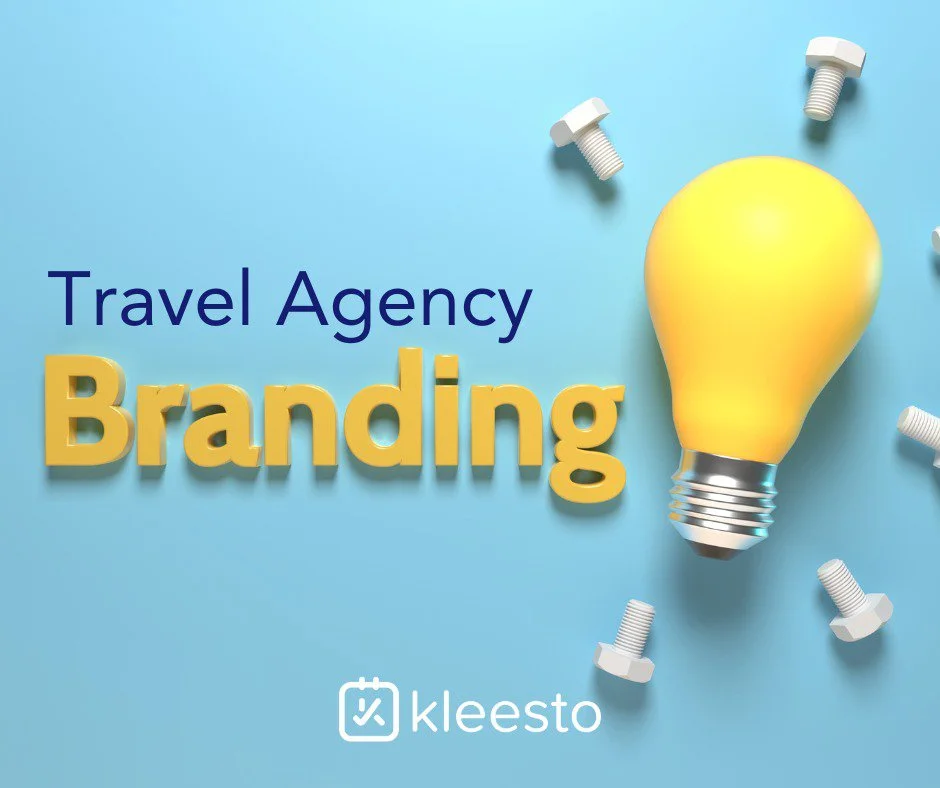
Travel agencies play a crucial role in the travel and tourism industry by providing personalized and expert services to travelers. However, in a highly competitive market with a huge amount of travel companies, travel agencies need to establish a strong brand presence to stand out from the crowd. In this blog post, we will explore the hidden power of travel agency branding and how it can significantly impact your revenue. Discover the key strategies and tactics to creating a strong brand and watch your revenue soar! Let's get deeper into it because branding matters!
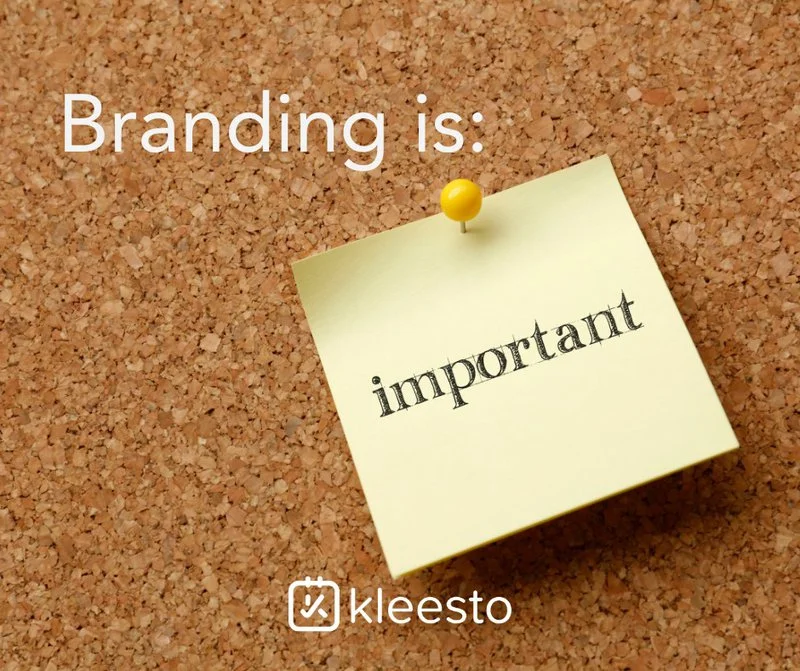
The Importance of Travel Agency Branding
Definition of travel agency branding and its significance.
Travel agency branding is about creating a unique identity for the agency. This includes a name, logo, and visual style that represent its values and services. It's vital because it helps the agency stand out in a competitive market. A strong brand attracts customers and builds loyalty. It also establishes credibility and trust, showing professionalism and reliability. Effective branding creates positive associations, making customers remember the agency and come back for more. In short, branding is crucial for marketing and can greatly impact an agency's success and reputation. Ignoring branding would be a big mistake for travel businesses.
How a strong travel agency branding can differentiate your agency from competitors
A strong brand is crucial for any agency looking to stand out. By developing a unique and compelling brand strategy, you can effectively differentiate your agency from others in the market. So, how exactly can a strong brand accomplish this? Firstly, it helps establish a clear and memorable identity for your agency, making it easier for clients and potential customers to recognize and remember you. Furthermore, a strong brand image can communicate your agency's values and mission, allowing you to connect with your target audience more deeply. In addition, a well-defined brand can create a sense of trust and credibility in the minds of consumers, reinforcing your agency's expertise and reliability. By consistently delivering on your brand promise, you can build a loyal customer base and attract new business. Therefore, investing time and effort into developing a strong brand is essential for long-term success in a competitive market.
The impact of branding on customer loyalty and trust
Travel agency branding plays a crucial role in influencing customer loyalty and trust. When a brand effectively communicates its values and promises, it creates a sense of familiarity and reliability in the minds of its customers. This familiarity is vital in building long-term relationships and cultivating customer loyalty. Moreover, a strong brand also fosters trust among customers. When a brand consistently delivers on its promises and provides a unique travel experience, customers are likelier to trust the brand and become loyal advocates. In addition, branding helps differentiate a company from its competitors, allowing customers to make informed choices based on their preferences and needs. By consistently delivering on its brand promise and maintaining a strong brand presence, a company can enhance customer loyalty and trust, increasing customer satisfaction and, ultimately, business success.
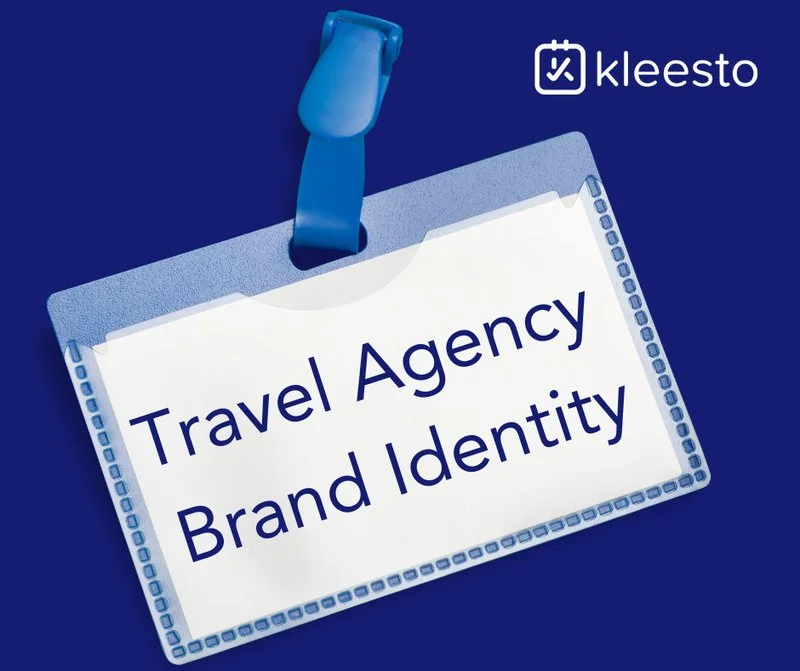

Crafting a Unique Travel Agency Brand Identity
Defining your agency's mission, vision, and values.
Defining your agency's mission, vision, and values is crucial for establishing a clear direction. Your mission statement should be concise and express your agency's purpose and goals, guiding all decisions. It should inspire and motivate employees and stakeholders, reflecting your core values and aspirations. Meanwhile, your vision statement paints a vivid picture of your agency's future, providing inspiration and direction. It serves as a blueprint for success, capturing your desired future state.
Your agency's values are fundamental beliefs that shape actions and behaviors. They act as a moral compass, defining the culture and character of your organization. You can build a strong foundation for growth and success by articulating these elements, creating a cohesive brand identity.
Defining your agency's mission, vision, and values is essential for a clear and unified direction. The mission guides decisions, the vision inspires, and the values shape the organization's culture. Together, they lay the groundwork for your agency's growth and prosperity.
Developing a memorable and impactful agency name and travel logo
Developing a memorable and impactful agency name and logo is crucial in establishing a solid brand identity. The name of your agency should capture the essence of what you do while being unique and easy to remember. It should resonate with your target audience and leave a lasting impression. Similarly, your logo should visually represent your agency's values and services as a visual symbol of your brand. Consider using colors, typography, and imagery that align with your brand's personality and message when designing your logo. Additionally, ensuring that your agency name and logo are versatile and can be easily adapted across different mediums and platforms is essential. By putting thought and effort into developing a memorable and impactful agency name and logo, you can effectively communicate your travel agency ’s branding and attract the attention of potential clients.
Creating a consistent visual identity across all marketing channels
Creating a consistent visual identity across all marketing channels is crucial for building a solid and recognizable brand. By utilizing cohesive design elements, such as colors, fonts, and logos, businesses can establish a sense of familiarity and trust with their target audience. In order to achieve this, it is essential to instruct all marketing team members on the importance of maintaining consistency in visual branding. This includes providing clear guidelines and examples of how the brand should be represented across various platforms, including social media, websites, and print materials. Regularly reviewing and updating these guidelines ensures the brand's visual identity remains cohesive and up-to-date. By implementing these strategies, businesses can effectively communicate their brand message and values to consumers, ultimately increasing brand recognition and loyalty.
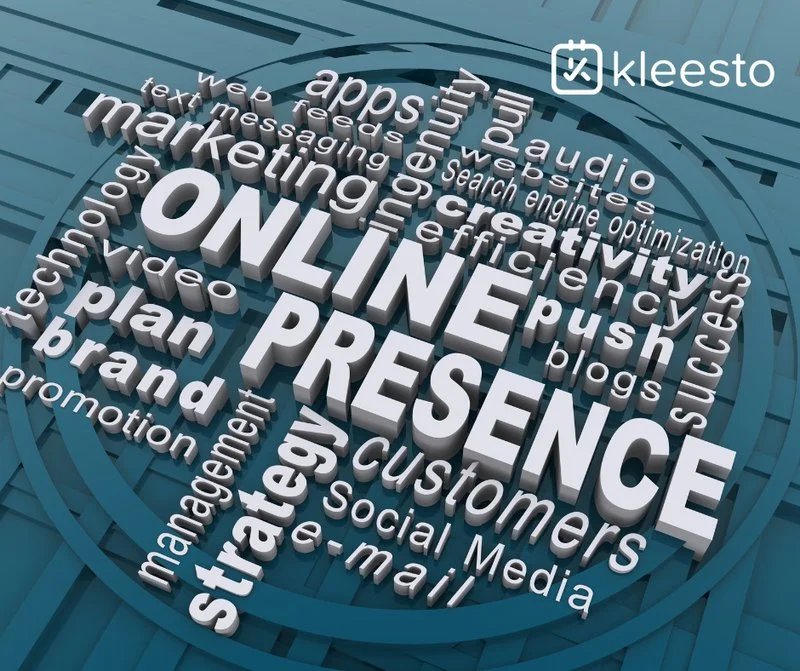
Travel Agency Branding Builds an Engaging Online Presence
Establishing a professional and user-friendly website.
Creating a professional and user-friendly travel agency website is crucial for success in the digital age. Follow these key steps to stand out and attract visitors. First, opt for a visually appealing design that reflects your brand and resonates with your audience. Use high-quality images, clear typography, and a well-organized layout. Make navigation easy with clear menus and user-friendly interfaces. Keep visitors engaged by providing informative and captivating content. Regularly update your website with fresh, relevant information to improve search engine rankings and show your dedication to providing value. Lastly, don't forget to optimize for mobile devices, as many users browse through smartphones and tablets. Following these steps can create a lasting impression on your website visitors.
Utilizing social media platforms to connect with your target audience
Social media platforms play a vital role in social media marketing, helping businesses connect with their target audience. With millions of active users on Facebook, Instagram, and Twitter, companies can engage with customers more personally. By using social media effectively, businesses can create a strong digital presence and establish direct communication with their audience. Regularly posting engaging content, such as blog articles, visuals, or behind-the-scenes glimpses, can resonate with followers. Moreover, actively responding to comments and messages builds trust and a sense of community, increasing brand loyalty and customer satisfaction. Don't miss this incredible opportunity to connect with your audience. Implement these strategies today and watch your business thrive!
Creating valuable and informative content to showcase your expertise
Creating valuable and informative content is essential for showcasing your expertise in today's digital landscape. You can establish yourself as a thought leader in your industry by consistently producing high-quality articles, blog posts, and videos. Start by conducting thorough research on topics relevant to your audience and aligning with your area of expertise. This will ensure that your content is informative and valuable to your readers. When writing, use clear and concise language that is easy for your audience to understand. Break up your content into easily digestible sections and include headings and subheadings to improve readability. Additionally, incorporate visuals such as infographics, images, and videos to enhance the overall impact of your content. By following these guidelines, you can create content that showcases your expertise and provides value to your audience.
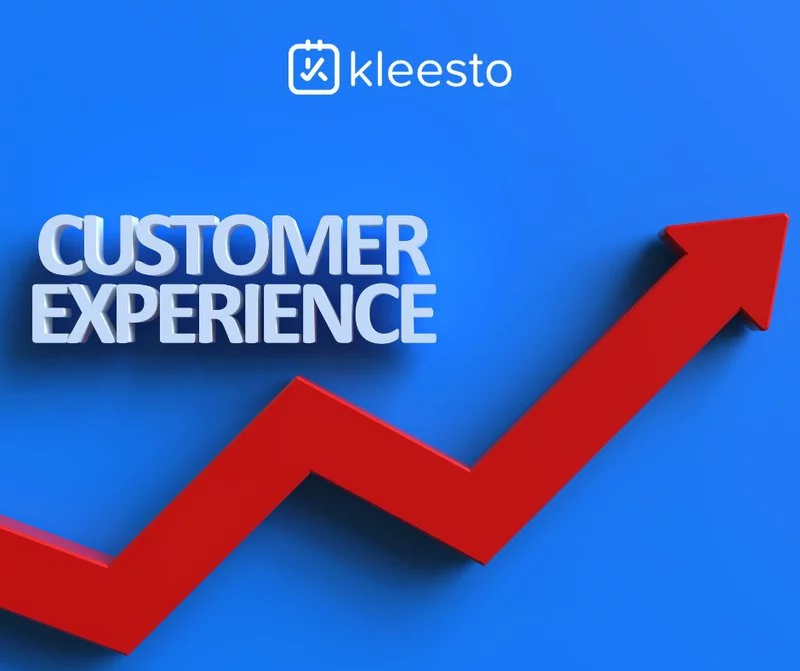
Providing Exceptional Customer Experience
Training staff to deliver outstanding customer service.
Training staff to deliver outstanding customer service is crucial to any successful business. Employees must be equipped with the necessary skills and knowledge to provide excellent service. This training should cover a wide range of topics, including effective communication, problem-solving techniques, and the importance of empathy. Moreover, it is important to emphasize the significance of going above and beyond for customers, as this can greatly enhance their experience. Instructing staff on handling difficult situations, such as angry customers or product malfunctions, is also essential. By arming employees with the tools to handle various scenarios, businesses can ensure that customer interactions are handled professionally and carefully. Furthermore, ongoing training and development should be encouraged, allowing employees to improve their customer service skills continuously. Ultimately, investing in training staff to deliver outstanding customer service is an investment in the success and reputation of the business.
Encouraging customer reviews and testimonials to build trust
Encouraging customer reviews and testimonials is vital for businesses looking to build trust with their audience. By actively seeking feedback from satisfied customers, companies can showcase the positive experiences others have had with their products or services. This helps establish credibility and reliability and instills confidence in potential customers who may be hesitant to make a purchase. Instructing customers on how to leave reviews and testimonials can be done through various channels, such as email campaigns, social media posts, or even in-store signage. It is important to emphasize the value of their opinions and how their feedback can contribute to the growth and improvement of the business. Furthermore, businesses can offer incentives or rewards for leaving a review to motivate customers further to share their experiences. By implementing these strategies, companies can create a positive feedback loop that builds trust and loyalty among their customer base.
Offering exclusive deals and packages to enhance your agency's value proposition
Looking to give your agency a competitive edge in the market? Look no further! Create deals and packages specifically designed to enhance your agency's value proposition. Offering these exclusive deals can attract more clients and make them stand out. Create packages that are carefully curated to meet the unique needs of your target audience, providing them with exceptional value and a reason to choose your agency over others. From discounted rates on travel packages to personalized add-ons and upgrades, these deals will impress and entice potential customers. Don't miss this opportunity to elevate your agency's value proposition and take your business to new heights!
Conclusion:
Branding is essential for a successful travel agency in today's competitive travel industry. By crafting a unique brand identity, promoting your travel agency , building an engaging online presence, and providing exceptional customer experiences, your agency can differentiate itself from competitors and attract more clients. Invest in your agency's branding efforts, and watch your revenue soar as you establish a strong and trusted brand in the travel industry. Make your brand stand out! Don’t lose the chance to book a meeting with us today and discover more ways to boost your travel agency and reach success.
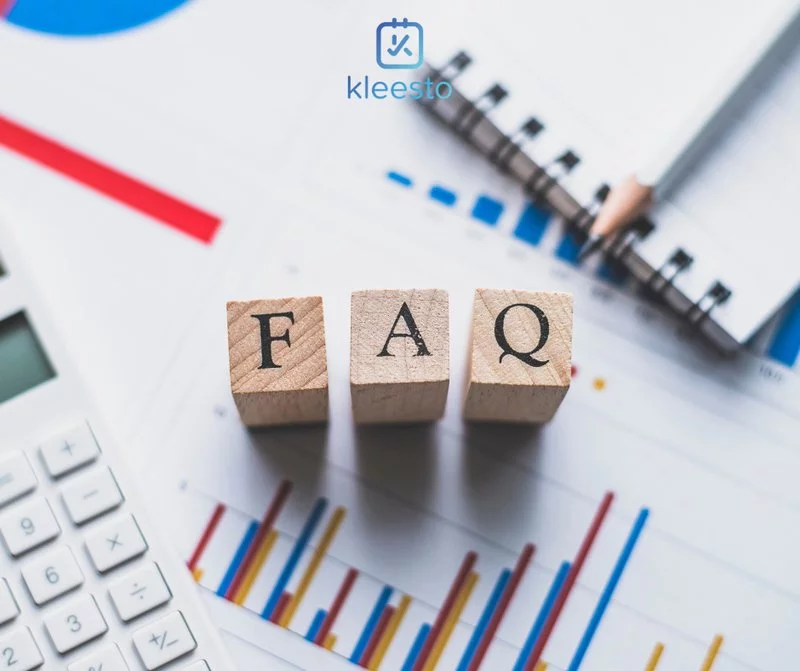
FAQ for Travel Agency Branding
- Why is travel agency branding important in the tourism industry? Travel agency branding is vital because it creates a unique identity that distinguishes you from competitors. It helps build credibility, trust, and customer loyalty while making your agency more memorable and appealing to travelers.
- How can a strong brand help my travel agency stand out? A strong brand makes your agency easily recognizable and relatable. It communicates your values, mission, and expertise, connecting with your target audience on a deeper level. This differentiation builds trust and credibility, fostering customer loyalty and attracting new business.
- What role does branding play in customer loyalty and trust? Branding influences customer loyalty by creating familiarity and reliability. Consistently meeting brand promises fosters trust, making customers more likely to advocate for your agency. A well-established brand helps customers make informed choices and enhances satisfaction, contributing to your agency's success.
- How do I establish a consistent online presence for my travel agency ? Establishing a consistent online presence involves creating a professional, user-friendly website and using social media effectively. A well-designed website with informative content and mobile optimization appeals to visitors. Engaging social media posts directly connect with your audience, fostering trust and loyalty.
Share it on
For direct inquiries that need personalized assistance.

Join us for a 21-Day exploration of kleesto
Don’t worry, Kleesto is here to help. Start a free Trial Demo.
Don't just leave empty handed!
Download our Ultimate Business Guide to boost your digital presence
Learn how to Get More Bookings , Save Time and Increase your Booking Revenue!
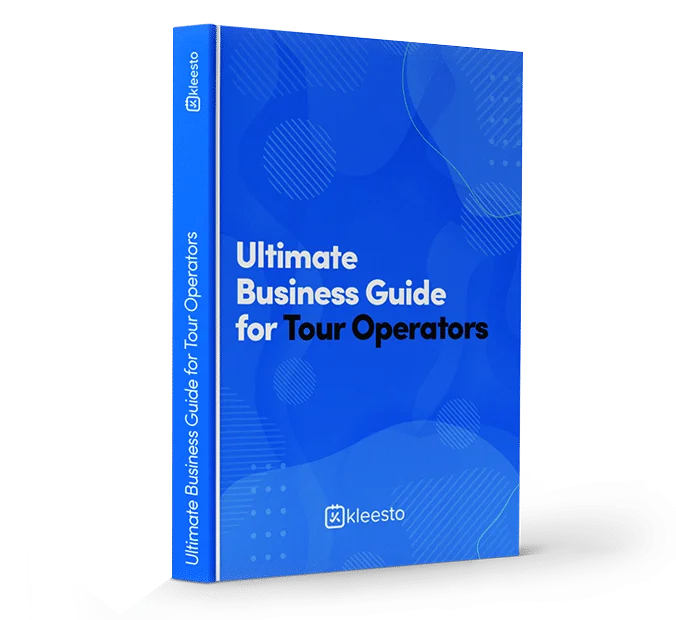

A Guide to Branding in the Travel and Tourism Industry

What is Branding?
Branding is all about establishing your business’ image in front of your audience. In other words, what do your customers think and feel when they see or hear your brand name? With a proper branding strategy in place, you will be able to influence your audience’s perception of your brand in the way that you want.

Why is Branding in the Travel and Tourism Industry Important?
The main objective of branding is to ensure that your business stands out from the crowd. As a travel company or tour operator, you’re well aware of the competition that is currently either providing similar activities and experiences as you or simply operating within your vicinity. You need to ensure your activities make a bigger impression on would-be guests than any of your competitors.
If your activity, excursion, or tour is listed on travel websites like Expedia or TripAdvisor , travellers are even less likely to pay attention to you, the activity provider. It’s not uncommon for customers to associate their experience with a tour or activity with the travel site they booked through instead of the tour company itself. Of course, the reach and exposure you receive by being listed on a popular travel site is great, but it can make it difficult to establish a name for yourself as you end up being just another link to scroll past.
Creating a strong brand for your company can help with all of that. Here is our guide to branding in the travel and tourism industry so that you can attract more customers and increase your bookings.
How to Brand Your Travel and Tourism Company
Discover your brand story.

Everyone has a story and every brand should have one too. A well-crafted brand story connects with your audience and encompasses important things like your company’s mission and vision. That is, what do you provide your customers? How are your tours and activities unique? What do you wish to accomplish and how do you want to grow your tour business in the future?
While what you do and how you do it is important, it’s even more crucial to think about why you do it. What is your motivation and inspiration? Answering these questions may require some self-reflection and discovery, but it’s what your customers are going to potentially connect with the most, especially if their values and beliefs align with yours.
Understand Your Target Audience
You may think understanding your target audience is pretty easy. Your customers are obviously people who want to travel to your destination or experience your activity, right? Well, if you take the time to research your current customers and the potential clients you want to attract, you can learn so much more.
Get to know your customers’ demographic (age, ethnicity, gender, marital status, income, etc.) as well as their motivations, pain points, and values. Why do they seek out experiences like yours, and is there anything they wish they could change about the process? This information will help you brand your tourism business accordingly and can guide future marketing efforts. Collect this data by asking your guests to complete a quick survey or by creating an audience persona .
Develop Your Brand Personality
Brand personality refers to the human characteristics attributed to your brand. Is your tour company adventurous? Daring? Spirited? Enthusiastic? Or is your brand personality a little more calm, easy-going, and sophisticated? However you define your brand personality, make sure it resonates and aligns with the type of guests you want to attract. Your brand personality will also influence your brand’s voice and tone.
Create a Brand Identity

Your brand identity includes the visible elements of your company like your logo, colour palette, typography, etc. Your brand design should help your business stand out from other tour and activity providers. If it’s within your budget, a good marketing or branding agency can work with you to create a professional brand identity. You can also look into hiring a freelance designer, creating your identity yourself, or utilizing services like 99designs by Vistaprint.
Check out these amazing travel logos if you need some inspiration. The best ones immediately convey a certain feeling with their design and make it easy for customers to recognize the activity provided.
Interact and Engage with your Customers
Using social media as a marketing strategy to spread brand awareness is an easy choice. As long as you’re using the correct social media platforms for your target audience, you’ll be able to interact and engage with your customers, helping them familiarize themselves with your brand and building brand affinity. If you’ve outlined a brand voice and tone for your business, make sure you’re following it. For more tips on navigating the social media world, here’s a guide on using Instagram Stories for travel marketing .
Consistency
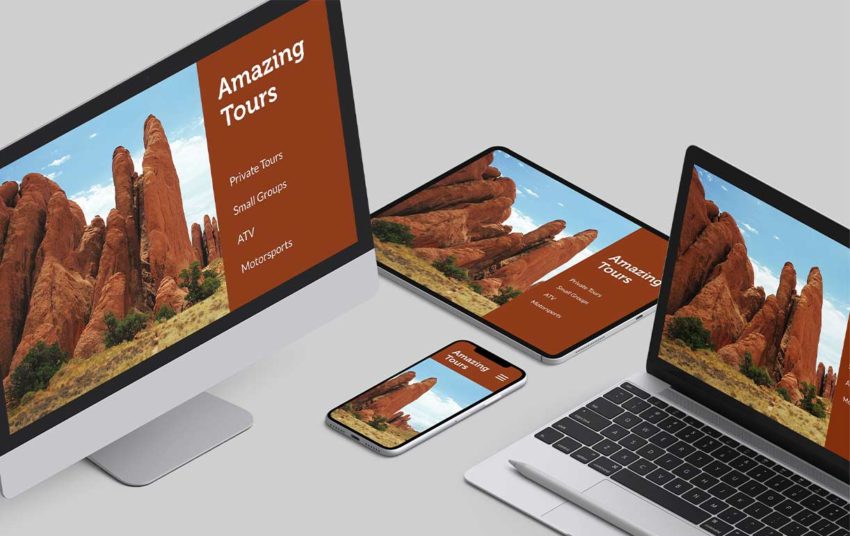
In order to promote a clear brand image, it’s important to maintain consistency across all aspects of your business including your various channels of communication (website, email, social media). Consistency helps develop trust with your customers and delivers a strong, cohesive message. If you’re describing your tour as fast-paced and energetic on Instagram, don’t market it as a relaxing and calming experience on your website.
Destination Branding
Destination branding is similar to what we’ve discussed above, but the focus is on the destination itself as opposed to a business. The biggest difference though, is that you can’t really create a destination brand the way you would for your tour company. Destination marketing is influenced by the experiences and perceptions of tourists and travellers. The reputation of the destination is used to craft a story and build an identity to promote its uniqueness and memorability. Here are 3 examples of great destination brands .
With all that being said, it’s important to ensure that the branding for your own business is aligned with the branding of your destination. For example, if you’re located in a destination known for its serene scenery, relaxing atmosphere, and slow-paced lifestyle, you might not want to brand yourself as being an adventurous, high-energy experience.
Remember, everything that you say, do, or post online affects your brand, so make sure that it’s aligned with how you want to present your travel and tour business to the world. Use this brand-building guide to help you develop awareness, recognition, and affinity for your brand. With some dedication, you’ll soon notice that your business is attracting more customers with an increase in overall bookings.
Looking for more ways to make the most of your branding? Check out our detailed guide on branding for tour and activity operators .

Written By | Edward Nieh
Edward Nieh is a freelance writer and copy editor working across multiple mediums for clients from various industries. He has a degree in creative writing with a focus on screenwriting for feature films.
Previous Article Letter from Founder & CEO - Welcome to Rezgo’s new era
Next Article 5 Rules for Choosing the Best Tour Company Name
Related Posts

Articles , Increase Online Bookings , Tourism Trends
17 innovative tourism business ideas and trends for 2024.
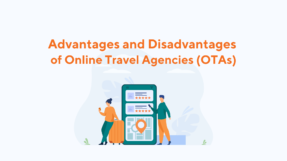
Articles , Increase Online Bookings , Tourism Best Practices
Advantages and disadvantages of online travel agencies (otas).

Articles , Increase Online Bookings , Marketing Strategies
Your marketing mix: the 7 ps of travel and tourism marketing, search the blog.
- All Categories
- Increase Online Bookings
- Marketing Strategies
- Tourism Best Practices
Most Popular Articles
- 17 Innovative Tourism Business Ideas and Trends for 2024 151 views
- Your Marketing Mix: the 7 Ps of Travel and Tourism Marketing 36 views
- Advantages and Disadvantages of Online Travel Agencies (OTAs) 36 views
- How to Create a Business Plan for Your Tour or Travel Company 23 views
- Looking ahead: Setting goals for your tour business 13 views
I have read and agree to the Rezgo Privacy Policy
GET STARTED
Sign-up for a free demo.
Lorem ipsum dolor sit amet, consectetur adipiscing elit, sed do eiusmo tempor incididunt ut labore et dolore magna aliqua.
Schedule A Demo
- Skift Research
- Airline Weekly
- Skift Meetings
- Daily Lodging Report
The Rise of Lifestyle Branding in Travel
Related reports, executive summary.
The stakes for global consumer brands have never been higher. As companies like Apple soar to market capitalizations in the hundreds of billions of dollars, making them among the world’s most valuable, many in the travel industry are taking notice. What they’re grasping about the success of Apple, and other companies in this top tier of brand excellence, is their increasing embrace of the philosophy of lifestyle branding.
World class brands like Nike, Disney, Coca-Cola and BMW that succeed with lifestyle branding embody the interests, attitudes , and opinions of a particular group or culture of consumers. They do so by using their products and services to help inspire, guide and motivate people. Apple has succeeded not just by selling computers but by selling the idea of beautifully designed, consumer-friendly technology as a way of life. Nike, on the other hand, has gone from selling running shoes to a symbol of an athletic-focused community of competitors and sports enthusiasts.
Plenty of travel-industry brands like Virgin America, ACE Hotels and Airbnb have also carved out unique lifestyle brand niches as well. But creating a lifestyle brand requires a significant amount of commitment, marketing excellence and resources to pull off. For every company like Apple that spent nearly $1.8 billion on branding efforts in 2015, there are countless other firms in the travel space with limited resources struggling just to stay on top of the latest social media platforms.
What lifestyle branding strategies are marketers in the travel industry using to redefine their brands for consumers and differentiate themselves from competitors? And what obstacles do they face to accomplishing these strategies now and in the years to come?
Introduction
Each year, the global consultancy Interbrand releases a list of the world’s top global brands by market capitalization. The list is virtual “who’s who” of the world’s most popular consumer companies. Apple, not surprisingly, leads all brands on Interbrand’s list, with a market capitalization of over $170 billion. Many of the world’s most recognizable, and valuable, consumer companies also make the list, including Google ($120 billion), Coca-Cola ($78 billion), BMW ($37 billion), Disney ($36 billion) and Nike ($23 billion).
An examination of Interbrand’s 2015 ranking of the top global brands by market capitalization emphasizes the importance of lifestyle branding to company success. Source : Interbrand
Even though each of these top-ranked companies has a different line of business and core customer base, they all share one strategy in common: lifestyle branding. Though the concept takes can take on a number of definitions depending on source, it often refers to brands that transcend the consumer’s rational decision-making criteria (based on criteria like cost or value, for example) to incorporate more intangible purchase features that embody the interests, attitudes , and opinions of a particular group or cultural mindset.
Take a few members of Interbrand’s list as examples. Apple wins hearts and minds by not just selling computers and phones, but promoting an idea of masterfully designed, consumer-friendly technology as a way of life. Disney, meanwhile, doesn’t just make films and TV shows. It inspires a real life sense of magic and imagination through extensions like theme parks, clothing and even a private island and a cruise line.
This idea of lifestyle marketing is now gaining traction in the broader travel industry as well. At a time when metasearch engines, online travel agencies and review websites threaten to make travel purchase decisions nothing more than price comparisons, creating a method to stand out is critical. As Skift noted in its 2015 Megatrends Report, “The days of travel brands surviving as stark service providers is over. Clean sheets and safe flights are considered standard among customers, especially millennials, who seek deeper connections to brands’ values and the lifestyles that they represent.” ( source )
But trying to create a so-called lifestyle brand in the travel space is easier said than done. Aside from the fact that few travel brands have the “war chest” necessary to match Apple’s mammoth global ad spend, there are other challenges. The other challenge for travel brands is defining who exactly they’re trying to target. “You can’t appeal to everyone, so you have to be very focused and target specific groups, and that means you’re going to alienate another portion of your customer base,” said Hayes Roth, founder of HA Roth Consulting, a branding firm. In addition, a proliferation of new marketing channels across the worlds of online, mobile and offline, further confuses marketers about where they should focus their efforts to inspire consumers, pulling already tight resources even thinner.
Skift’s Trend Report “The Rise of Lifestyle Branding in Travel” investigates what the notion of lifestyle branding means for the travel industry. Rather than trying to investigate every potential approach, the report focuses on the core strategies used by all successful lifestyle brands, and examines how a range of travel marketers from across the industry have created their own version the lifestyle philosophy, often with limited resources.
Defining the Lifestyle Brand Philosophy
What is a lifestyle brand? In order to make sense of lifestyle branding, it’s essential to first define what it means. According to university professors Stefania Saviolo and Antonio Marraza, authors of the 2013 book Lifestyle Brands: A Guide to Aspirational Marketing , lifestyle brands “…embody the interests, attitudes , and opinions of a group or a culture ,” and typically are companies that “…seek to inspire, guide, and motivate people, with the goal of their products contributing to the definition of the consumer’s way of life.” ( source )
A vintage ad for Greyhound pitches relaxation and reduced worry over traffic as the core benefits of the traveler’s trip. More recent travel advertising has evolved in a much more abstract, emotional direction. ( Found in Mom’s Basement )
In other words, they’re brands that make their sales pitch based on emotion rather than pure reason. Allen Adamson, branding expert and founder of BrandSimple, says that a lifestyle brand is “one that people use for reasons beyond the product.” Today’s brand’s in the travel category and beyond seek to understand their customers’ way of life and then emulate it through marketing and product differentiation. They understand what motivates this group and aim to become a part of that culture.
This represents a shift from how companies used to sell products to consumers. At the dawn of the mass consumer era and well into the 20th century, companies sold their products by making a plea to consumers’ rational decision-making. Whether your brand sold canned soup, bus tickets or cruises, the pitch was largely the same: explain how this product would improve life for your customer in some specific way.
Yet as mass media, and consumers, have gotten more sophisticated in the last 40 years, there’s been a fundamental shift in the way the world’s most successful brands attract consumers. Instead of using purely rational pleas, the sales pitch has gotten much more emotional and abstract.
According to Chris Campbell, branding expert and executive creative director for Interbrand North America, the concept of a lifestyle brand marks an evolutionary shift in the way all brands, including those in the travel sphere, think about their relationship with consumers. “It’s a natural progression as the differences between products diminish. As product differences become less and less, marketers have been forced to appeal to consumers in ways beyond rational product differences.”
The advantages of this approach are many. In addition to inspiring a sense of loyalty among customers, lifestyle branding helps companies better differentiate their offering against competitors and charge premium prices for what would otherwise be commoditized goods. “The best brands all command premium pricing. Commodity thinking results in commodity pricing,” said Devin Liddell, Principal Brand Strategist at Teague, Seattle, in a 2015 interview with Skift. “Every other category in the world gets this. Look at Apple, look at Starbucks. They command premium prices because they create brands that consumers resonate with on an ethos level.”
A selected timeline of innovations in lifestyle branding across the travel industry.
The danger, however, with lifestyle branding is it is an inherently nebulous concept, which has a variety of meanings to different marketers. “Quite frankly, I think the term ‘lifestyle brand’ is overused because it means many different things in many different market segments,” said Hoyt Harper II, SVP and global brand leader for Starwood’s The Luxury Collection. This lack of a clear definition means there are an infinite number of ways a travel brand might choose to market its own lifestyle persona. The challenge, therefore, lies in knowing what works, and what doesn’t, in the travel space.
Why Lifestyle Branding Matters to Travelers
In order to better understand why a travel brand might adopt a lifestyle brand philosophy, it’s also worth considering why travelers have connected with this approach in the first place. As it turns out, consumers increasingly look to their favorite companies to do much more than just sell them stuff. Instead, they want to forge an emotional connection with them, much like they would with a trusted friend. This is formed across any number of touchpoints, including the content and meaning of its marketing messages, and its ability to create a sense of belonging and build community in a way that makes the customer feel valued.
Social media is a great litmus test for how lifestyle brands have come to dominate the cultural conversation. Take for instance a recent survey by Marketing Sherpa investigating why consumers “Liked” various brands in social media. Although reasons like getting promotions or wanting to buy their products were top responses, other more interesting answers emphasized that the chosen brands produced “useful” or “entertaining” content (mentioned by 38% and 31% of respondents) or that the brand “reflects my lifestyle,” which was mentioned by another 24% of respondents.
Reasons that consumers connect with brands on social media, according to a 2015 consumer survey by Marketing Sherpa. Source
Equally important to today’s consumer is aligning with brands that match their personal values and provide them with a sense of belonging. This is particularly important when it comes to millennials and Generation X, both of whom are increasingly demanding about the companies with which they will associate. Take the world of travel loyalty programs. According a recent study by Colloquy of loyalty program preferences by generation, 63% of millennials said they wanted their loyalty program to align with lifestyle preferences like sustainability, wellness programs and charities, with 53% of Generation X mentioning the same qualities. ( source )
Last but not least is a renewed focus on brands that consumers think understand their values and customize their messages specifically for them. This extends not only to the products that travelers choose to buy, but increasingly to the ads and content they are served by brands as well. “Consumers of all ages want brands to feel personalized and meaningful to them,” said Y&R BAV president Michael Sussman, speaking in a 2015 interview with Adweek.
Take for example a recent study of consumers’ digital media preferences by ad tech firm Rocket Fuel, which happened to be examining those who had purchased fitness trackers or were interested in purchasing one. 54% said they expected digital ads “to be more tailored to be more tailored to my personal interest and lifestyle,” with another 49% noting they wished “the digital ads I saw were more tailored to my personal interests.”
As Rocket Fuel’s recent survey reveals, consumers increasingly expect brands to understand their values and customize their messaging accordingly. Source
As it turns out, these different, yet connected, sets of brand criteria, focusing on factors like providing entertaining and useful content, aligning with personal values and providing a sense of belonging, form the core of any successful lifestyle marketing strategy. The travel brands hoping to succeed with today’s increasingly lifestyle-focused consumer must find a way to embody one, or several, of these values.
Components of a Successful Lifestyle Brand
On top of finding a philosophy that matches consumers’ values, successful lifestyle brands must also invent and consistently project that vision through their marketing and product experience. This requires the creation of an end-to-end consumer experience that cuts across various brand touchpoints, covering everything from the online experience to how customers will use the product. The other component involves the creativity and willingness to sometimes reinvent your company’s product offering so that it comes to represent a new or shifting mindset. Below are examples of how this works in practice for some of the world’s top travel brands.
Creating a Cohesive Experience
What is it about Virgin Airlines that elevates the flight experience to something less horrible than other carriers? How have Airbnb and Lyft managed to build almost cult-like devotion where the brand experience transcends the product experience?
The answer to those questions has to do with creating a holistic brand experience. Simply having a clever ad campaign to communicate your brand is no longer enough. In today’s era of lifestyle brand luminaries, everything from the company’s website to its customer service, to its events and spokespeople form part of the brand experience.
Katie Dill, head of experience design at Airbnb, recently presented a session called “Designing Experiences Offline & Online” at the 2016 South by Southwest Conference, highlighting how lifestyle companies successfully merge their digital and live platforms to heighten the emotional connection (and consistency of message) between the brand and consumer.
With Virgin Airlines, for example, “The heightened brand experience starts way, way in the beginning right from the advertising,” said Dill. “There’s a theme there that’s edgy, simplified, refined. And that same theme is visible and felt throughout the majority of the touchpoints you might have with it. When booking travel, the website and the UI [user interface] is edgy, simplified and refined.”
Dill continued, saying that the check-in process is a physical manifestation of that digital interaction. Virgin, she said, focused on a great level of small details in tone, colors, vibrancy, hipness, etc., so there is a cohesiveness among all of the interactions with the brand, whether they’re online or offline.
“So by the time you actually get on the airplane, it’s like a crescendo of the entire ensemble they’re creating,” Dill said. “Imagine that getting on the plane is a crescendo. It’s wild how they’ve been able to do it. To be honest with you, it’s the same cramped and overly expensive experience as most airlines, but there’s definitely this elevated feeling because all the while between every touch point you’ve had, they’ve physically been reinforcing this message, that it’s elevated, it is edgy, unique and refined.”
Virgin America’s colorful interior lighting scheme may not seem like a key component of the brand’s lifestyle experience, but this subtle touch helps form a key part of how travelers perceive the brand. ( Source )
When companies do that and they do that well, they compound the overall value of the brand in the consumer’s mind.
Meanwhile, Airbnb and Lyft are two examples of digital platform, or “sharing,” companies that have unique advantages and challenges when it comes to developing a lifestyle-oriented narrative around their brands.
The advantage is based on offering something that disrupts an entire industry, so it communicates something fresh, modern, innovative. Room- and car-sharing offer a new level of customizable experiences for different lifestyles and for what’s perceived to be a higher value spend. On the other hand, because sharing companies by definition are a peer-to-peer transactional model, the companies don’t have control of the actual product experience. All a sharing company can do is set the framework for value exchange, anticipate challenges, and navigate the line between too much control and too much chaos.
So Airbnb’s goal is to do whatever it can to “relent control but not lose control” by building systems that celebrate and foster community engagement. “If you think about it, it’s the diversity of uniqueness of that community that really adds so much to your experience,” said Dill. “So you want to be able to harness the diversity and turn it into a value add. This is an extreme case of offline and online experience design.”
Dill then laid out a five-step framework that Airbnb builds its brand experience upon to create a cohesive user experience both online and in-destination.
According to Gray Shealy, an expert in hotel brand development and the lead for Georgetown University’s new Master’s in Hospitality Management program, this ability to create a holistic language and philosophy across all brand touchpoints is key to the lifestyle approach. “Once you have an idea of who that target audience is, then you’re able to define passion points and a mission for the brand. As you build a brand, you get a vocabulary that you’re able to use to define yourself. You can then start to create experiences around that.“
As Shealy notes, great lifestyle brands look at all of the different touchpoints, ranging from mobile apps to loyalty programs that are most impactful for that particular brand, and use those touchpoints to keep the experience going even after the guest has left the property.
“You’ve seen the apps, the loyalty programs,” said Shealy. “They define and stay with the consumer. It’s a circle because it means that a true experience and a real strong brand does not break the cycle. Once you leave a property until the next time you arrive, there are touchpoints where you are interacting.”
Airbnb once again is a great example of how to extend a lifestyle vision in a variety of new directions, creating brand touchpoints like a print magazine and in-destination tours and activities. In other words, the brand seeks to not only position itself as champion of a certain way of travel, but also enable that lifestyle by providing the tools and platforms that allow consumers to continue the journey even once their trip is over.
Airbnb’s Pineapple Magazine is one way the brand continues to experiment with engaging potential customers well after they’ve finished their accommodation-sharing experience.
Rethinking Products for a New Customers and Mindsets
Taking a position as a lifestyle brand sometimes also requires a brand to change or revise a core of its product offering to suit changing values and mindsets. This can be seen broadly across travel sectors with brands that are refocusing their offerings using cultural cues like shifting traveler preferences, a urge to contribute to charitable causes and a focus on buying experiences rather than objects.
One brand that’s had to consider how to realign its product offerings to address the changing lifestyle values of consumers is Hilton. In January 2016, the company announced the launch of a new mid-range hotel chain, called Tru, under the Hilton family of brands. According to a Hilton press release for the launch, “The brand will appeal to a broad range of travelers who span generations but think alike; they are united by a millennial mindset – a youthful energy, a zest for life and a desire for human connection. No brand is meeting their needs in their price point today.”
Sometimes repositioning a brand with a new message isn’t enough. As Hilton realized with the launch of its Tru brand in early 2016, reinventing your brand via a new product offering or extension is the best bet. Source
According to Alexandra Jaritz, global head for Tru, the idea behind the new brand was built around an emerging “youthful” mindset and lifestyle that cut across a variety of generations. “It’s really about a youthful mindset,” said Jaritz, speaking with Hotel News Now. “Boomers, Gen X-ers, Millennials, Gen Y…all share a very similar mindset, and it’s about being youthful…You see that spirit and that playfulness in our brand. But they also want value. They want a great bed, a great breakfast served up in a fun, fresh, functional way [and] they want a great technology experience.” ( source )
For Raja Rajamannar, CMO of MasterCard, changing consumer values have forced the payments company to shift its overall product offering and public persona. While the company has long been known as a payment technology provider, it’s now trying to position itself in a way that creates a more emotional appeal with cardholders. “We are a technology company, which happens to be in financial services, giving lifestyle to consumers and we are a lifestyle experiential brand and that’s a position we have been developing over the last two years,” said Rajamannar in a 2015 interview with The Drum. ( source )
The core focus of this shift in positioning is an overhaul of its popular “Priceless” campaign, and the company’s related product offerings. “When we launched ‘Priceless’ in 1997, the marketplace was completely different from what we have today,” said Rajamannar. “The platform has worked brilliantly, but consumers’ expectations have changed. Demographics have changed. And in that kind of situation, we asked how our brand should evolve to keep up with changing times.” ( source )
This new MasterCard product approach is designed around the launch of four core consumer pillars that emphasize experiences and altruism over stuff. The Priceless Cities product offers cardholders curated experiences in 45 cities around the world, while its Priceless Surprises program is designed to randomly reward customers who use their card with special gifts or experiences. There’s also Priceless Causes, the company’s new philanthropic giving arm, which matches consumer spending with charitable donations, and Priceless Specials, which offers cardholders access to unique perks, like skipping the line at popular restaurants.
For MasterCard, changing consumer values meant the firm could no longer afford to think of itself purely as a payments technology company. This meant extending its popular Priceless campaign into new touchpoints that empowered cardholders to take advantage of special experiences, rewards and opportunities for philanthropy. Source
This product and branding overhaul also extends to MasterCard’s philosophy towards partnerships as well. In an era of billions of consumers and countless different areas of consumer interest, it’s key for brands to be willing to join forces with other likeminded organizations that can help reinforce their message. Rajamannar is quick to admit that savvy partnerships can help brands more easily scale their lifestyle philosophy when they have limited resources.
“Because we want to address nine different passion points of human beings around the world, and there are 1.6 billion consumers around the world, you cannot do it all by yourself because we don’t manufacture everything and we don’t create everything,” said Rajamannar. “Partnerships are very critical, not just in the mobile space and digital space but in totality.”
Other Travel Brands Doing Lifestyle Marketing Right
Below are examples from the worlds of hospitality, aviation and adventure travel that further expand on how travel brands can align themselves with a particular lifestyle philosophy. The strategies outlined below pull from a mix of lifestyle branding philosophies detailed above, including creating new brands or products, developing a consistent brand experience, creating a sense of belonging and community and using content to tell a story.
The Evolution of “Soft Brands” in Hospitality
The major legacy hotel brands have launched a deluge of new lifestyle hotel brands in the last few years in an attempt to attract new consumers and keep their existing loyalty members. One aspect of this are “soft brands,” where an established global hotel group brings existing independent hotels into a new collection. That brand is then integrated into the larger brand’s distribution system, such as the Curio Collection by Hilton and Unbound Collection by Hyatt lifestyle brands.
“The use of ‘Unbound’ is really derived from the notion of freedom,” says Maryam Banikarim, CMO of Hyatt Hotels. “Freedom for owners to be able to continue to operate the way that made them successful, and freedom for consumers to experience travel the way they want, but supported with Hyatt’s level of service consistency.”
According to Banikarim, there are two primary brand pillars that define The Unbound Collection and differentiate it from the other soft brands.
One, every hotel will be a full-service luxury property required to maintain Hyatt’s brand standards in terms of service delivery and maintenance. Two, all of the hotels will have a strong storyline and a unique personality specific to their destination.
The big hospitality groups are also developing new lifestyle hard brands such as Marriott’s AC Hotels and Moxy Hotels. Designed specifically for the millennial market, Moxy has developed new content platforms with a youthful tone and aggressive swagger unprecedented from Marriott.
For example, the new “ Do Not Disturb ” YouTube video campaign features YouTube queen Taryn Southern interviewing other online influencers. This all takes place with Southern and her guests reclining on a bed in a sample Moxy guest room housed inside a 20-foot shipping container parked at the YouTube compound in Los Angeles.
A screenshot of a scene from Moxy Hotels’ new YouTube video campaign, “Do Not Disturb.” YouTube
The Do Not Disturb videos are designed to drive advanced exposure around the Moxy flag by tapping into the participating YouTubers’ large volume of Gen Y audiences. Presently, Southern has about 453,000 followers, and some of her guests have many more.
“We wanted to create a fun virtual extension of what the brand is all about,” says Vicki Poulos, global brand director for Moxy Hotels, who looks like she should be of drinking age any day now. “It was important to find the right partners for Do Not Disturb, who would actually stay at a Moxy Hotel. So we really looked for a ‘We get them/they get us’ kind of thing.”
However, independent hoteliers like Brad Wilson, president of the Ace Hotel Group, suggest that these new lifestyle brands developed by the big chains still feel like chain hotels. They might have more contemporary design and smaller room counts, but they can’t offer the spirit of a true independent hotel that celebrates individuality and local invention.
“Each hotel has its own independence because we don’t do anything that’s cookie cutter,” said Wilson at the Independent Lodging Congress 2015 in New York. “Our lobby in New York is sort of famous and we don’t have a lobby in Los Angeles. I think we sometimes confuse people because we evolve and it’s about that city.”
Wilson went on to explain that in L.A., people like to be outdoors sitting by the pool or under a tree somewhere, versus a dark lobby. So the Los Angeles property was designed as such. But the connection with the local culture goes beyond hotel design. Ace Hotel and other similar indie brands place a premium on partnerships with small, artisanal suppliers, to further establish that more authentic local connection.
“It’s a lot of work to design an Ace Hotel, and it takes a lot of time and effort to align the product with the local neighborhood and find the right partnerships,” said Wilson.
He adds that a true independent lifestyle hotel customer isn’t typically going to be interested in lifestyle hotels operated by the big chain because, “They’re not interesting.”
“They’re out there saying, ‘Come to chain.com and book your little independent hotel,’” Wilson explained. “But the people who love chain.com are already on chain.com. I don’t know the independent customer is going to suddenly say, ‘Oh, that hotel is suddenly designed, I’m going to go book it on chain.com.’”
Aviation Lifestyle Brands: Still Waiting to Take Off
Even as competition and innovation in lifestyle branding heats up in the hospitality sector, many in the aviation industry have largely ignored the lifestyle branding trend. As Teague’s Devin Liddell notes, “Airlines should be working to become lifestyle brands. But they’re not investing in the actions required to do so.”
In the United States, airlines like JetBlue, Southwest, Spirit, Virgin America have all done an admirable job of trying to change the flying paradigm. As previously noted, Virgin America is probably the best embodiment of the lifestyle trend to date in the U.S. The firm’s sleek, modern check-in lounges, ambient mood lighting and route map of “creative class” hubs like San Francisco, New York, Chicago, Los Angeles and Austin, are all representative of its holistic approach to building a brand across all potential customer touchpoints.
Yet among the major U.S. legacy carriers including American, Delta and United, who collectively carried more than 520 million passengers in 2015, there’s still plenty of room for lifestyle innovation. The ancillary service fees that increasingly characterize the domestic flying experience may build strong earnings statements, but they are far from an approach that emotionally bonds travelers to the airline brands.
“The fact that people still seek out PanAm flight bags, decades after the brand ceased operations, shows that passengers want more from airline brands,” said Liddell. “This is a hiccup in airline strategy. They don’t invest in activities which build a bond between the brand and the consumer. They are too busy stripping away features they perceive as adding costs, rather than adding features which build up brand loyalty. It’s a tendency of the industry.”
As airlines think about how to embody this idea of lifestyle, there are a number of promising examples of lifestyle integration on the international side of the business. Emirates is one airline that’s been thinking about how to evolve its brand to better succeed in an era of increased global competition for airline passengers. As Emirates grows its network throughout the U.S., the carrier is turning to lifestyle branding and adding new loyalty program partners to gain awareness in the still-growing market.
“We are strongly looking at expanding our partnership base as a key pillar when it comes to the development of our frequent flyer concept,” said Hubert Frach, Emirates’ divisional SVP of the West, in an interview with Skift in Dubai last year.
A creative execution from Emirates’ 2013 ad campaign targeting creative class fliers. Source
One key area of interest for Emirates are partnerships that help reinforce its awareness with Western flyers. Emirates partnered with American Express Membership Rewards and the Starwood Preferred Guest loyalty programs last year in an effort to gain relevance in the U.S. It isn’t unusual for an airline to partner with a credit card and hotel company, but Emirates has larger goals. “Our ambitions are really to be a globally perceived lifestyle brand,” he said. “We want to develop [the] Skywards [program] into more of a lifestyle loyalty program that’s relevant in every part of your life.”
According Mika Paech, Brand Communications Controller for Emirates, the company is also trying to position its business class offering as the choice of affluent creative class individuals. “One of our campaigns features a musician that’s traveling for business and is inspired by the Emirates Business Class environment and our product. Our Business Class is not about suits and laptops. It’s a lifestyle choice for those who are in the business of living, because they do what they love and love what they do.”
Another area many believe is ripe for aviation innovation is the design sector. Much as boutique hotels have used savvy design to position themselves as an alternative to bland chain hotels, some believe airlines can do the same through design. Liddell points to the RFID bag tags from Qantas as one example. “They’re beautiful and beautifully functional. It’s something you look at and want, even if you’re not flying with them. You see it and you want to have it. And they address a functional concern—bag tracking—that has a big emotional footprint.”
Australian carrier Qantas is using a sleek new RFID tag program to help communicate the brand’s renewed commitment to customer service, customer-friendly technology and elegant design. Source
Poler: Creating a Community Around the Casual Camper
Building a lifestyle brand also has a lot to do with creating a community of likeminded individuals. But how does a business start to find and build that community, and how can they use their online content efforts to help it grow? One example of a smaller brand that’s used its lifestyle approach to take on much larger, well-established competitors is Poler. The Portland-based outdoor retailer, which describes itself as “a brand created to bridge the gap between action sports and traditional outdoor activities,” has built a thriving business by catering to a community of casual campers that wants to connect with nature.
“It’s stuff that is made for people that have adventures all over the world while wearing jeans, a t-shirt, and sneakers,” said Poler co-founder Benji Wagner in a 2011 interview with Transworld Business. “It’s for people that wonder why everyone is trying to pretend they are going to do first ascents on alpine peaks instead of celebrating the fact that they are having adventures that are awesome in their own way.” ( source )
For Wagner, the insight into how he might build this potential community came from personal experience. “I would say we are embracing aspects of doing stuff outdoors, sleeping on the floor, in your car, on your buddies couch for example, that I think was being ignored by an industry too focused on hi-tech mumbo jumbo.”
Poler has reinforced this relaxed outdoor mindset through its various digital channels and presences. Perhaps the most popular vehicle is brand’s 417,000-follower Instagram account. Poler uses the account not only to post its own product content, but to curate entertaining and inspiring adventure photos from fans who have posted using the company’s branded hashtags #campvibes, #adventuremobile and #beneaththebrim. To date, Instagram users have contributed more than 643,000 posts to the #campvibes tag, 150,000 posts to the #adventuremobile tag and 9,000 posts to #beneaththebrim.
Poler’s savvy digital strategy includes a series of hashtags, including #campvibes, #adventuremobile and #beneaththebrim, that encourage followers to share their own interpretations of the company’s laid-back outdoor lifestyle. Source
Poler has further expanded this lifestyle philosophy of laid-back adventure on its company “Adventures” blog, where it releases eye-catching photo essays showcasing travelers using its products during various explorations across the globe.
Taken collectively, the company’s digital content strategy not only creates free advertising for the brand, but also helps to cultivate a more inclusive idea of outdoor adventure for younger travelers turned off by more “elitist” outdoor clothing brands like the North Face or Arcteryx that are associated with professional alpinists. “We just really want to connect with people on an inspirational and emotional level, and then also make a great product,” said Wagner. ( source )
Interview: Toni Stoeckl, VP of Lifestyle Brands for Marriott International
Marriott International currently has five brands grouped into its lifestyle collection and in 2014 tapped Toni Stoeckl, previously VP for the Renaissance brand, to define and drive global brand strategies for the group which includes Edition, the Autograph Collection, Renaissance Hotels, AC Hotels and Moxy.
Skift spoke with Stoeckl to learn more about the hotel giants’ perspective on the expanding lifestyle sector.
Skift: How do you define a lifestyle brand?
Toni Stoeckl: A lifestyle brand starts with the customer and what turns them on. It means not being something to everyone, but being everything to someone. Lifestyle means going beyond the functional aspect of a product or service and delivering an experience that emotionally connects with customers based on their passions. The reason why we have different lifestyle brands is because we have different segments in the next generation of travelers whose passions differ from one another. We want to create brands that keeps everything in mind for a specific target guest. We want to be a part of their lifestyle, an extension of who they are or who they aspire to be.
Skift: Most people only stay in a hotel a few times a year. How do you make these brands relevant even when a consumer isn’t planning her/his next trip?
Stoeckl: I think it means being part of their lifestyle on an ongoing basis whether it’s providing cool and interesting content on social or making our website more than booking tool. For example, we have a series for AC in which influencers, musicians and designers talk about their AC moments and how they live the AC lifestyle. That’s not directly related to booking a room, but it is making a connection so the next time someone plans a trip, they think of AC before making that click. That lifestyle then comes to life when they arrive on the property.
Skift: Every major hotel group has introduced a number of lifestyle properties in recent years and Marriott itself has five brands. Is there a risk of oversaturation and overwhelming customers with option? Will many of these brands disappear?
Stoeckl: Lifestyle happens on a continuum. I think consumers have grown quite accustomed to having the gift of choice. As a matter of fact, consumers expect to be able to make a choice that very closely matches the lifestyle they live or aspire to live. Consumers are smarter than they used to be because they have access to so much information. I don’t think there’s an oversaturation.
For example, we often hear about millennial brands but millennials are multifaceted. We do a lot of research to understand that segment of traveler based on their psychographics and how they like to travel. We then build brands to optimize the service and experience for what they want. It’s about getting very specific about what turns them on.
Skift: What are some of the challenges you face in evolving Marriott’s lifestyle products?
Stoeckl: The challenge for us is to stay continuously engaged with our consumers. We agonize over how to stay relevant to a specific consumer who we’re targeting and who we want to stay with us. Consumer behavior changes and it is probably changing at a faster pace than ever before. Technology changes our direction. Really, the most important thing is making sure we continuously invent and reinvent the experience.
Key Actionable Insights
- Identify your community: Consumers are actively seeking out sources to define who they are and want to be, creating a huge opportunity for brands that listen to them and can effectively speak to those values. Defining what these lifestyle values are is as much an art as it is a science, but the payoff, in emotional connection with customers (and potential revenue) is worth it.
- Go broad for inspiration: just because your brand operates in the travel space doesn’t mean that’s where consumers spend all their time. Don’t be afraid to look well beyond the travel echo chamber to the worlds of philanthropy, design, entrepreneurship, the environment and elsewhere to find lifestyle inspiration and better understand what your consumers care about.
- Build relationships before selling: Relationships with customers should begin long before and after they actually engage with the brand product. Their experience with a product should be just the beginning of an ongoing, long-term relationship. This sometimes may mean an overly aggressive sales tactic can actually damage the relationship, rather than boost the bottom line, if happens too soon or in an inorganic way.
- Be consistent across all touchpoints: In order to truly embody a lifestyle, every aspect of a brand’s experience, from its advertising to its product, must reinforce what that brand represents. Every aspect of your company, from its friendly customer service, to the helpful bellhop or gate agent, to a poorly-functioning app or website, communicates something about your brand. Consistency is key and no experience is too small to ignore.
- Use content to keep up the dialogue: Content remains the cornerstone of all relationship brands. Creating engaging content and delivering it in an authentic and useful manner is the first step to engaging customers outside of the purchase cycle. Don’t worry about being on every social platform. Find the handful that are right for your chosen customer base and lifestyle and focus efforts there.
- Work with partners to build lifestyle scale : the typical travel brand simply doesn’t have the resources or the time to execute on the holistic messaging and customer experience that lifestyle marketing requires. Look to partnerships with companies that help create a “halo effect” with your intended customer target. This can include partners from anywhere: from event and media partnerships, to collaborations with local businesses.
- Understand lifestyle as the new normal: Every brand is a lifestyle brand. Whether it’s a high-end resort or budget airline, standing out means standing for something and all brands have to invest in their customers by understanding, supporting, and becoming an integral part of their way of life.
- Have fun: Representing a lifestyle means turning a brand from a product into a personality and everyone wants to hang out with a positive, forward-looking person. Remember that fun and a sense of humor goes a long way with any customer segment.
Endnotes and Further Reading
- “Airlines as Lifestyle Brands May Be the Future of Air Travel,” Skift. (November 2014)
- “Spirit Air Strips Actors Bare to Make Point About Its Fees,” Skift. (May 2014)
- “How Lifestyle Brands Resonate with Millennials, GenXers, and Boomers,” Adweek. (October 2015)
- “2015 Trends: Travel Brands Reimagine Themselves as Lifestyle Connoisseurs,” Skift. (January, 2015)
- “Skift Podcast: The Changing Trends in Health and Wellness,” Skift. (February 2016)
- “The Last Lifestyle Magazine,” Racked. (March 2016)
- “Skift Travel Megatrend for 2016: Messaging Is the New Language of the Globe,” Skift. (January 2016)
- “Skift Trends Report: The Future of Messaging Technology in the Travel Industry,” Skift. (February 2016)
- “Think Again: Tech and Media Outlook 2016,” Activate .(October 2015)
- “Interbrand: Best Global Brands of 2015” Interbrand
- “MarketingSherpa Consumer Purchase Preference Survey: Why customers follow brands’ social accounts,” MarketingSherpa (November 2015)
- “Millennials To Brands: Make Loyalty Programs Fun, And Save Us Some Money, Too,” Colloquy (October 2015)
- “Quantified Self Digital Tools: A CPG Marketing Opportunity,” Rocket Fuel (Q4 2014)
- “Desiging Experiences for Offline and Online” South by Southwest Interactive Presentation (2016)
- “Hilton Worldwide Changes the Game With Revolutionary New Midscale Brand,” Hilton.com (January 2016)
- “Hotel News Now Interview with Tru’s Alexandra Jaritz,” Hotel News Now (February 2016)
- “MasterCard Wants to Shake Off Its Image as a Credit Card Company and Become a ‘Lifestyle Brand,’” The Drum (Sepember 2015)
- “‘Priceless Evolution:’ 5 Questions with MasterCard CMO Raja Rajamannar,” Brand Channel (January 2016)
- “Becoming a Lifestyle,” Airline Trends (August 2013)
- “Upstarts: Poler Camping Stuff,” Transworld Business (November 2011)
- “Meet Poler’s Creative Director Benji Wagner,” Hypebeast (July 2015)
Unveiling Successful Global Tourism Campaigns: Key Learnings for Travel Brands
A strong, solid marketing strategy is important for any brand – and it’s no different for the travel industry, one of the fastest-growing markets in the world. These days, the power and magnitude of the internet are undeniable, meaning the world is becoming way more visible than ever before. While this means that there are plenty more opportunities for travel brands, it also demonstrates the increasing competition in the industry. In a nutshell, when consumers are searching for constant inspo in regards to their travel habits (whether it’s where they should go on their next holiday or what the best available deals are right now) why should they turn to your brand?
Right now, in terms of travel brands, killer marketing campaigns are a non-negotiable if you want to stand out from the crowd and encourage people to head to your checkout.
Bottom line: Are you aware of the ever-changing marketing trends and do you cater your campaigns towards them? And if not, why not?
In this blog post, we’ll aim to educate readers – particularly marketing managers in the travel industry – with insights from successful global tourism campaigns. All in a bid to help you elevate your brand and ensure that you’ve got the right resources and ideas in place to effectively execute relevant, creative, and on-brand offerings to current and prospective customers.
The Importance of Effective Marketing in the Travel Industry
After a horridous (a mix between horrific and horrendous – there’s no better portmanteau for it) few years for the industry, it seems to finally be on its feet again. No thanks to Covid, which completely wreaked havoc on tourism industries all over the world, and plunged businesses into chaos. For example, in 2020, the UK received 11.1 billion inbound visitors and spent a total of £6.2 billion. This was a decline of 73% for the former and 78% for the latter compared to 2019, which saw the UK economy experience a £22.2 billion loss. And that was just in the travel industry.
In Spain in 2020, the arrival of tourists visiting the country dropped by a dramatic 77% compared to the previous year. It was also noted that certain parts of the Mediterranean country were hit harder than others, with Andalusia, the Community of Madrid, and Catalonia experiencing the most significant drops in tourism. The Balearic Islands archipelago (Mallorca, Menorca, Ibiza, and Formentera) were one of the most affected regions – their loss of inbound tourism compared to 2019 was over 87%.
Because of this, tourism brands needed to take a hard look at their marketing efforts to find ways to overcome such a (as much as we hate to say Boris’ fave word), “unprecedented event” . This ranged from bringing health and wellness to the forefront of their strategies to convincing customers their brand was a safe bet through things like flexible booking policies.
But now that’s all over, let’s dive deeper into the world of travel marketing and look at four of the most successful campaigns from travel brands. Hopefully, you’ll be able to incorporate some of the most creative and innovative tactics into your own travel marketing strategies…
Case Studies of Successful Tourism Campaigns
Not to blow our own trumpet (but we’re about to anyway), why not kick things off with one of our own effective marketing campaigns in the travel industry?
We’ve actually worked with iVisa for a couple of campaigns – all of which were very successful – but for the sake of timings, let’s walk you through one of our more recent campaigns with the global online visa service company.
Titled the ‘World’s Happiest Cities,’ firstly the name of the campaign gets a green tick. Especially after the last couple of years with Covid, of course, tourists were going to want to visit parts of the world renowned for their high spirits.
As per our case study , the research ranked each destination using five different indicators of happiness (the cost of living, the amount of sunshine, weekly working hours, average life expectancy and the friendliest locals) which proved Lisbon, Portugal was the overall happiest in the world. All content was then translated and outreached to both English and Spanish-speaking media outlets.
The campaign went viral and was organically picked up and translated into eight additional languages with links in top UK national news sites. Including Metro and the Daily Express, it was also featured on the US site, TimeOut, where it (at the time of writing) had an estimated 18.4 million visits to its site each month.
Visit Omaha
Omg, we’re obsessed with Bob the Bridge. For those unfamiliar, it’s the bridge that connects two states: Iowa and Omaha, in Nebraska. Apparently, when it was first built, locals weren’t best pleased with the architecture (for some context, it’s a 3,000-foot curved suspension bridge). Many thought it unnecessary and pointless and declared that it “leads to nowhere.”
However, some clever travel marketing strategies changed public opinion entirely, and now it’s a major attraction for both residents and visitors worldwide. Why? Because Visit Omaha decided to literally give the bridge its own voice. And name. And personality. Enter: Bob the Bridge.
They gave him his own social media accounts and started a video blog whereby he could share his dry, humorous thoughts with the world. Plus, encourage people to take pictures at the unique viewing spot – now known universally as ‘Bobbing,’ with the viral hashtag #ItHappensOnBob.
Ultimately, this tongue-in-cheek and playful marketing hack helped Visit Iowa succeed in its mission to convince travellers to visit the hotspot. In doing so, it also gave free advertising to Omaha – not bad, ey?
<iframe width=”560″ height=”315″ src=”https://www.youtube.com/embed/eyBuFRRjW_Y?si=_kdyHMDn2twY6T6S” title=”YouTube video player” frameborder=”0″ allow=”accelerometer; autoplay; clipboard-write; encrypted-media; gyroscope; picture-in-picture; web-share” allowfullscreen></iframe>
Tourism Ireland
In 2018, Tourism Ireland launched one of the most innovative, creative, and downright inventive campaigns ever. Named Fill Your Heart With Ireland, the marketing strategy saw a married couple from Sweden (who had never been to Ireland) wearing custom-made tech to track their physiological responses while travelling around the country.
Both had heart monitors linked to their headcams, and the data from these was used to determine which bits of footage would feature in the final advertising. Basically, they took the best first-hand experiences from a real-life, travelling couple and portrayed their feelings and emotions into an advertisement in a bid to encourage others to visit the country. There’s something so wholesome about this tourism marketing campaign it makes us emosh, too.
<iframe width=”560″ height=”315″ src=”https://www.youtube.com/embed/kVeUPnF4ZWM?si=RgI5eWGIFjwlz8hz” title=”YouTube video player” frameborder=”0″ allow=”accelerometer; autoplay; clipboard-write; encrypted-media; gyroscope; picture-in-picture; web-share” allowfullscreen></iframe>
2017 was another year for great ideas in the tourism marketing world. Especially for Finnish airport operator, Finavia, who launched their multi-award-winning #LifeInHel campaign. The idea was to show prospective customers/travellers the best of the airport in order to boost its profile (and revenue) for people travelling between Europe and Asia.
The airline enlisted the help of Chinese influencer, Ryan Zhu to achieve the ultimate campaign. The premise was that he would live at Helsinki Airport for 30 days and whilst there, would upload content to different channels on a daily basis showing what he got up to during his stay. The end of the ad read: “Is Helsinki Airport the best airport in the world?”
Thanks to its creativity and (quite frankly) OTT approach, the campaign completely popped off, exceeding total media coverage of 2.2 billion the year it ran.
<iframe width=”560″ height=”315″ src=”https://www.youtube.com/embed/IcjCf6pqllo?si=AYpxjxuPb-q6UdQU” title=”YouTube video player” frameborder=”0″ allow=”accelerometer; autoplay; clipboard-write; encrypted-media; gyroscope; picture-in-picture; web-share” allowfullscreen></iframe>
So, what can travel brands take away from these killer campaigns?
As proven, the above efforts are clear case studies of successful global tourism campaigns. A diverse mix of social media and data-backed studies, each campaign had its own unique angle that allowed them to soar to greatness. Meaning travel brands that can incorporate these strategies into their own campaigns are onto a winner…
For example, iVisa’s campaign was based on interesting data in a bid to influence the travel habits of people (and basically get them travelling again). It relied on factual research to give it breadth – once travellers had decided which of the happiest cities they were going to visit, it was easy for iVisa to encourage them to use their services. Plus, data-driven campaigns are essential for gaining a razor-sharp understanding of a brand’s target audience.
Finavia’s offering was also genius because it combined social media and influencer marketing, something that’s on-trend right now both for localised and global campaigns. Getting an influencer on board enables brands to reach potential customers at every stage of the decision-making process, and utilising social media is advantageous for solidifying brand recognition, audience engagement, and increased web traffic. Whatever the scale of your business, both types of marketing can be incredibly beneficial in terms of elevating a campaign.
And as for Tourism Ireland – they just thought outside the box and came up with a unique angle that hooked audiences immediately.
Tourism marketing? Completed it babes
OK, we’ve established that the stronger your travel marketing strategies are, the more likely your brand will be able to stand out amongst the sea of other travel brands in the market.
Whether you’re a local business looking for some inspo or you’re a global brand and have your sights set on further success, incorporating these strategies into your own campaigns can take them from an ‘Okay’ to an ‘Oh hey.’
If you have any thoughts (or questions) on what you’ve just read, we’d love to hear your feedback. Or, if you’ve tried some of these strategies in previous campaigns and they’ve worked a treat, it’d be great to hear from you, too.
Oh, and if you’re looking for a deeper discussion on tailoring these learnings to your brand, don’t hesitate to contact us – we’re a super-friendly team of marketing experts who also share a lust for travel!
Content Executive
- Inspiration
Travel branding
Nothing says "unique" like custom travel branding designed just for you by a professional designer. Need ideas? We’ve collected some amazing examples of travel brand identities from our global community of designers. Get inspired and start planning the perfect travel brand design today.
Want your own travel logo?
Try our Logomaker today. It's fast, free and oh-so-easy.
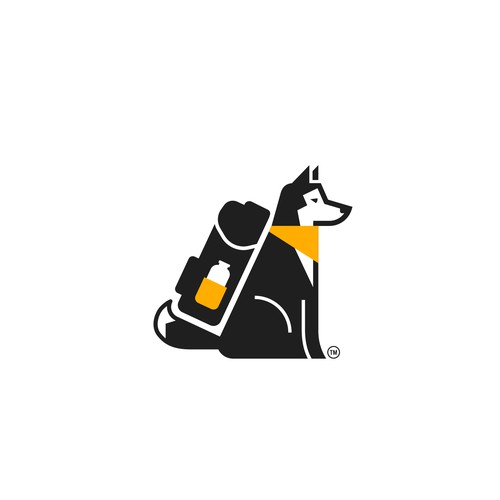
World Playground
Logo + Branding

Logo design

Simple logo design for spa resort
Simple logo design with airplane instead of a symbol +

Japan-based cat travel blog determined to help people enjoy Japan with their feline friends.
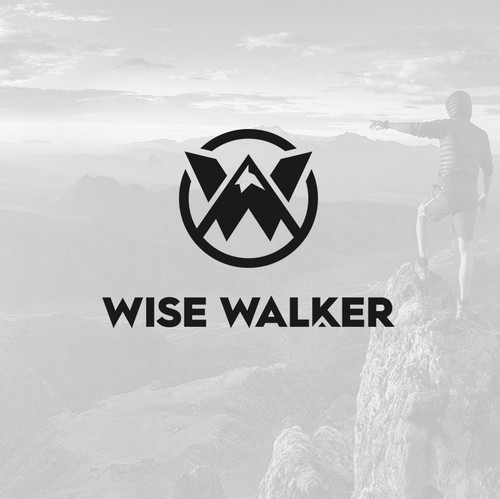
Smart and Strong Mountain Logo
WiseWalker is a company based in Switzerland specialized in intelligent travel and outdoor accessories. WiseWalker stands for well thought-out travel / outdoor products that set themselves apart from ordinary no-name products with special materials, smart/unique features, attractive packaging and beautiful designs. Smartly combining a mountain motif with the initial letter W, this simple and strong logo fits perfectly with WiseWalker's claim to make the smartest and most beautiful products. I can't wait to get my hands on the first of them - with my logo on it. :-)
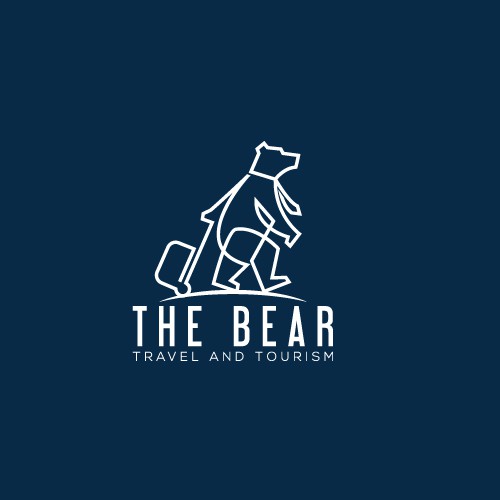
Minimalist Logo for a Travel Agency
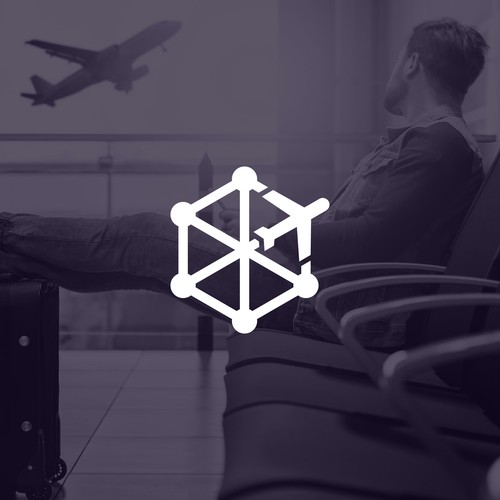
Atomium Plane
Logo Proposal for a Belgian travel agency, they asked for a subtle use of one of their biggest landmarks, The Atomium, so I found this modern and subtle solution by integrating a plane taking off into the sky within the line-work of the landmark.

EAD Aviation
Simple and effective logo design for a private jet company, with a custom treatment on the typography by working in a minimalist plane illustration hidden inside the negative space of the "A" creating a simple, balanced and bold logo design.
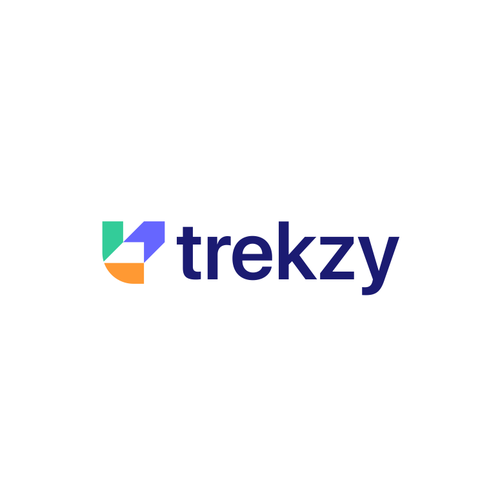
letter t + departure arrow
We are an Online travel agency that sells customized private tours around the world. the logo has to be the center of the brand so it is very important. If possible we would like an Icon that can be used in several places. Thanks. important, we do not sell flights, we sell tours.

geometric airplane
To be the amazon of vacations with wide reach and consistent experience for customers who want to take vacations. Creation of a strong internationally recognizable brand. TripFactory is a dynamic and modern brand, it matches the spirit of the audience. It looks stylish but also is bright to standout. After all TF is about emotions and impressions. and also about manufacturability and flexibility to do your own thing.
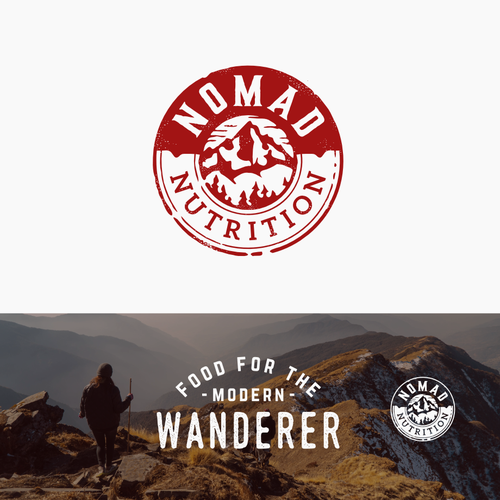
Nomad Nutrition
Logo for Nomad Nutrition
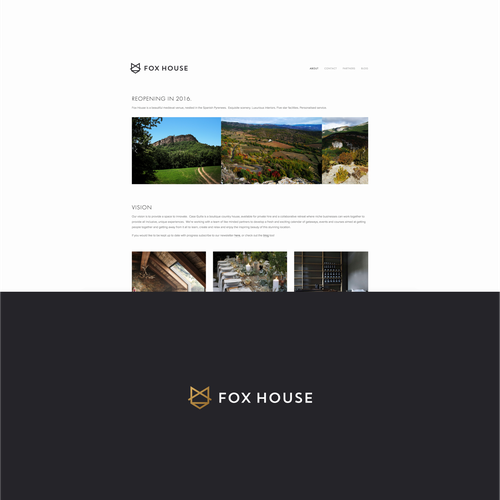
FOR SALE - E + Destination
Hey :) This logo doesn't have a home yet, if you're interested in adopting and growing it into a successful brand it can be yours for only $299! A lifetime warranty that includes minor revisions is also included!
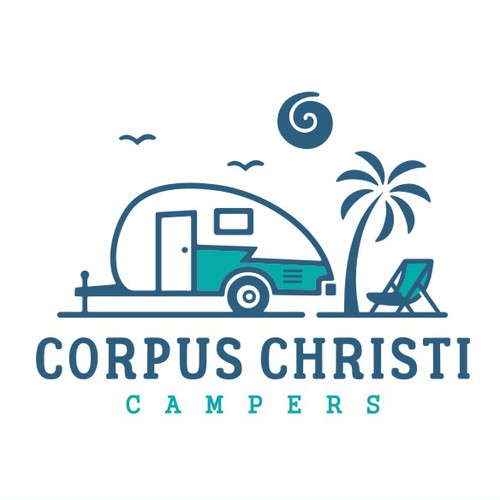
Logo & Brand Identity Pack for Corpus Christi Campers
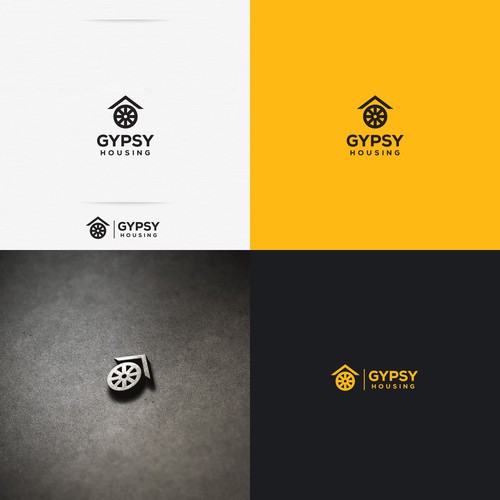
Logo Design for Gypsy Housing
Clear and minimalistic idea with wheel and roof

Five cruiser ships make a star with floating waves
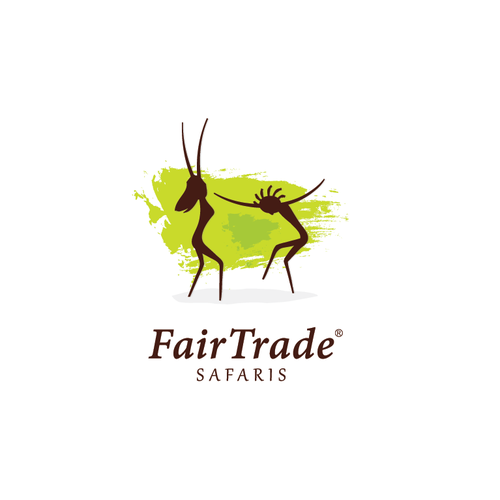
Concept for African Safaris with animal and cultural "journeys"
Based on African tribe dancing and antelope incorporated in a smart and clever way. You need to take a second look to see the idea behind.
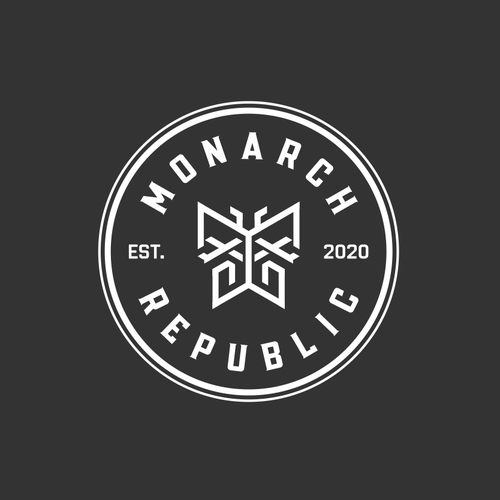
the concept of monoline with the combination of a butterfly and an airplane.
This brand is for people who love all things travel. It's all about pushing people to get out there to explore, wander, discover new things, create once in a lifetime experiences, go outside their comfort zone, and make friendships through travel. It's for anyone who wants to express their love for travel and adventure through the clothes they wear.
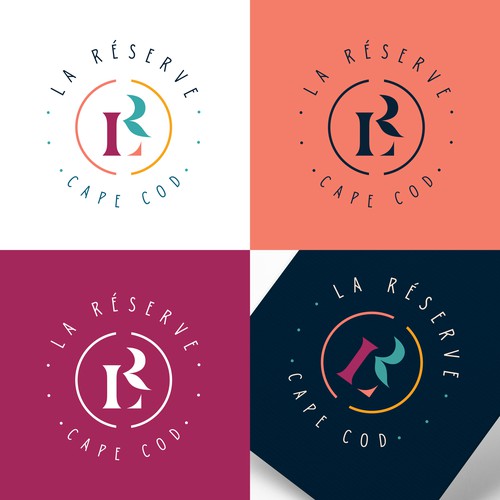
Elegant monogram/seal vacation rental company.
Clean & Sophisticated typography emblem for Cape Cod vacation rental company.
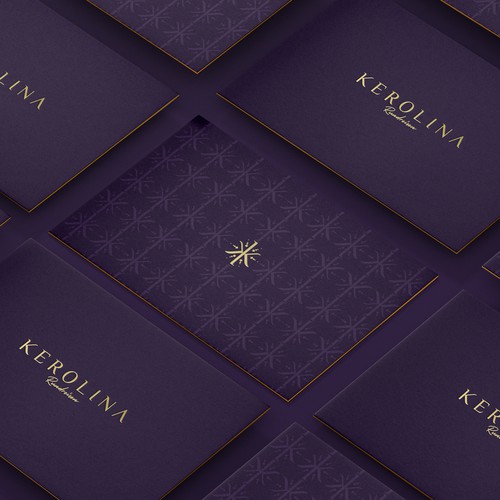
High quality logo for global premium and luxury travel provider
kerolina Urlaubsreisen is a global provider of premium and luxury travelling focusing on high quality tourism.
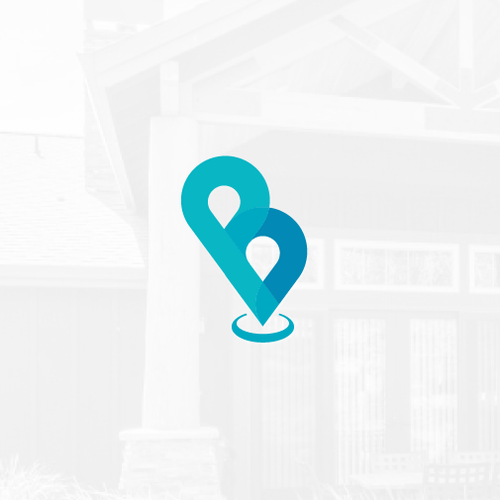
Bennington Properties Logos
Concept: pinpoint + B +P (company name first letter)
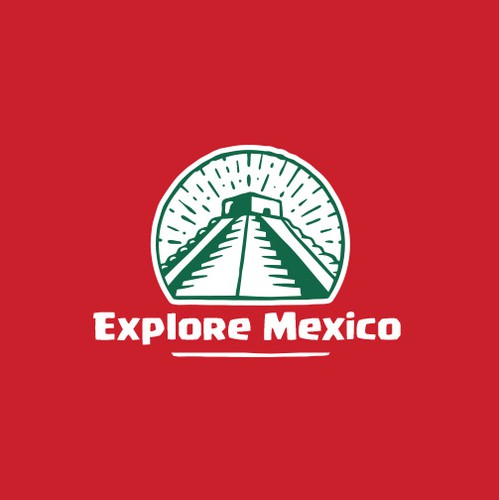
Explore Mexico
Explore Mexico is a tourism business focused on US travelers looking to discover all that Mexico has to offer! The idea was to incorporate some famous touristic landmark (a Mayan temple here) which can be placed on different destination photos in Mexico.

The Summer Club
Logo Design for a travel community 'The Summer Club'

Travel and Tourism Logo
Travel and Tourism logo
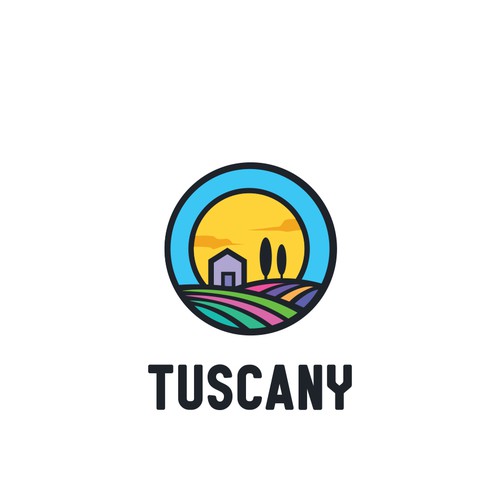
Tuscany Logo Design
Unsold logo design.
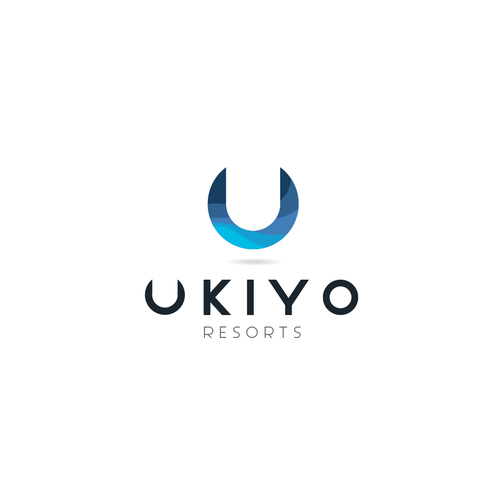
UKIYO Resorts
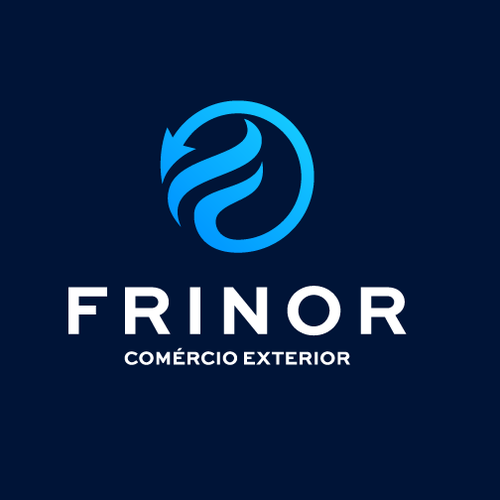
Frinor logo

Rustic Modern Camp logo
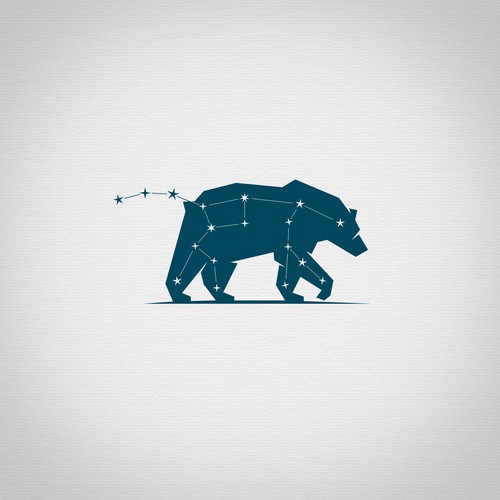
The Bear - Ursa Major!
The bear is at first made out of polygons which later helped in applying the negative space on the legs, ear and forehead. I then combined it with Ursa Major constellation to make the connection with the travel industry. Logo is still available. You can contact me for details.
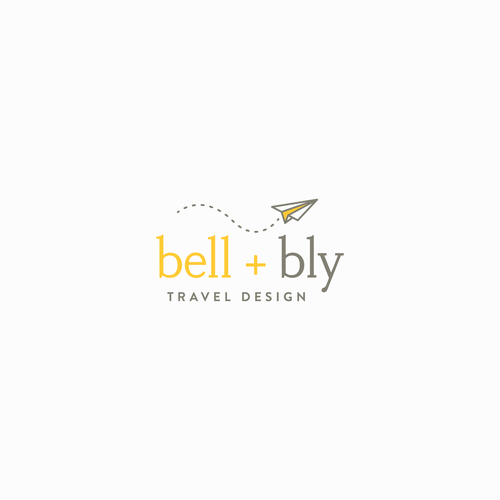
bell + bly Logo Design
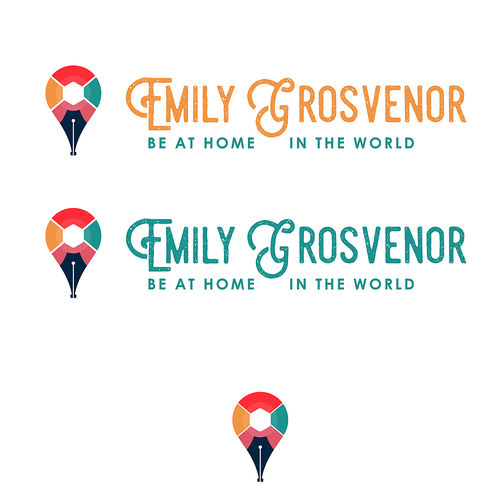
Vintage personal logo for travel writer.
Combining the location pin, a hotair baloon and a pen into a minimalist and memorable design, using a vintage yet youtful color palette.
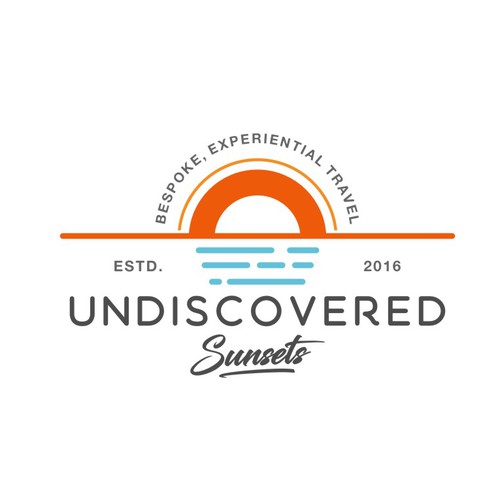
Logo Concept for Undiscovered Sunsets
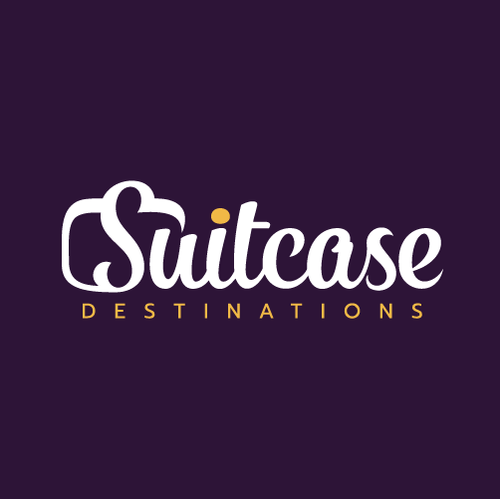
Suitcase destination logo
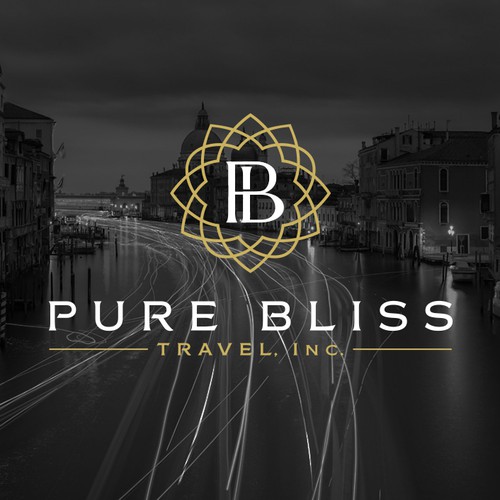
Logo for luxury travel company
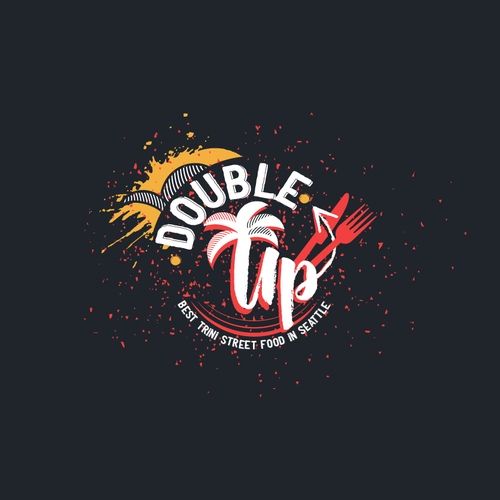
Unsold! Available for sale with your custom lettering and revisions. Logo for a Trinidadian street food shop specializing in a vegetarian dish called "DOUBLES".
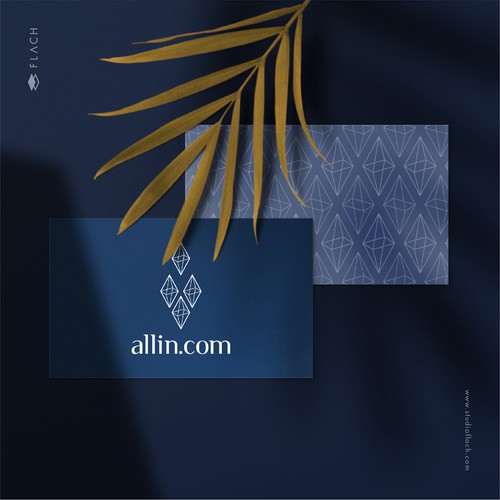
Logo and brand identity pack for online travel company focused on all inclusive vacations.
Taking time away from the job can have physical and psychological health benefits. That's what everybody knows and there are many fields and scientific studies about it. So, we want with the logo to provoke the right feeling in your customers. After all, they are deciding to whom they will trust the task of finding the perfect vacation for their families. This logo targets the high-end public, seeking for a sophisticated service planned just for them. The geometric and abstract representation of "pieces coming together" to form a true precious stone evoke the feeling of trust, professionalism, and care. The sophisticated logo is accompanied by a font with subtle details, showing the business' attention to details. It's a sophisticated and meaningful logo that excels at "speaking to your customers". If the logo could talk, it would say: "We take care of all the details of your vacation. All you have to do is relax and enjoy our personalized vacation crafted just for you.".
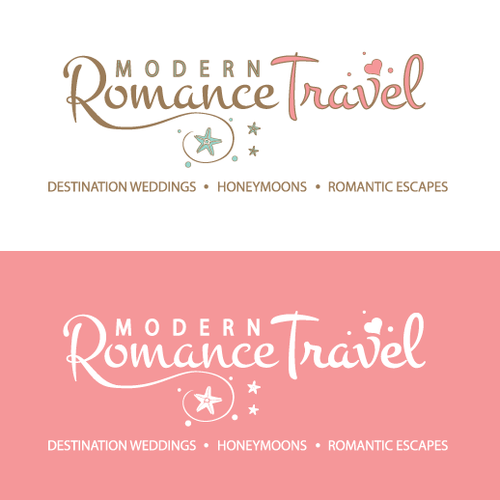
Logo for destination weddings, honeymoons, and family getaways
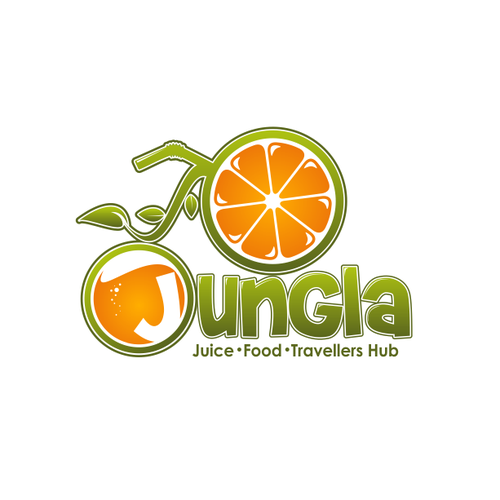
Bold logo concept for Jungla
Jungla is selling juice and rent a bike
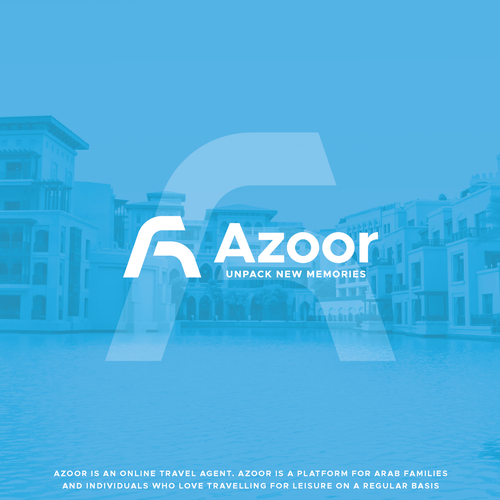
Online travel agency logo
*Design is for sale Design is initial-based, client has travel agency and did not want standard symbology - planes, suitcases or anything of the kind, and wanted simplicity, so I came up with initial-based timeless design, no ties to trends or anything that could make it outdated overnight.
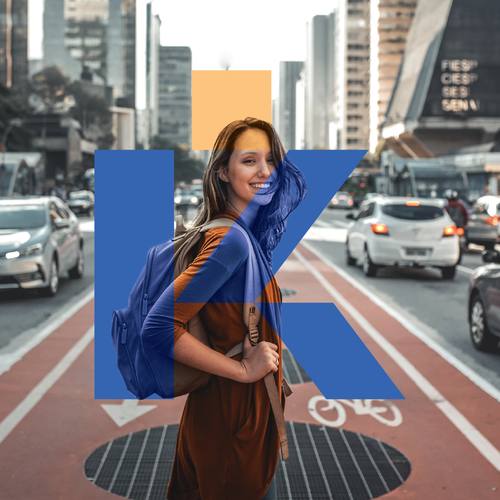
Travelling company logo design
*Design is for sale Logo was designed for a company what has a slogan that says "At the beginning is the human being". This was the basis of my design, I have incorporated the K letter and the figure of cheerful human to produce this modern and characteristic symbol to depict the identity of the company.

Logo for boat hire company in Noosa Heads
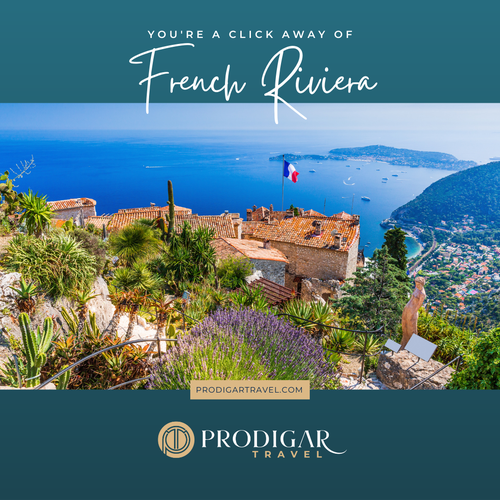
Logo re-design and Branding Pack for travel consultancy business
We had the pleasure to work on the Prodigar Travel branding and we love every single item we created for this business and it is truly difficult to choose just one item to display in our portfolio. Here is one of the social media templates we created for Instagram and Facebook use.
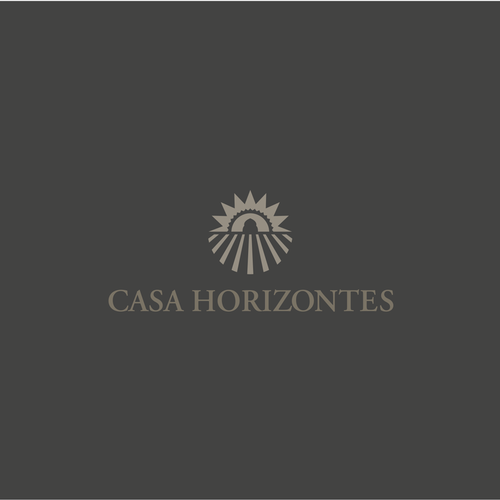
guesthouse in paradise
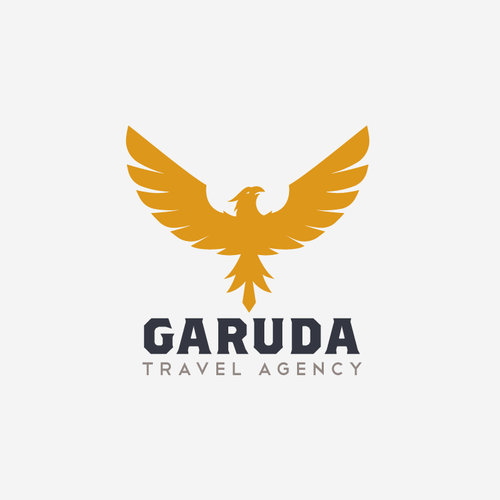
Logo for Travel Agency
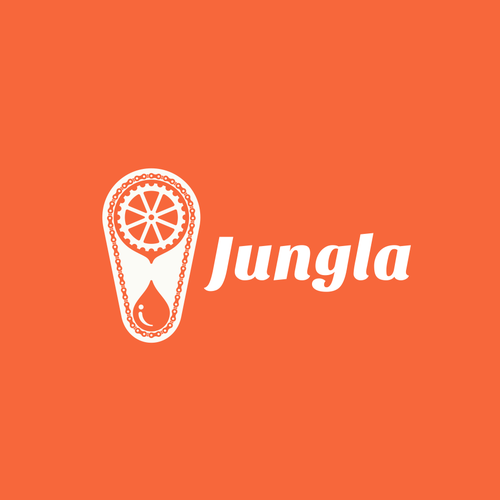
Logo for juice bar and bike rent
Jungla is a juice bar, healthy food, bike rental and travelling hub. The idea was to mix a bike gear with a fruit and a drop of fresh juice.

Handpicked brand identity
This project is for a travel and lifestyle brand, quirky and fresh.
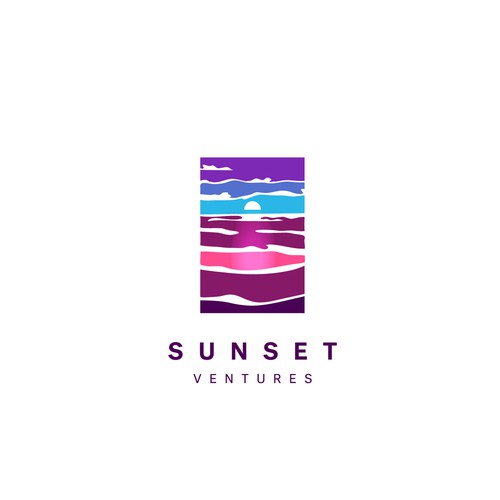
Art logo for Sunset Ventures
Sunset Ventures is a company investing in the tourism industry. It develops
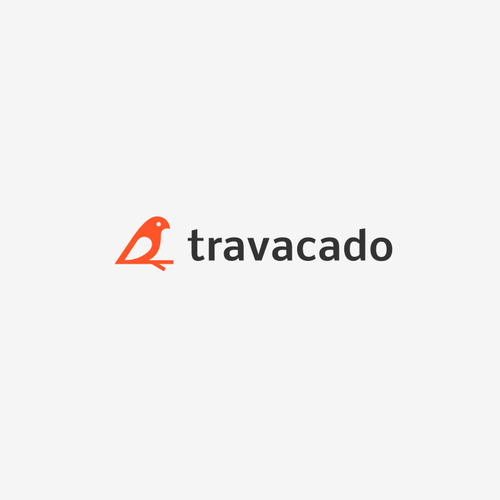
Logo for sale
Birdie birdie. For inquiries please visit portfolio / services-

Logo for a French Commune
The logo is based on the official bird of the area, it combines a strong modern font with a hand drawn Swallow.
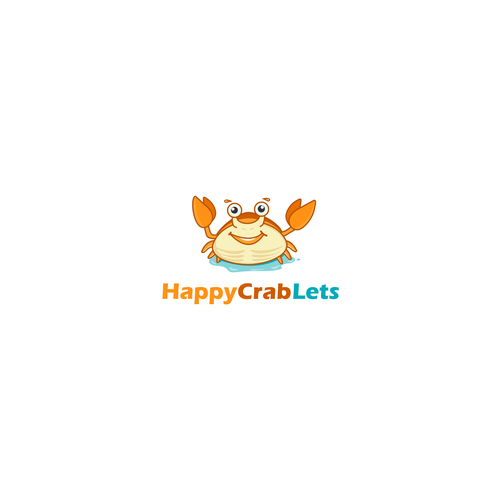
Happy Crab Lets - Travel & Hotel Logo Proposal
Property letting company in Cornwall. Our homes are beach nautical relaxed style and normally located by the sea (often with sea views). We have both houses for holidays and also 6-12 months lets. Happy crab i n the beach illustration.
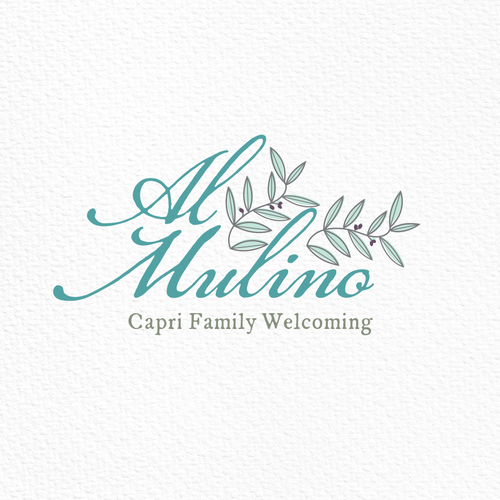
Logo for Boutique Family Hotel in Italy
The Al Mulino is a boutique, family-run hotel on the island of Capri, where olive trees and lemons and flowers are a-plenty. I paired a stylized olive branch with a gorgeous font that feels very "old world" (and yet still modern!), and colors that remind us of the beautiful Mediterranean.
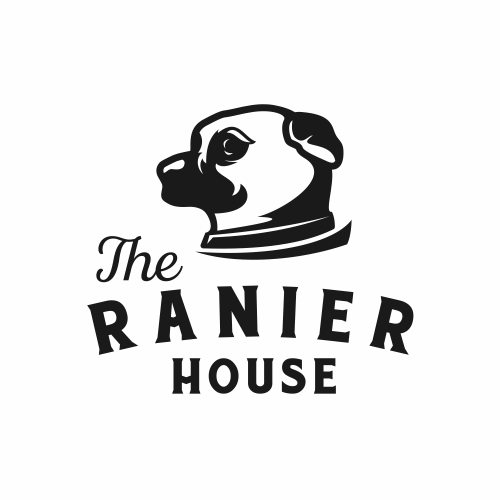
The Ranier House
we set out to build a home and develop a property that is located southwest of downtown Fort Worth.
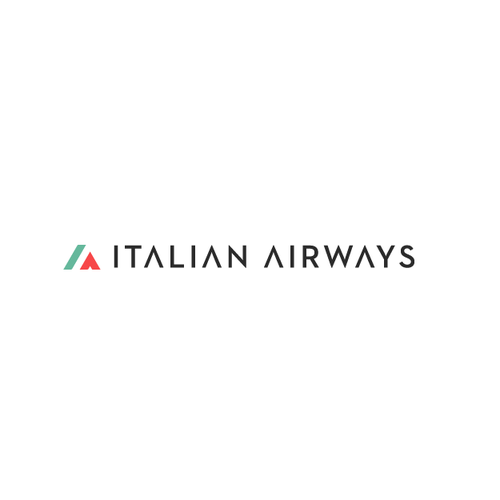
Timeless Logo for Italian Airways
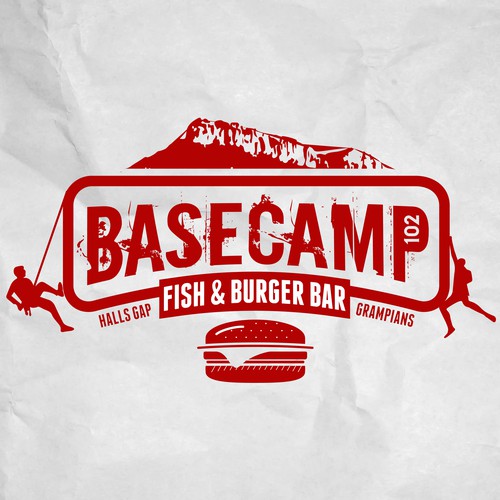
Rugged identity for outdoor burger bar.
Situated in the Grampians Nation Park, Australia, Basecamp 102 is a casual, comfortable and friendly little place to eat, drink and explore different extreme sports and enjoy the view.
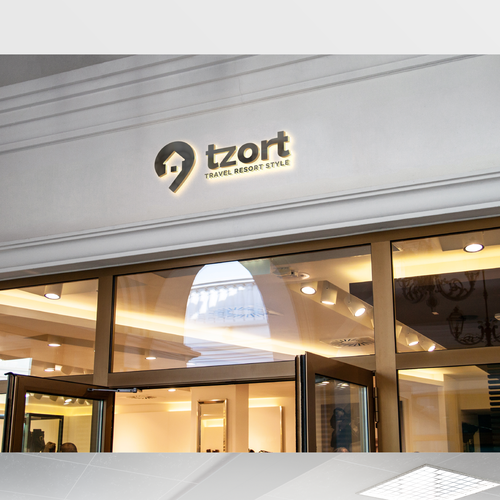
Travel resort
For the company I constructed a negative space layout between a map pin and a house. The house sits withing a long shadow that uses the negative space to give itself a shape.
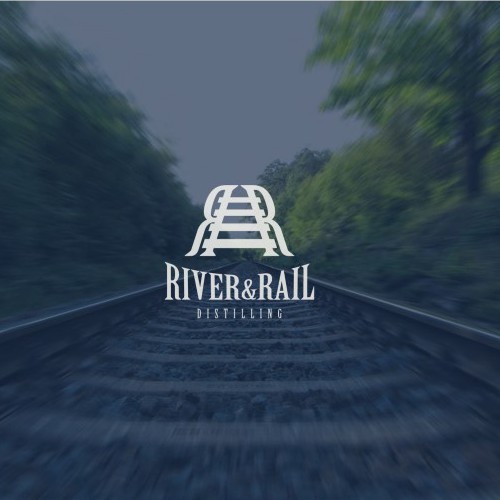
Rail logo for comapny named River & Rail. Shape combine two R letters and rails...
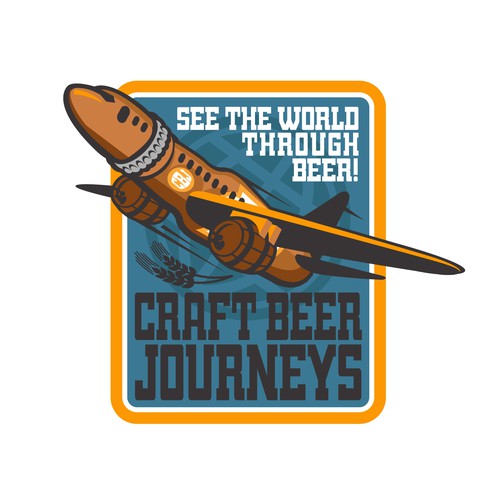
Craft beer Journey Logo Design Entry
I think the design speaks for itself. Craft Beer Journeys with elements of the craft focused on the brewing industry.
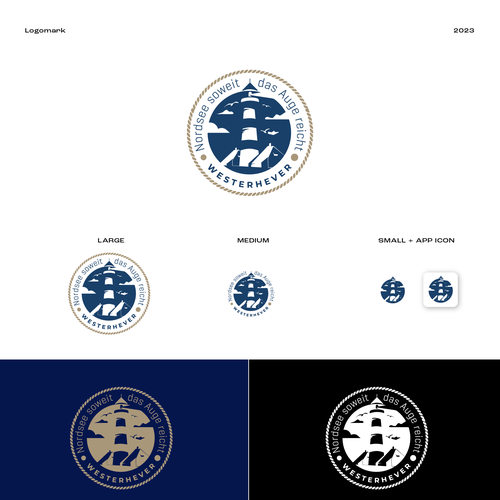
Northsea toursim logo
The logo is a depiction of a typical lighthouse from the North Sea region of Germany. It is modern and plays nicely with negative space. The lines of the lighthouse and houses are professionally drawn with attention to detail. The logo is for sale at a nice price, so let me know.
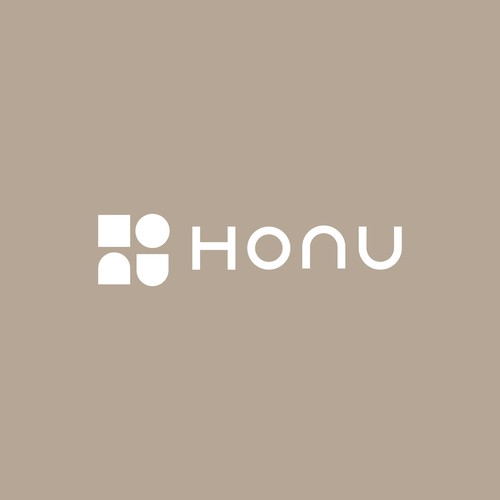
Scene-A-Roo
A small tour business, offering one day tours out of Melbourne in English, Japanese and Spanish. A smiling kangaroo and a joey in the pouch are taking a selfie at the twelve apostles. It's an eye-catching and funny logo which will appeal to people of all age
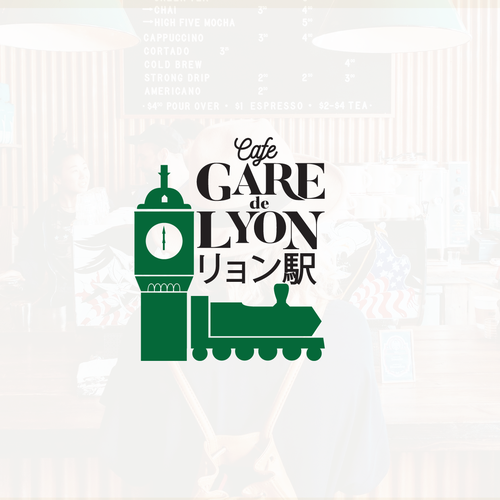
Logo for a journey
Client wanted a logo for a Tokyo cafe to express travel/journey yet maintain environmentally friendly vibes. Greens are used to express both. Although iconography is simplistic, combined elements put focus on the customized typography for a timeless look.
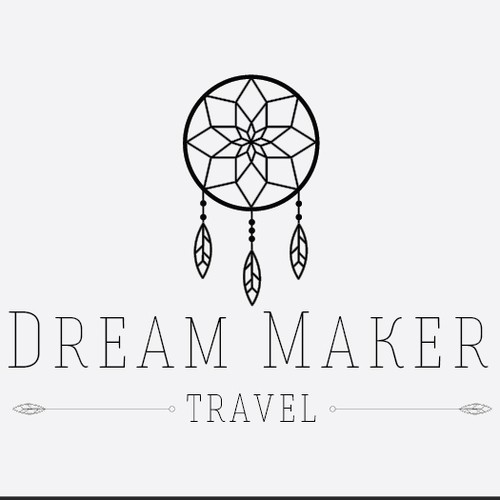
Create a luxury experienced-based travel company's logo & design
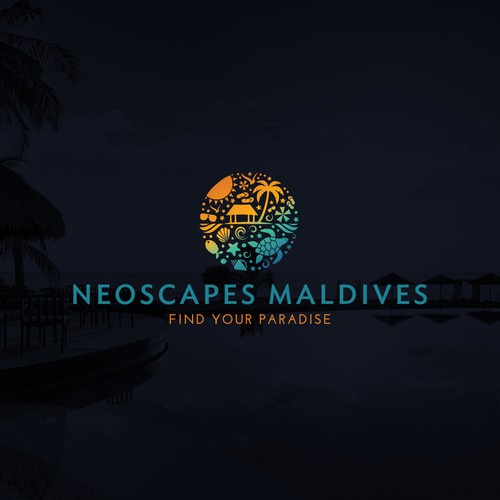
logo for a travel company in the Maldives

Logo design with skipjack mascot for vacation rental business
playful logo design that using skipjack fish as the logo with happy feel.
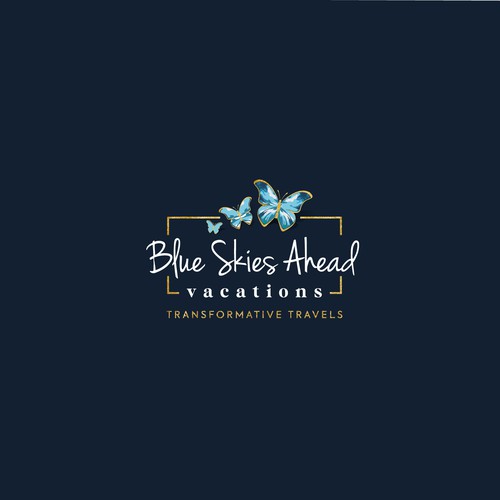
Blue Skies Ahead Travel agency logo
Client wanted a butterfly to represent the business, as a symbol of transformation, so the design is based on three butterflies transforming from the small blue colored butterfly to the butterfly with wings colored as a blue sky horizon.
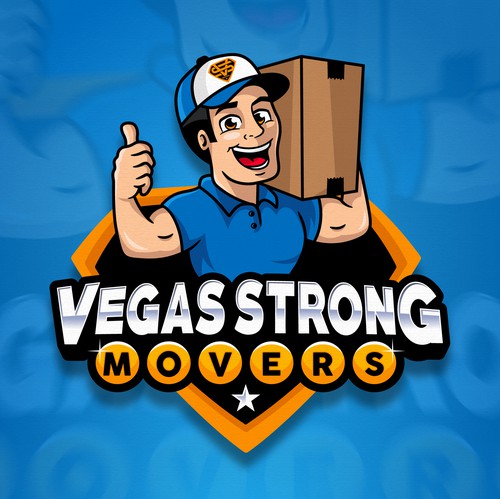
Logo/Mascot Vegas Strong Movers
I love Las Vegas, I hope to visit her sometime, we loved working with this client from Las Vegas, since he has a moving project which we made him a super fun character, a sketch of the character was made and it was approved in its entirety, delighted we remain on both sides.
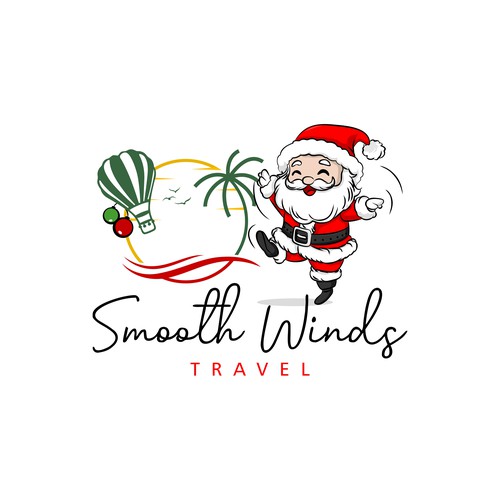
yet another Cancelled Contest and my 3rd submission for it.
on this ne I set the Bear simply on a Jet with Back-Pack.
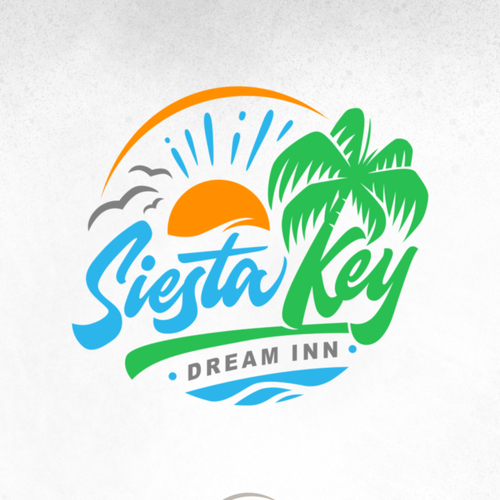
Siesta Key Hand Lettering Logo
Always Hand Paint
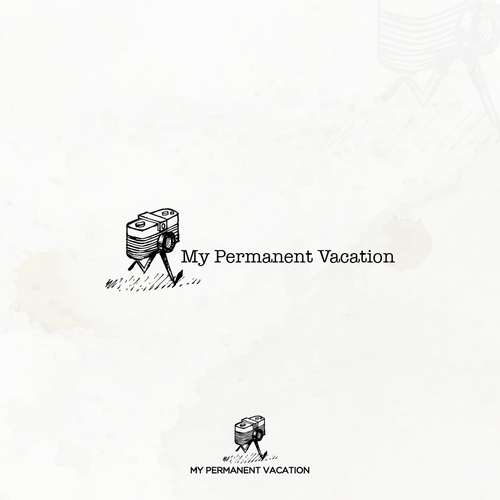
Logo for travel photography blog
Well the title is pretty descriptive. What would be more obvious for a travel photographer logo than a walking camera?

Peak Power logo

The Silicon Valley Post
Web News about technology!
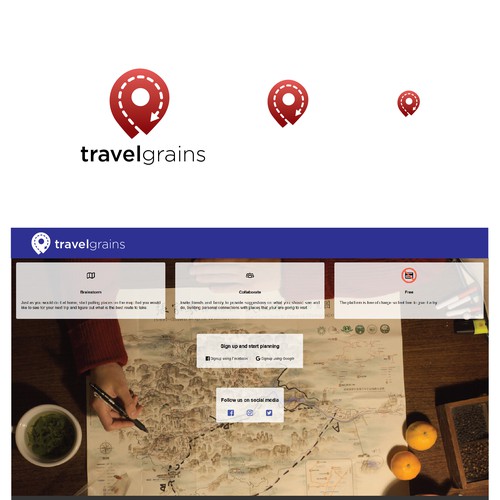
TravelGrains
CH want a logo to speak about travel experience. I came with idea of traveler that visit a different place (show with multiple tip) and share their experienced (show with dash line or as a grains)
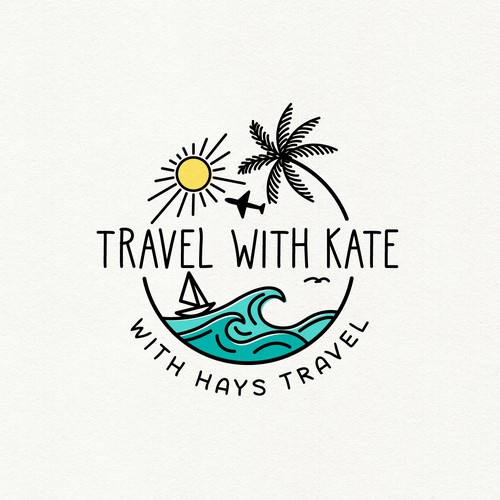
Travel with Kate
Travel Agent, Sells cruise, long & short haul, honeymoons & weddings abta and atol protected

Flower/Star/Seastar logo symbol
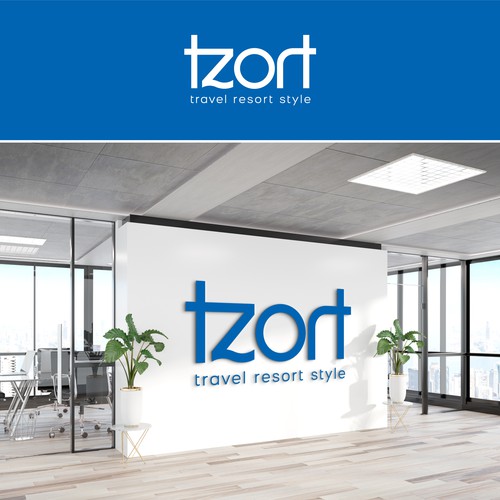
positive, minimal, sophisticated brand
Winning entry for Logo and Branding Contest for a Luxury Travel Company

Logo for Travel & Hotel
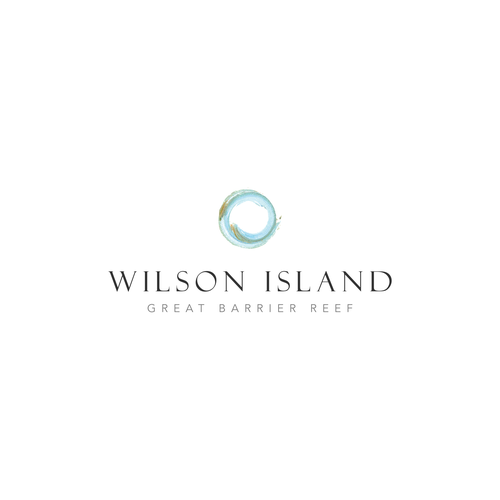
Wilson Island

Logo for a restaurant and hotel
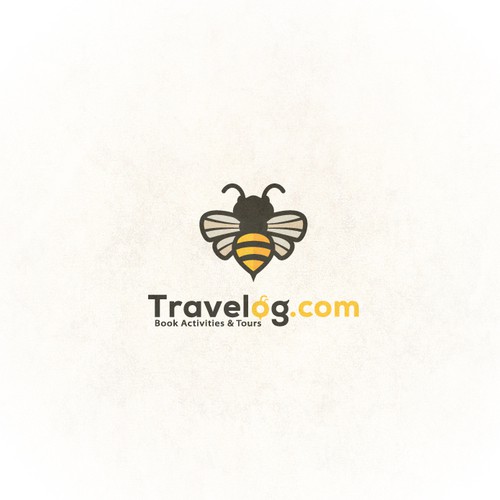
Travelog logo
bee logo for travel company
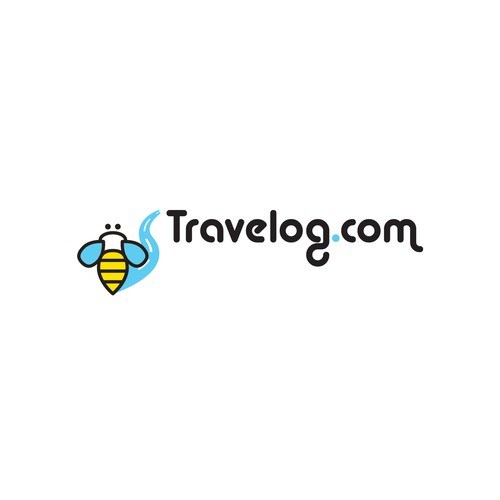
Concept logo for Travelog.com
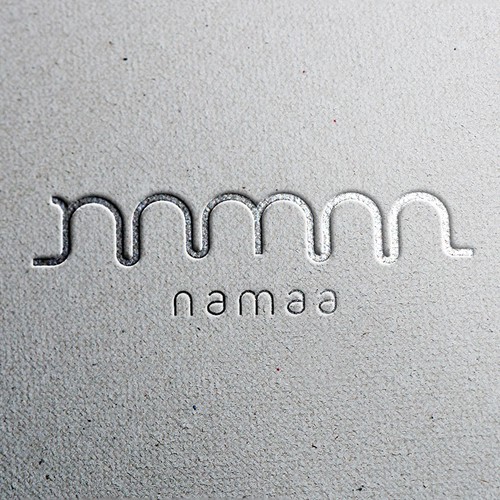
Contest entry for a innovative luggage logo
A logo for a new and innovative luggage. I based my design in a travel experience. "travel comfortably" The logo "icon" was inspired by a skyline + an airplane path.
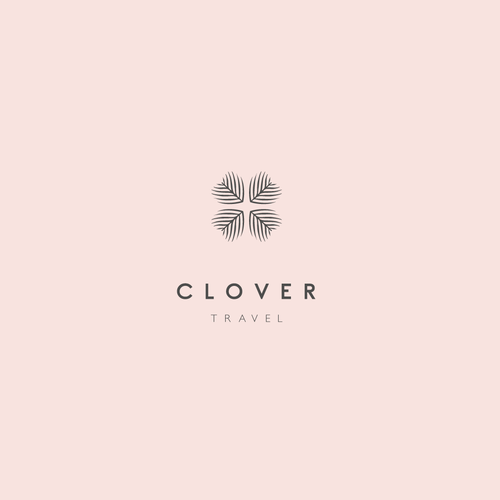
Travel advisor logo design
Palm leaves inside a clover. Ireland and California united :)
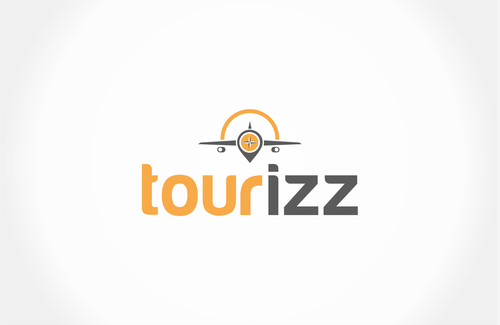
create a fresh creative brand identity for travel
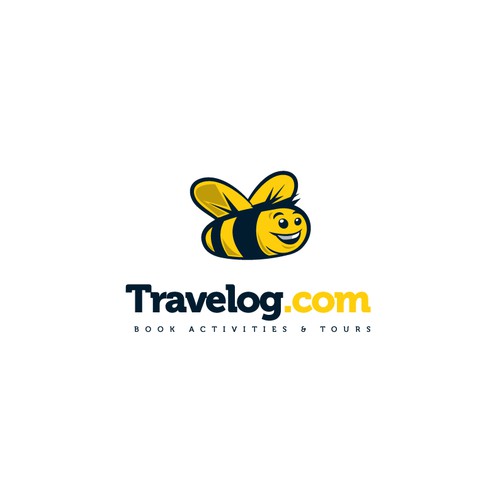
Logo for Travelog.com
They are travel marketplace, user can sell & buy activities, tours on this website.
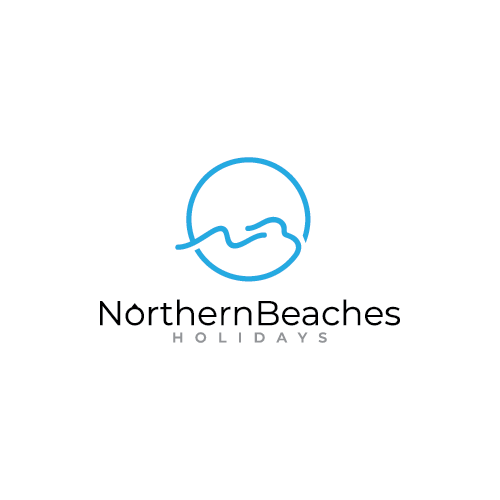
Winning logo for Northern Beaches Holidays
Clean modern design including sun waves in abstract shape that forms alphabet "NB" for Northern Beaches.
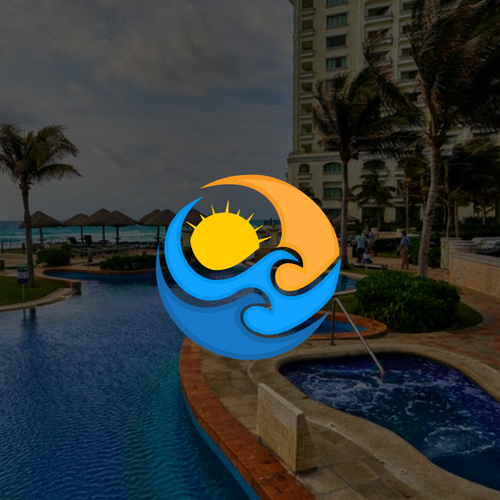
RadPadz Logo
Logo for vacation rental and short term rental provider with element sun and wave
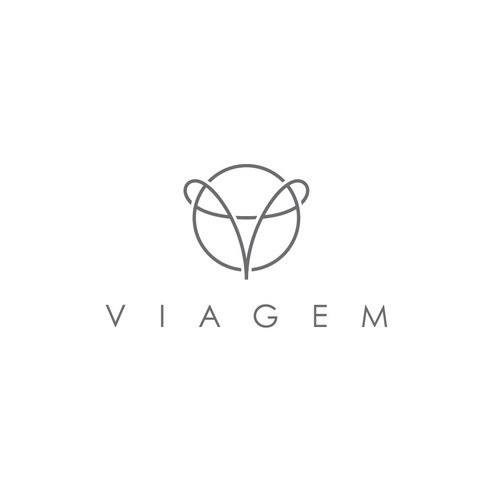
Logo Viagem
Convenient, well designed and homely apartments in prime urban locations for short term rent for couples, families. Short Term rental company with high apartment standards and amenities offering a new way to stay in your favorite areas and providing the comfort of your home with hotel style service.
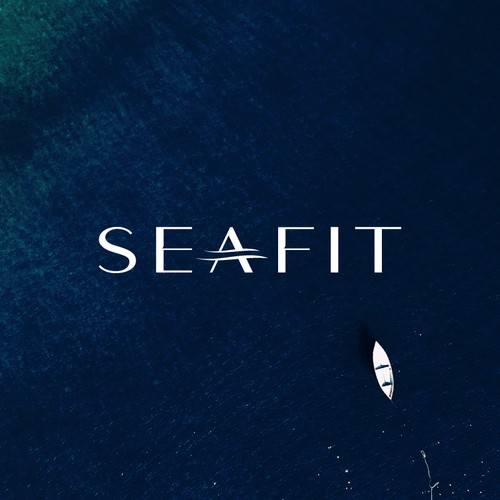
Logo & Identity for Fitness Yatch Charters.

Colourful Stryder Travel logo
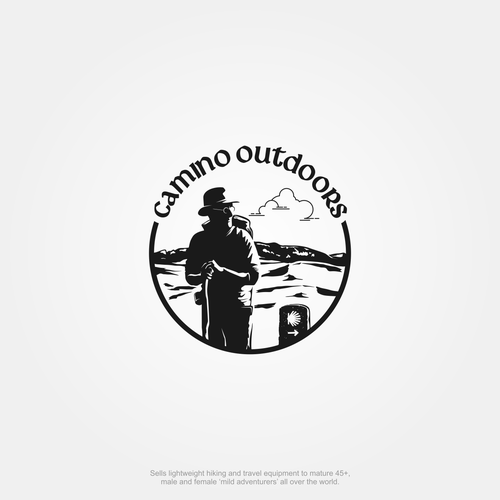
Camino Outdoors
Sells lightweight hiking and travel equipment to mature 45+, male and female ‘mild adventurers’ all over the world.

Create the visual identity for a new startup (tourism)
Startup aims at connecting like-minded people who are looking for travel friends and want to meet them before they go on vacations together.

Re brand a travel photography company
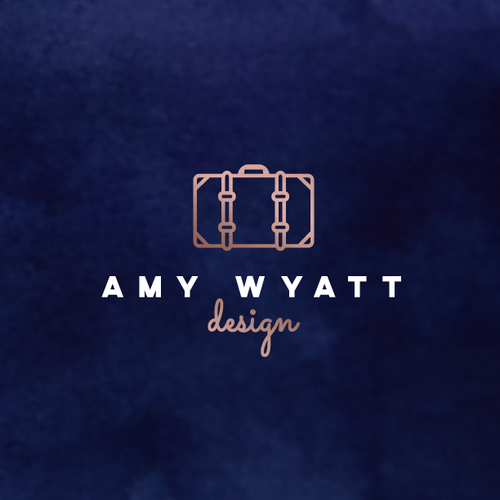
Luxury Travel Design
Logo for a tailored journey designer
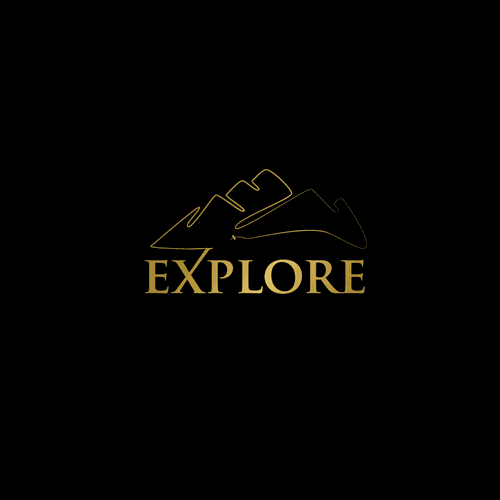
Create a New Logo for Bespoke Travel Company
the company specialist tour operator based in Queenstown. offering bespoke Skiing, Fishing, Shooting and Expeditions. my thought was to create something with Expeditions gear and nature. i made the mountain with fishing steering.

Travel brands not a good fit? Try something else:
How to create your travel brand design.
If you want an amazing travel brand that stands out from the competition, work with a professional designer. Find and hire a designer to make your vision come to life, or host a design contest and get ideas from designers around the world.
Start a contest
Designers from around the world pitch you ideas. You provide feedback, hone your favorites and choose a winner.
Start a project
Find the perfect designer to match your style and budget. Then collaborate one-on-one to create a custom brand.
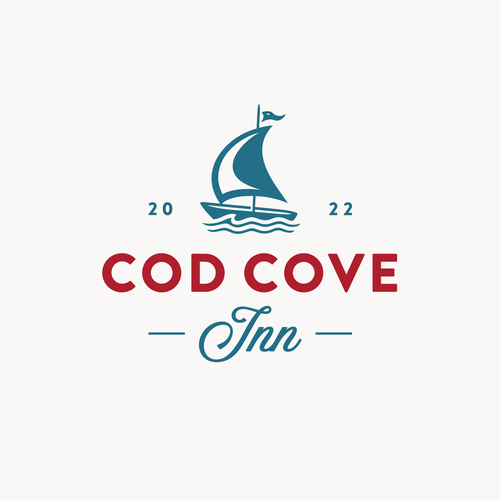
4.9 average from 119 logo & brand identity pack design customer reviews
What makes good travel brand?
Great branding shows the world what you stand for, makes people remember your brand, and helps potential customers understand if your product or service is right for them. Branding communicates all of that through color, shape and other design elements. Learn how to make your travel brand tell your story.
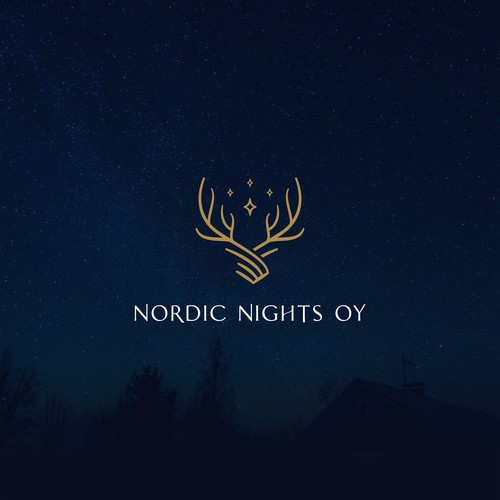
Branding trends Discover stunning branding trends and find out what's new in the world of brand design… Keep reading
How to develop a great brand identity Creating a great brand identity can be complicated. This guide will walk you through the branding process step-by-step… Keep reading
Branding colors Choosing the right branding colors can highlight your business’s strengths and help you attract the right customers… Keep reading
Travel invented loyalty as we know it. Now it’s time for reinvention.
Travel brands didn’t invent loyalty programs, which have been traced to as far back as the 18th century . 1 James J. Nagle, “Trading stamps: A long history,” New York Times , December 26, 1971. But ever since the first major airline frequent flier programs appeared in the early 1980s—soon to be followed by similar programs from hotel chains—the travel industry has become known for letting customers accumulate redeemable “miles” and “points.” Modern-day voyagers are deeply familiar with loyalty-related concepts such as status tiers, members-only lounges, and point-earning credit cards.
Travel loyalty programs were originally designed to influence travelers’ behavior. By offering rewards such as free flights and hotel rooms to frequent customers, a company might convince power users to consolidate their travel spending with its brand. Why fly airline X when you’re halfway to earning a free perk for remaining faithful to airline Y?
Over time, many travel loyalty programs became wildly successful—not just as a way to boost sales or strengthen customer relationships but as major profit centers in their own right. Travel companies found they could sell loyalty points in bulk to, for instance, banks, which in turn offered the points to their credit card customers as rewards for spending. In 2019, United’s MileagePlus loyalty program sold $3.8 billion worth of miles 2 Brian Sumers, “How is United Airlines’ loyalty program worth $22 billion?,” Skift, June 15, 2020. to third parties, which accounted for 12 percent of the airline’s total revenue for that year. In 2022, American Airlines’ loyalty program brought in $3.1 billion in revenue, and Marriott’s brought in $2.7 billion. 3 Form 10-K, fiscal year ending December 31, 2022, American Airlines Group, Inc.; Form 10-K, fiscal year ending December 31, 2022, Marriott International, Inc. Many loyalty programs have evolved into discrete divisions with their own profit-and-loss ledgers.
Along the way, however, some travel players have shifted their focus away from the original purpose of these programs. As loyalty programs have become powerful bottom-line enhancers, companies have sometimes been tempted to view them first and foremost as revenue generators instead of tools to sway customers’ behavior or to improve customers’ experiences . The postpandemic resurgence of travel demand has also pressured companies to shore up their loyalty programs’ viability by devaluing members’ points and miles and enacting rule changes that have at times caused customer frustration. At the same time, innovative loyalty programs in other industries are raising the bar, opening customers’ eyes to the value that loyalty programs can offer.
As a result of these factors, travel loyalty program members have become increasingly disloyal. For some customers, reaching the top tier of a loyalty program is still almost a facet of their personal identities—“Just a couple of more flights, and I’ll reach elite status!” But many loyalty program members now seem more inclined to play the field. The warm feelings at the heart of loyalty, which lead travelers to show allegiance to a brand and trust that their faithful behavior will be noticed, seem to fade when brands let their focus drift away from rewarding their most valuable and consistent customers.
Loyalty is about more than a program, a department, or a tangible redemption offer.
Loyalty is about more than a program, a department, or a tangible redemption offer. True loyalty is won through a genuine desire to forge bonds with customers and thereby maximize each customer’s lifetime value to the brand. Travel brands, therefore, should consider rethinking and reinventing their loyalty programs in ways that frame loyalty as something more than points and miles. A mindset shift, coupled with three practical actions, could help restore the luster of loyalty programs while bringing straying customers back into the fold.
A mindset shift, coupled with three actions, could restore the luster of loyalty programs while bringing customers back into the fold.
How we got here: Disruption, devaluation, and dissatisfaction
When travel came to a halt as a result of the COVID-19 pandemic, many travel brands—hoping to keep customers happy—“froze” the loyalty program status levels of members who might have otherwise lost perks due to a lack of travel activity. When travel spending was slow to resume, brands changed their program rules to make status tiers significantly easier to reach and maintain. These moves made sense in the face of an unprecedented disruption, with far fewer miles and points being redeemed.
But as travel recovered, loyalty programs became burdened by increased redemptions and overpopulated high-status tiers (evidenced, for example, by the lines outside the doors of airport lounges). Some major travel brands have responded by adjusting loyalty program rules. They’ve ended the status extensions that were granted during the pandemic, and they’ve devalued points and miles—raising the bar to redeem them for free flights and rooms.
All these changes have, understandably, been made with an eye toward programs’ profit-and-loss statements. But collectively, they’ve resulted in widespread customer dissatisfaction. Program members have chafed at having their points devalued and benefits clawed back. Meanwhile, successful loyalty programs in other sectors have opened customers’ eyes to other types of value that these programs can provide, such as better customer experiences, richer communities, more tailored personalization, and exclusive access to events or offers.
Loyalty surveys conducted by McKinsey in 2021 4 The 2021 loyalty survey of roughly 10,000 American consumers covered multiple sectors (including airlines, hotels, cruise lines, banks, retail, grocery, and others). and 2023 5 The 2023 loyalty survey of 3,200 American travelers covered the airline, lodging, and cruise sectors. revealed a steep decline in the likelihood that a customer would recommend airline, hotel, and cruise line loyalty programs to a friend or colleague—even though the likelihood that customers would recommend the airline, hotel, and cruise line brands remained relatively steady (Exhibit 1).
A focus on a loyalty program’s bottom line can distract from its higher purpose
A travel loyalty program might be able—at least temporarily—to disappoint its members while inflicting minimal damage on its company’s earnings. This is because so much of a modern travel loyalty program’s importance comes from B2B sales of batched points or miles. The programs’ most relevant customers in terms of generating revenue are credit card companies, not individual travelers. And these B2B deals generally involve long-term contracts that guarantee sales years in advance. A travel brand can unilaterally issue more loyalty program points to sell to third parties at any time, as well as raise the redemption levels for flights or rooms if margins become undesirable.
Meanwhile, airline travelers have fewer options than they did in the past. Consolidation of major airline brands means it’s harder for frequent fliers to abandon one airline and its loyalty program for another without losing access to convenient flight routes or departure times. And customers who have already banked a large number of miles or points with one airline or hotel program can feel locked in.
For all these reasons, loyalty programs appear to be in a position of strength. But a narrowed emphasis on revenue and costs could lead to brands’ losing focus of the big picture. Travel loyalty programs were originally conceived as a clever way to influence customer behavior—and encourage customer loyalty. But it’s not clear if the programs are currently fulfilling either mandate as successfully as they could.
McKinsey research reveals that airline loyalty programs’ ability to change fliers’ behavior declined between 2017 and 2021, and again between 2021 and 2023 (Exhibit 2). During those time frames, it became less likely that a customer who was a member of a given airline loyalty program would report that they chose the associated airline over other options or increased the frequency of their spending with that airline. If this trend continues, it could eventually create a vicious cycle: airlines would cut loyalty program budgets if they deemed them ineffective at influencing customer behavior, lower budgets would lead to reduced program benefits, and less attractive benefits would result in customers perceiving program participation as having less value.
McKinsey research further shows that loyalty program members these days aren’t especially loyal (Exhibit 3). Hotel, cruise, and airline travelers are typically members of about three or four different loyalty programs within a given sector, our analysis finds. On a yearly basis, they consider traveling with about three different brands within that sector and ultimately transact with more than one of them. Travelers don’t even consolidate their spending with the brand they say they “prefer” within a sector: the median share of the customer’s wallet for preferred brands is only about 50 percent in lodging, 60 percent in cruise lines, and 60 percent in airlines—with the remainder of the customer’s spending spread around to other players within the same sector.
Evidence suggests this trend will persist. According to our 2023 survey on travel loyalty, younger generations are more likely to consider and transact with multiple travel players. Gen Zers and millennials consider about 1.7 times as many brands as do baby boomers and the Silent Generation and transact with about 1.3 times as many brands.
All this comes at a time when the travel loyalty market is becoming more competitive. Consumer banks, which were once content to offer cobranded credit cards featuring travel brands as the marquee partner, are now launching their own self-branded travel awards ecosystems and booking platforms. Travelers might wonder why they should put all their loyalty points in one basket with a single airline or hotel brand when a consumer bank might offer more flexible rewards redemption and possibly a better user experience. (It’s worth noting that our research suggests the likelihood that a customer would recommend some of the major consumer banks with travel loyalty initiatives to a friend or colleague is far higher than the likelihood that a customer would recommend a cruise line, lodging brand, or airline.)
How to reshape loyalty for a new travel landscape
Our research finds that experience —far more than tangible, “earn and burn” benefits—is what wins customers’ loyalty. Experiential factors, including “offering an experience worth paying more for” and “feeling taken care of,” have become more important over time and now account for three of the top five (out of more than 40) drivers of loyalty to cruise lines, hotels, and airlines. For hotels, experience has four times more impact than tangible benefits on purchase frequency, while for airlines, experience is more than twice as likely to influence frequency. Positive past experiences are the biggest factor in customers’ desire to travel more with a company in the future.
The following three steps could help travel brands adjust to this changing landscape and engender loyalty that goes beyond a mere quest for redemptions and perks.
Put experience at the core of loyalty programs
When our 2023 survey asked American respondents which company they’re most loyal to, Amazon received more votes than the top six travel players combined—despite the absence of any traditional, points-based loyalty program. How does Amazon win loyalty? By providing a frictionless experience.
How can travel brands learn from this and win customers’ love even when points and miles are worth less? By offering distinctive, satisfying experiences: making customers feel delighted is the key to their hearts, but McKinsey’s 2023 loyalty survey showed that only 20 percent of travelers were delighted by a recent travel experience.
Companies should strive to design loyalty programs around experiential benefits that make travelers feel special. This can be win–win, such as when Delta offered free in-flight Wi-Fi to loyalty members, which led to a better experience for the members while also boosting enrollment in Delta’s loyalty program. In retail, some programs bring together engaged communities of like-minded brand loyalists. Advance notice or exclusive access to offers can send loyalty members a signal that the brand considers them VIPs.
Brands should seamlessly integrate customer experiences between desktop, mobile, and physical locations—meaning that frontline workers have an important role to play. Proper execution of customer service is vital for getting experiences right, so companies should try to keep frontline workers top of mind. Workers should be given the proper training and tools to satisfy customers, and the effectiveness of this training should be measured.
When it comes to mitigating, or avoiding, a negative customer experience, saying “sorry” can go a very long way. Companies should proactively engage customers after service shortfalls, as a service challenge can actually lead to an increase in customer satisfaction if handled well. The form an apology takes might be made commensurate with a customer’s status level in the brand’s loyalty program, and any recompense can be informed by a predictive analysis of its impact —considering factors such as the magnitude of the lapse and the nature of the customer’s other recent interactions with the brand.
(Finally) use data to offer personalization to members
Travel brands have long had access to reams of customer data. Loyalty program members surf on travel companies’ Wi-Fi, sleep in their hotel rooms, fly on their planes, and cruise on their ships. But many travel brands haven’t yet captured the opportunity to use these unique data to offer their members personalization on par with other industries. Likewise, although airlines and hotels have incredibly sophisticated, lightning fast, AI-enabled pricing algorithms, they aren’t consistently harnessing their technology capabilities to power real-time customer personalization.
Nontransactional engagement opportunities, such as the daily interactions fostered by social communities, offer rich troves of data that can be used to hone personalization. In turn, personalization can drive engagement, as seen in Sephora’s Pocket Contour Class initiative, which lets users upload a selfie to get personalized makeup tips.
Personalization can be employed to tailor both experiences and offers for loyalty members. Our research has shown that 78 percent of consumers are more likely to make a repeat purchase when offered a personalized experience . The goal should be to achieve a hypersegmentation of program members that’s so nuanced, it results in a “ segment of one .”
Rethink partnerships to protect self-interests while delivering customer value
Since the 1980s, travel companies have been partnering with banks to launch cobranded credit cards. But several credit card brands now offer their own, self-branded travel rewards ecosystems. These ecosystems sometimes direct bookings to airlines, hotels, and cruise lines—but they can also serve as a way for credit card brands to steal away travelers’ loyalties. These types of transactional partnerships with consumer banks might eventually cease to be a winning play for travel companies. In time, travel loyalty programs could be driven to seek alternate sources of funding.
The best kinds of partnerships build richer connections with consumers while boosting engagement through thoughtful collaborations. Uber’s partnership with Marriott gives users the option to link the brands’ loyalty programs, tapping into two large customer bases and providing more convenient travel experiences.
One promising recent example of collaboration is a travel media network. A hotel company might, for instance, launch a media network that allows third-party brands to place relevant, nonintrusive, personalized advertisements in the hotelier’s owned spaces—websites, hotel lobbies, guest room TVs, and so forth. This type of partnership can offer travelers an elegant, curated experience while providing the travel brand with an alternate monetization route.
In general, travel companies should cultivate collaborations that protect their interests, generate new revenue streams, add personalization and value for loyal customers, and diversify touchpoints with those customers. Early action could prove vital here, as the travel space will not accommodate infinite partner ecosystems.
As other industries raise the bar and consumers grow increasingly dissatisfied with travel loyalty programs as they are designed today, travel industry leaders may need to ask themselves some hard questions. How can points and miles be paired with experiences and excitement? Which partners are truly adding value? What is causing customers to stray, and how can their loyalties be won back?
Travel brands were loyalty innovators. But travel loyalty programs might soon hit an inflection point. Now is the time to innovate and win back customers’ allegiances.
Lidiya Chapple is an associate partner in McKinsey’s Atlanta office, where Jillian Tellez Holub is a partner; Clay Cowan is a partner in the Dallas office; and Ellen Scully is a consultant in the Seattle office.
The authors wish to thank Bella Alfaro, Alex Cosmas, Marilyne Crépeau, Oren Eizenman, Austin Hack, Ryan Mann, Jacob Miller, Afiya Romeo, Matthew Straus, and Jamie Wilkie for their contributions to this article.
This article was edited by Seth Stevenson, a senior editor in the New York office.
Explore a career with us
Related articles.

Prediction: The future of CX
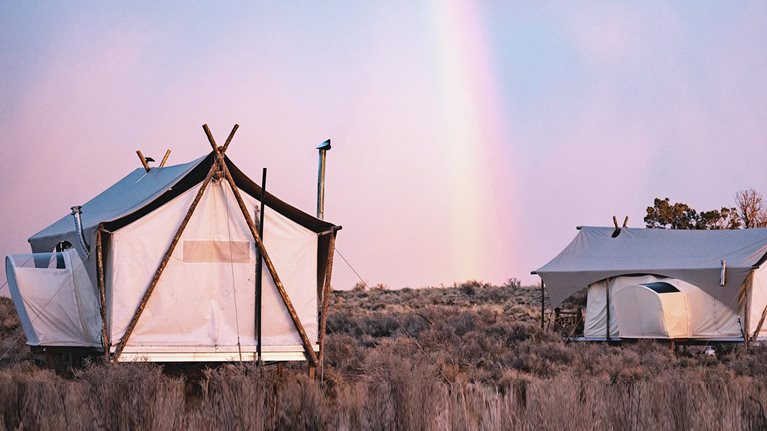
Rebooting customer experience to bring back the magic of travel

Experience-led growth: A new way to create value
- Search Please fill out this field.
- Manage Your Subscription
- Give a Gift Subscription
- Newsletters
- Sweepstakes
We independently evaluate all of our recommendations. If you click on links we provide, we may receive compensation.
- Travel Products
The 13 Best Travel Clothing Brands of 2024, Tested and Reviewed
From swimwear to walking shoes, we’ve got you covered.
:max_bytes(150000):strip_icc():format(webp)/Theresa-Holland_Headshot_2021-601169346c604a71822426b04d3d7aee.jpeg)
In This Article
- Our Top Picks
Our Testing Process
- Tips for Buying
Frequently Asked Questions
- Why Trust T+L
Travel + Leisure / Jackie Cucco
A travel wardrobe is different from a regular wardrobe. How so? It should include comfy, breathable pieces made of stretchy, flexible fabrics while also being versatile, layerable, and suitable for different activities, climates, and occasions.
Finding items that check all the boxes can be challenging. To make it easy, we’ve rounded up the best travel clothing brands that carry casual, professional, weather-friendly, and active pieces alike.
The Travel + Leisure team not only trusts these featured brands but has also personally tried many of their best-selling, highly rated clothes, outerwear, and shoes firsthand. We used our extensive apparel and footwear testing process to come up with the best places to shop online for all types of travelers.
Best Overall
Unbound Merino
Unbound Merino's clothes are woven from ultra-soft, stretchy, non-wrinkling wool that wicks away sweat and promises to keep odors at bay.
The selection is somewhat limited, but it's great for basics.
When it comes to travel apparel, Unbound Merino is tough to beat. Crafted from premium merino wool boasting super-fine, silky fibers, the fabrics are not only not itchy but are also softer, stretchier, and more wrinkle-resistant than many cotton weaves. Wool is naturally antimicrobial and sweat-wicking, too, meaning it won't harbor odor-causing bacteria. So you can wear the garments multiple times on a trip without needing to wash them — the brand says you can wear its clothes for weeks without laundering them.
Unbound Merino carries lots of comfy basics that are excellent for travel, like plain tees, long-sleeves, and pants that feel like sweats but look like professional trousers. We're particularly fond of the Women's Merino Wool Travel Dress . This versatile frock can be dressed up or down, worn as-is or under a light jacket, and styled with sandals, heels, flats, or sneakers. We also like the Men's Merino Crew Neck T-Shirt , a perfect short-sleeve tee or undershirt for guys.
The Details: 90-day return policy
Best for Everyday
The brand's active-meets-casual pieces are just the thing for travel days, athleisure outfits, and sporty weekend looks.
You'll mostly find athleisure and loungewear clothing, but there are some good trousers and knitwear items, too.
Alo is technically a yoga apparel brand, but it makes some excellent athleisure and loungewear pieces for comfy everyday ensembles. The brand has also expanded its offerings to include things like work-ready trousers, knit sweaters, bodysuits, and sporty dresses.
We love Alo's 7/8 High-waist Airlift Legging on account of its extra-wide waistband and soft fabric that lifts and sculpts your curves. When going for a more laid-back look, we'd rock the slouchy Alcolade Sweatpant with a pair of sneakers.
The Details: 30-day return policy
Best for Business Travel
Madewell carries lots of professional-looking pieces, like blouses, bodysuits, button-ups, trousers, and midi dresses.
The men's collection isn't as extensive as the women's.
Madewell is known for its denim, and while we certainly love the jeans, it's also a great place to shop for a work trip. From sophisticated dresses and tailored pants to chic blouses, button-ups, and bodysuits, you'll find a range of high-quality, professional-looking pieces.
The Harlow Pant is one of our favorites for business-casual and business-professional outfits. This best-seller features a high-rise, wide-leg cut and a drapey, breathable blend of cotton and Tencel. (It's also available in a curvy fit , with a contoured waistband and extra room through the hips and thighs.)
Best Sustainable
Besides its impressive collection of classy, travel-ready clothes, we appreciate Everlane's commitment to reducing waste and lowering greenhouse gas emissions.
The brand leans seasonless but has some cold- and warm-weather pieces available.
Everlane carries a mostly seasonless collection of travel-ready apparel, including jogger-trouser hybrid pants, jeans in on-trend yet versatile cuts, elegant sweaters, classy Oxford shirts, everyday crewnecks, cotton dresses, and jumpsuits. The brand is also dedicated to sustainability, with a waste-minimizing supply chain and a goal to reduce its greenhouse gas emissions by over 50 percent by 2030.
The Dream Pant is one of our go-tos for travel days. These pants look like tailored trousers but feel like stretchy joggers, plus the fabric is wrinkle-resistant and (according to Everlane) "comfortable enough to nap in."
Best Athleisure
Lululemon carries not only top-notch athleisure wear, but also pieces you can wear to work that feel like lounge clothes.
Though the sizes can run a little small, the Align collection stretches to fit even if you fluctuate sizes.
We pretty much always pack at least one Lululemon item when traveling. Originally a yoga apparel brand, it now offers an impressive range of loungewear and athleisure pieces, including leggings in virtually every cut, style, and color. You'll even find work-appropriate garments, like trousers, poplin shirts, and blazers that feel like athleisure wear. The prices can be steep, but you can often strike gold in the discounted " We Made Too Much " section.
Lululemon launched its uber-popular, borderline-famous Align Pant in 2015. While we certainly like the original, the pocketed version is ideal for travel — and it's made with the same buttery-soft fabric and super-wide, high-rise waistband. We also like the slightly looser-fitting Align High-rise Jogger , which has pockets big enough to hold a smartphone .
Travel + Leisure / Alexander Huang
Best for Capsule Wardrobes
This affordable luxury brand has pieces you can dress up or down and wear in multiple seasons.
While many cashmere and silk items are machine washable, the brand still recommends hand washing.
Quince is a relatively new clothing brand but has gained a loyal following since its 2020 launch. When you browse the site, you'll find affordable pieces made from premium materials, like cashmere, natural silk, and linen. There's even a chart on each product page that breaks down exactly how it gets the prices so low. Just the thing for building a capsule wardrobe, the high-quality, multi-season garments can be mixed and matched to create endless outfits. Quince also has an almost unheard-of 365-day return window.
We like the Mongolian Cashmere Crewneck Sweater, which comes in women's and men's sizes. We're also big fans of the Washable Stretch Silk Blouse because it's not only machine washable, but it’s also versatile enough to wear with a skirt, jeans, shorts, or pants.
The Details: 365-day return policy
Best Budget
Amazon essentials.
Amazon's own clothing brand has accessibly priced travel basics, loungewear, professional attire, and swimsuits for men, women, and kids.
The "try before you buy" option is only available for Prime members.
If you're on a budget, look no further than Amazon. The mega-retailer has many private label brands, including a very accessibly priced clothing line, Amazon Essentials. There's tons of great stuff for men, women, and kids, including wardrobe basics, loungewear, dresses, sweaters, underwear, swimsuits, and even workwear. Prime members can get their items within a couple of days (sometimes even with same-day delivery) and take advantage of the "try before you buy" perk. This allows you to order items to try on and ship them back without being charged for anything if you decide you don't want them.
The Women's Short-sleeve Maxi is breathable, stretchy, lightweight, and versatile — everything you want in a travel dress. Amazon Essentials also has many affordable short-sleeve men's shirts, including henleys, V-necks, and crewnecks, like this two-pack of Regular-fit Short-sleeve Pocket T-shirts .
Best Size-inclusive
Girlfriend Collective
Many styles run from XXS to 6XL, plus they're made of stretchy, flexible fabrics that won't wrinkle in your suitcase.
The brand suggests using a wash bag or microfiber filter when washing and hanging items to dry.
Girlfriend Collective has one of the most inclusive size ranges out there — many of its styles come in 11 sizes, running from XXS to 6XL. The brand carries fitness apparel, athleisure, loungewear, bodysuits, dresses, and outerwear – all stretchy, breathable, wrinkle-resistant, and packable. Most items are made of fabrics sourced from recycled plastic bottles, and you can even recycle the pieces you're done wearing through the ReGirlfriend program.
The brand's Compressive Pocket Legging is a stellar choice for travel. We like how the soft yet sturdy fabric holds you in without restricting movement, and the deep side pockets are big enough for a phone or passport.
Best for Shapewear
Spanx has shapewear for every outfit, along with thoughtfully designed clothing items you can wear while traveling, to work, and on weekends.
Many items come in limited colors, but the selection is getting broader.
Spanx is almost synonymous with shapewear. The brand carries a comprehensive selection of undergarments that hold you in, smooth certain areas, and enhance your curves — think bodysuits, high-rise underwear, compressive shorts, tanks, and camis. Besides that, you can now get chic, comfy apparel, including travel clothes, workwear, swimsuits, and even jeans with hidden shapewear features.
Made specifically for travel, the AirEssentials Collection has cozy yet classy jumpsuits, dresses, and wear-anywhere pants. We like the Suit Yourself Boat Neck Ribbed Bodysuit because it combines core-smoothing shapewear with a sleek long-sleeve shirt you can style many ways.
The Details: 60-day return policy
Best for Hiking
This outdoor apparel brand has all types of hiking clothes, from pocketed pants and shorts to layering pieces and weather-ready, stuffable outerwear.
Patagonia doesn't make hiking shoes or boots.
If you're planning a hiking trip, Patagonia likely has almost everything you need. We're talking layering pieces, pocketed trail pants and shorts, windbreakers, rain jackets, packable puffer coats, and thick, sweat-wicking socks. It doesn't carry hiking boots or shoes, but we can tell you which ones to buy from other retailers.
We tested the Women's Chambeau Rock Pants and loved the elastic waistband, adjustable cuffs, ample pockets, silky-soft fabric, and true-to-size fit. The material is also breathable and stretchy, preventing you from overheating while offering a full range of movement on the trail. These pants did a great job repelling water, too, so you can definitely wear them on a drizzly day.
The Details: Unlimited return policy
Travel + Leisure / Lisa Pezzuto
Best Outerwear
Columbia makes a myriad of weather-ready pieces, like vests, pullovers, stuffable puffers, rain jackets, and windbreakers.
The outerwear options are more for outdoor activities than professional or formal occasions.
Columbia has been making outdoor apparel for nearly a century. When you shop the collections, you'll find practical base layers, hiking clothes, snow gear, and lifestyle pieces you can wear for travel and other casual occasions. The brand really stands out for its outerwear offerings, which include fleece pullovers, insulated vests, down jackets, raincoats, and windbreakers. Some options feature Omni-Heat technology, a foil-like lining that essentially reflects your body heat back onto itself to keep you toasty-warm when the temperatures drop.
We tried the Women's Carson Pass Interchange Jacket firsthand and were thoroughly impressed. We found it very warm and liked how easy it was to layer over various shirts and even sweatshirts. What's more, this coat has fleece-lined pockets, sleeves with thumbholes, and a hood that actually stays in place when you put it on.
Travel + Leisure / Maria Rowella
Best Swimwear
Andie Swim
This swimwear brand has well-made one-pieces and bikinis in multiple coverage options, cuts for long torsos, and an inclusive range of sizes.
Some styles may not be supportive enough for large chests, and the return window is pretty short.
Andie is a prime place to shop for swimsuits. The brand is known for its well-made one-pieces with flattering cuts and comfortable designs that don't require constant adjusting — including options for long torsos and plus-size bodies. You'll also find bikinis, cover-ups, and various other travel accessories for women , like hats, sunglasses, and beach bags.
We tested The Amalfi One Piece and fell in love with the thick, durable ribbed fabric. It's exceptionally comfy, even when soaking-wet, and dries quickly, so you're never soaking-wet for long. Though the thin straps may not be supportive enough for those with large chests, we appreciate that you can choose from three coverage options on the bottom: medium, cheeky, or full.
The Details: 14-day return policy
Travel + Leisure / Frances Crouter
Best for Shoes
Nike's footwear selection goes far beyond trainers, with streetwear styles and walking shoes that'll keep your feet happy for hours.
The rocking outsoles might take some getting used to.
Nike has dominated the sportswear market for multiple decades. Over the years, its offerings have expanded to include athleisure clothes, streetwear, and travel-friendly lifestyle pieces. Beyond clothes, the brand has some of the best shoes not just for working out and playing sports but also for hanging out and taking a leisurely stroll.
We tried Nike's Motiva Walking Shoes , which have unique rocker-style bottoms. The shape of the outsoles took some getting used to, but it really seemed to optimize our stride in terms of stability, shock absorption, arch support, and overall comfort. We also adore the sporty-chic look.
Travel + Leisure / Kimberly Souza
Travel + Leisure / Donna Freydkin
Our in-depth testing process for clothing involves carefully inspecting the garments, assessing the materials, trying them on to evaluate the fit, and wearing them for various activities for multiple hours at a time. We rate apparel based on factors such as fit, comfort, breathability, moisture resistance, stretch, durability, care requirements, and overall value. The results for this article were compiled from multiple testers who used the products in real-life settings, often for ongoing, months-long periods.
Tips for Buying Travel Clothing
Choose versatile items.
When buying travel clothes, look for versatile pieces you can dress up or down, mix and match with different outfits, and wear on numerous occasions. Like a capsule wardrobe , this will allow you to pack fewer items and re-wear certain garments. The best apparel for travel is also suitable for multiple seasons, meaning you can layer pieces under or over it for cooler or warmer weather.
Look for travel-friendly features
We recommend prioritizing odor-resistant, breathable, and wrinkle-resistant materials, such as wool, cashmere, lyocell, performance fabrics, and cotton blends containing a stretchy fiber, like spandex or elastane. Some fabrics have built-in sun protection listed as UPF (ultraviolet protection factor).
You'll also be glad to have clothing with pockets. These will come in handy on travel days when you need to quickly stash your phone, boarding pass, ID, or cards. Strategically placed pockets can also allow you to forgo a purse or backpack (or at least bring a smaller one) on some outings.
On travel days (whether you're catching a flight, taking the train, or road-tripping), you want to avoid things that make it hard to sit comfortably for hours or quickly go to the bathroom. For some people, this includes bodysuits, jumpsuits, rompers, dresses, and overalls.
Lace-up shoes can also slow you down when going through airport security. Though some advise against wearing sandals (especially without socks), slip-on footwear such as slides or sneakers can be a good choice. Other things that can hold you back include belts, jewelry, hats, and other accessories.
The best material for travel clothing is stretchy, breathable, and moisture-wicking, meaning it'll draw sweat away from your body to prevent you from overheating. It should also be wrinkle-resistant, so you can pack it in your suitcase without worrying about creases. Fabrics that check all the boxes include wool, cashmere, lyocell, some cotton blends, and performance fabrics.
While you have lots of options for what to wear on a plane , it’s most important to be comfortable and able to move freely, with layers you can take off or throw on if you get hot or cold. You can't go wrong with stretchy jeans or trousers with a simple tee or long-sleeve and a crewneck sweater, half-zip sweatshirt, or button-down flannel. While you shouldn't wear pajamas, some people rock head-to-toe athleisure or loungewear sets, which we can totally get behind.
Why Trust Travel + Leisure
Theresa Holland is a freelance commerce writer, editor, and product reviewer specializing in travel, apparel, accessories, footwear, and consumer goods. She has worn multiple pieces from every brand on this list and is personally familiar with the fabrics, quality, comfort features, and wearability.
Love a great deal? Sign up for our T+L Recommends newsletter and we’ll send you our favorite travel products each week.
Related Articles

What Travel Brand Partnerships Should I Be On The Lookout For To Expand My Business?
- Business Management
Looking for a ticket to success for your travel business?
Establishing the right travel brand partnerships could be your answer. Travel business partnerships can help you add more value to your customers while expanding the reach of your business.
This method doesn't have to cost you anything, so it's an ideal marketing solution for travel businesses of all sizes.
When it comes to creating these partnerships, there are a couple of things you need to be aware of. Most importantly, you need to understand the two types of partnerships that exist. This is necessary for being able to find the right brands to collaborate with.
In this guide, we’ll cover everything your travel business needs to know about successful travel brand partnerships. This includes the type of brands you should look for when it comes to creating these key relationships.

Understanding Travel Brand Partnerships
Travel brand partnerships are the result of one company collaborating with another brand for some kind of special promotion or offer. The right kind of strategic partnership can result in many benefits to your travel company and the other business. This is in terms of accessing a broader market and offering more value to your customers.
When two brands collaborate, it's essential that they:
- Complement each other instead of competing with each other
- Appeal to the same/similar target audience
- Enter into mutually-beneficial partnerships
Whatever the goal of the travel brand partnership, the three areas mentioned above need to be met in order for the partnership to be successful. Let’s unpack why this is the case.
Partnering Companies Should Always Complement Each Other
If you want to expand the reach of your travel business, you’ll want to partner with a brand that adds more value to what you currently offer.
You should avoid partnering with an associate travel brand that offers the same kind of services as you. This is because you’ll be competing for the same customers. Instead, choose to partner with a brand that will offer additional value to your customers.
For example, if you offer tours, you should aim to partner with brands like restaurants or unique experience providers. Your clientele will be interested in what you both have to offer, so a strategic alliance will add more value to each business, instead of resulting in competition.

Both Brands Should Appeal To The Same/Similar Target Audience
In order for business partnerships to be successful, they need to share a common target audience. This is because your partnership needs to add extra value to each brand’s target audience.
If you're using the partnership for marketing and generating more brand awareness, this will only work if the company you're collaborating with has an audience who would be interested in your business.
Mutually-Beneficial Partnerships
Effective travel brand partnerships work both ways. Your travel business should gain extra value and attract more customers through the other business. And vice versa.
If you run some kind of giveaway or co-promoted marketing campaign, it's important to share the results (business leads) equally.
Again, this emphasizes the point of working with a brand that shares the same target audience, and you both need to benefit from attracting the same customers and prospects through the partnership.
Why Travel Brand Partnerships Are Beneficial
Travel brand partnerships are one of the best ways to reach more customers and generate more awareness and excitement around your brand.
If you collaborate with a complementary brand, how it works is, both your tour business and the other company will promote the offer. This means you get to tap into that business’s audience - which can boost your customer acquisition significantly.
The right kind of travel brand partnerships will also help to add a lot more value to your customers by upselling your existing travel experiences.
Instead of just offering the same travel services, you can expand your product offering with deals from your partners. This can help you to generate a lot more sales/revenue.

Travel business partnerships offer a great ROI. This is because you don’t have to invest money directly into the partnership. Instead, with the right partnership agreement, both brands can end up promoting each other for free. This results in generating more brand awareness, without investing financially.
Finally, travel brand partnerships will also help to generate more excitement around your brand. Instead of just offering the same old thing, you could run seasonal partnered promotions , special giveaways, and exclusive offers.
These are all highly effective ways to keep your audience engaged, encourage repeat customers, and increase your travel brand marketing efforts.
Two Types Of Travel Brand Partnerships Explained
When looking for partnerships that will help you as a travel business, you have two options to consider. These include partnerships that:
- Enhance the traveler experience
- Expand your business reach
Depending on your business goals, you can choose to focus on one, or both, of these types of partnerships. It's important to understand the differences between them in terms of what kind of brands you can work with and what kind of offers you can create.
Partnerships That Enhance Traveler Experiences
First, travel brands can run strategic partnerships that offer a better experience, or add-ons to their clients. The goal is to collaborate with a company that can make your existing services more valuable, and appealing and entices potential travelers to book a tour.
Some common examples of these types of partnerships include:
- Partnering with restaurants to offer a different dining experience to your travelers
- Partnering with local artisans or communities to provide your travelers with a souvenir
- Partnering with unique experiences, like spa treatments or adventure activities
- And partnering with any kind of brand that resonates with your travelers

Think about what businesses, brands, or experiences would add additional value to your current business offering, and reach out to them with a partnership proposal. This is a fantastic way to boost revenue and growth opportunities for both companies.
Travel businesses will often run these kinds of partnerships as special one-time offers, or limited-edition experiences. However, you could forge long-term, ongoing relationships with the right partners.
As long as the partnership benefits both of you, this is an excellent strategy for growing your travel business.
How To Establish These Partnerships
As mentioned, it’s essential to establish travel business partnerships carefully, ensuring that both parties benefit from the agreement. This will make sure that the other business partners are equally invested in the process.
It’s recommended that you ask for different pricing options in a partnership, as this can help make these offers more appealing, as well as more profitable for your brand.
Being able to offer a discounted or a special price will also look more attractive to your customers.
You could also offer the other company exclusive amenities in exchange for becoming the go-to provider. If you offer travel experiences to a certain area and only promote a specific business and experience in that area, this could be a useful way to provide extra value and customers to the partner.
In return, you can provide special offers and experiences to your customers from that partner brand.
Partnerships That Expand Your Reach
The other kind of travel brand partnership refers to when your travel business sets up strategic partnerships to increase your business reach and marketing efforts.
Instead of enhancing your product offering, these types of partnerships are entirely focused on helping you reach and acquire more customers.

Some examples of these types of partnerships include:
- Partnering with hotels to offer your tour services to guests
- Partnering with tourism bureaus in your country to increase exposure
- Working with travel influencers to spread more awareness around your brand
- Partnering with any other relevant travel brands that could promote your business
As with the other types of travel business partnerships, it's essential that you keep your target audience in mind, and only partner with relevant brands to help you reach this audience. If you get this right, these kinds of partnerships can be a surefire way to grow your business.
One of the main reasons why these partnerships are successful is that people tend to trust recommendations more than brands.
In fact, 84% of customers trust all recommendations they get from other people more than advertisements from companies directly. So, if you can partner with external brands that help promote your business for you, it could be a highly successful way to attract and acquire new customers.
Once you have found relevant brands to partner with, make sure you give them a reason to partner with and promote your travel business.
This could include providing special discounts, or deals, to customers who book through their recommendations. You could also provide your travel services as part of a package that the partner business offers.
If you work with travel influencers, you will likely have to pay the influencer to access their audience.
Whatever the case, it’s vital that the partnership should always be mutually beneficial.

Using The Right Travel Software For Brand Partnerships
One of the best ways to enhance your travel brand partnerships is to use the right software. This will make it easier to manage the partnership, and it will help you form a better relationship with your newfound partner.
For example, travel businesses using WeTravel’s platform can make use of the supplier transfer feature . This allows you to pay your partners more effectively via WeTravel, which makes it easier to manage your partnership. You’ll also be able to access valuable insights into how the partnership is performing.
Conclusion
Brand partnerships and co-promotions are highly effective in the travel industry. There are loads of brands that could complement your travel services. It all depends on who you're targeting and what area you're operating in.
Whether you want to add more value to customers, or reach new audiences, establishing partnerships is one of the best avenues to take.
Understand how to make these relationships mutually beneficial, and be strategic about how you approach potential collaborations. Get this right, and brand partnerships could boost your travel business's success and revenue stream in a big way.
New resources, straight to your inbox
We’re committed to your privacy. WeTravel uses the information you provide to us to contact you about our relevant content, products, and services. You may unsubscribe at any time.
About the author

Related Posts
A better way to pay your partners, what you need to know about wetravel's payment platform pricing, tips for building a successful travel partner network for your tourism business.

AFAR is the award-winning travel media brand that makes a positive impact on the world through high-quality storytelling that inspires, empowers, and enriches travelers who care. We believe in the power of travel to make the world a better place through experiences that enrich the traveler personally, support the communities visited, and are sensitive to the effects on our planet. We believe in the importance of arriving in new places with humility and a desire to learn from others.
AFAR is a purpose-driven public benefit company, and our ever-growing audience consists of travelers who care: conscientious and discerning global travelers who seek out experiences that reflect their values.
Explore our media offerings:
- Digital stories
- Print magazine

Edited for an affluent and sophisticated audience, AFAR attracts highly engaged readers who have both the desire and the means to pursue the luxury of experience.

AFAR is an innovative and collaborative place to work.

Travel Babbo
A Family Travel Blog
Brand Ambassadors: What Brands and Influencers Need to Know
By Eric Stoen on February 23, 2021 • Last Updated February 25, 2021 This post may contain affiliate links. Read my Disclosure here .
Brand Ambassador Definition
What is a Brand Ambassador? Loosely speaking, a brand ambassador is someone who represents your company in a positive light, generating increased brand awareness and, ideally, increased revenue.
With social media, brand ambassadorships have increased exponentially. However, there are many types of brand ambassadorships, and they’re not equal.
I’ve been a long-term unpaid ambassador for one brand ( AFAR ) and a paid brand ambassador for Travelocity , Universal Orlando , Mizzen+Main and Thomson Family Adventures . I have one more coming up as well that I’m very excited about.
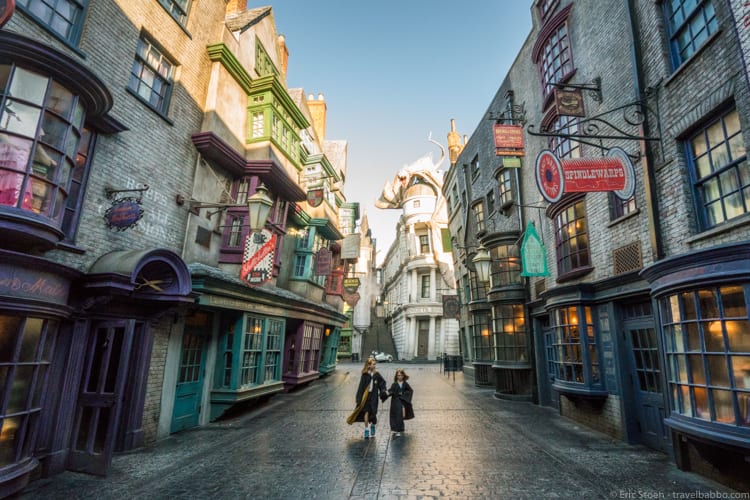
But I’ve turned down (or ignored) hundreds of brand ambassador offers. Why? Because they weren’t well-structured programs. Based on my experience, this is what I look for:
Elements of a Successful Brand Ambassador Program
1. it’s a paid brand ambassadorship.
I’m great being an unpaid ambassador for AFAR given that it was the first ambassadorship I accepted and there aren’t recurring deliverables, but since then I’ve only accepted paid brand ambassador roles. If I’m working to market for a company I expect to get paid monthly for that. And my revenue shouldn’t be based on affiliate programs or otherwise tied to sales. It’s fine if there’s a bonus for sales I generate, but so much brand promotion now is on platforms like Instagram where I’m creating brand awareness without direct purchase links, or there’s a slower sales cycle where someone will see my post now but not make a purchase for months, without that revenue being tied to my promotion.
I’ve seen brand ambassador roles for travel influencers anywhere between $500 and $5,000/month depending on deliverables and the reach of the influencer/ambassador. Obviously celebrities can earn far more.
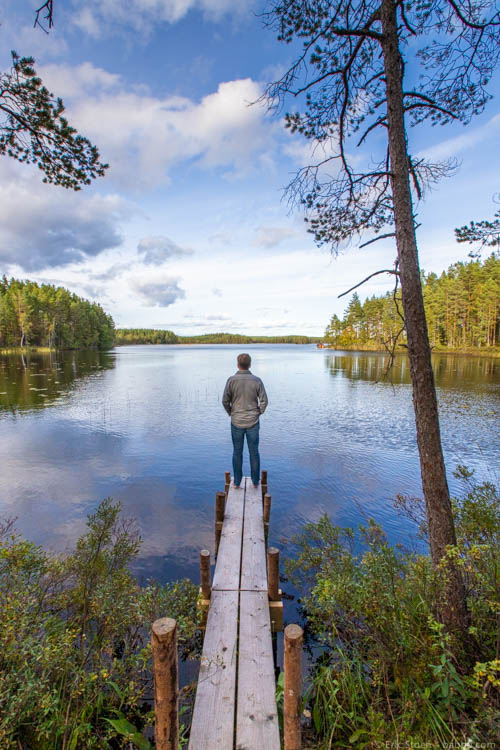
2. There are firm deliverables
A company should require set deliverables, including monthly social posts and periodic blog posts, either on my site, the brand’s site or both. Universal Orlando had us attend and promote attraction/park openings as well, and Travelocity flew us to Mexico several times to brainstorm the program and our roles and to promote resorts at the same time (with additional pay).
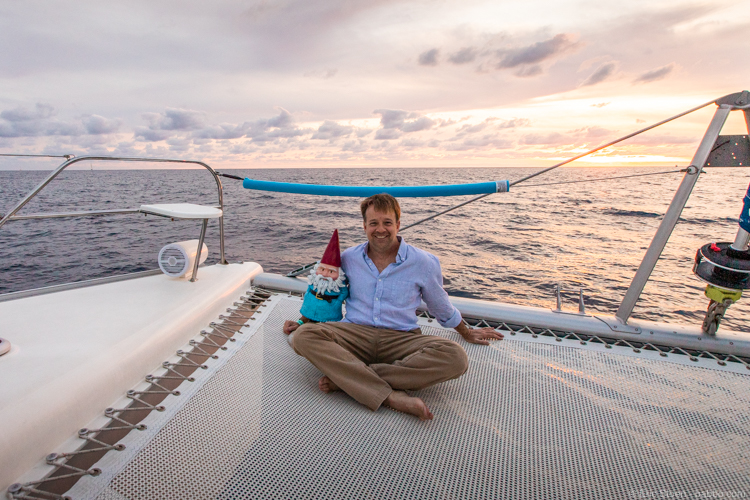
3. There are a limited number of brand ambassadors
I want a program to feel exclusive. If you make bracelets and you’re sending out thousands of DMs offering ambassador roles whereby you send the “ambassador” a free bracelet and they agree to do social posts, that’s not really an ambassadorship. There’s no long-term obligation, and the hundreds of people who accept your offer aren’t going to feel a particular bond to you. A good brand ambassador program should have 10-15 people max, all of whom love your brand and have different niches, so that the monthly promotion is as wide as possible. Give your group of ambassadors a name. Bring everyone together in person at least once a year. Make it fun.
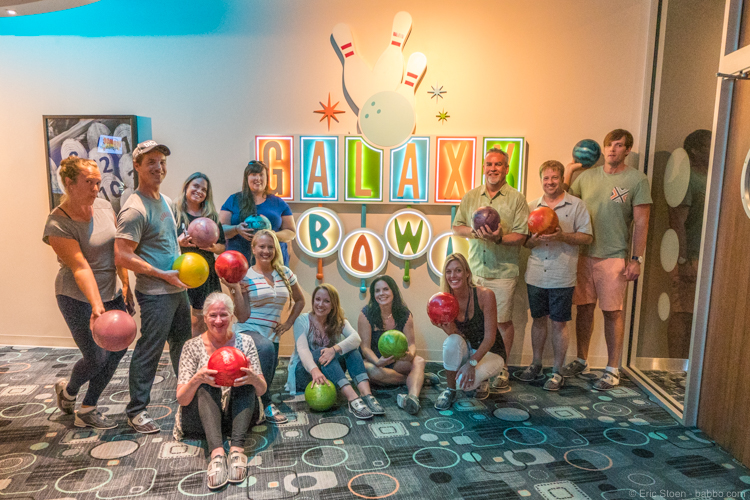
4. It’s an exclusive relationship
If I’m getting paid monthly by a company to be a brand ambassador, they should expect me to be exclusive and not promote direct competitors. In the example I gave above about a bracelet company, there wouldn’t be any expectation of exclusivity – not for a free bracelet. But I want to be closely associated with any brand where I’m an ambassador and for that to come across in my social bios and in everything I do and post. If I’m an ambassador for T-Mobile, for example, I’d make sure that I’m only using T-Mobile, and T-Mobile would even be seen on unrelated screen shots on IG Stories. If I’m not passionate about T-Mobile, I shouldn’t be an ambassador for them.
In a case where absolute exclusivity doesn’t make sense, such as with a Middle Eastern airline that can’t transport you domestically, at the very least don’t do posts while flying other airlines and don’t agree to promotional agreements with other airlines. If you feel like it’s risky to accept exclusivity because you think a better/cooler partnership could come along, then price that exclusivity into your contract. I’ve had five different contracted campaigns with Capital One and, although never officially an ambassador, I was exclusive to them for over two years. I turned down several other credit card campaigns during that time, but I never regretted my exclusivity – after all, it kept leading to additional contracts.
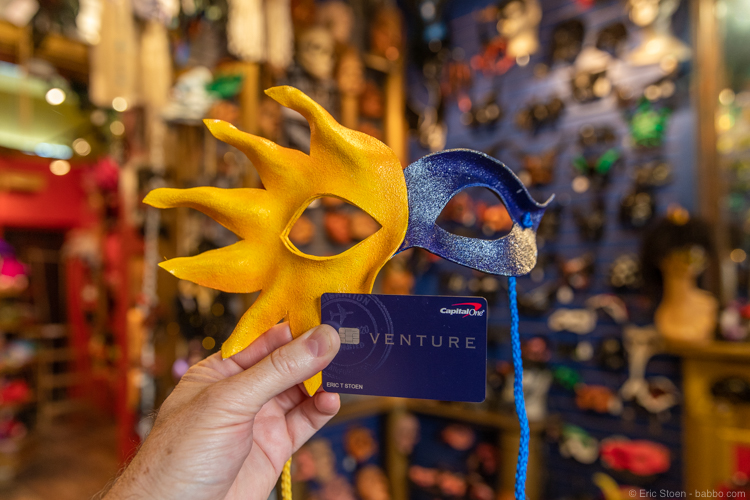
5. A brand ambassadorship is long-term
I usually contract for six-month ambassadorships, with terms for extending them six months at a time. I’ve also had one-year initial terms, which is even better. If I like a company and they like me, I want that relationship to last as long as possible, and a long-term mutually-beneficial partnership is always going to be better than a one-and-done partnership. Your followers will notice when you’re consistent long-term in who you recommend, and they’ll also notice when you’re inconsistent.
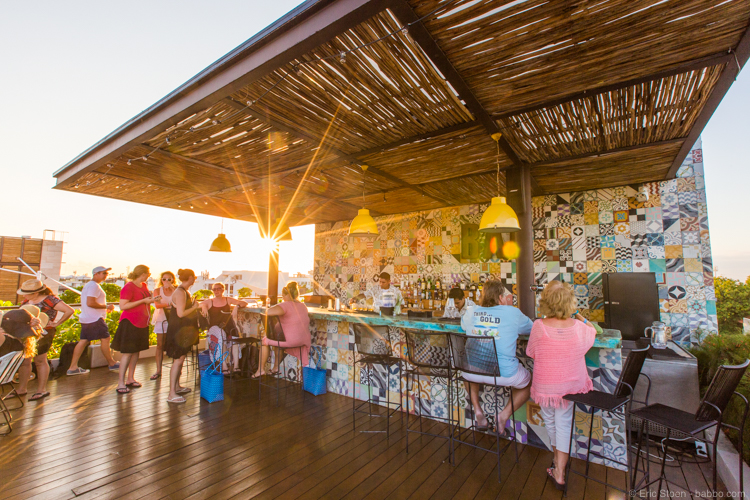
Advice to Companies
If you’re thinking of developing a brand ambassador program, I’d encourage you to:
- Interview potential ambassadors and choose a group that will work well together. You want a cohesive group, and you want your ambassadors to mutually support each other even outside of your deliverables.
- Have a one-year budget large enough for everything you want to do.
- Expect to significantly increase brand awareness and be prepared to accept that as a primary program benefit. It could be hard to tie revenue gains directly to your ambassadors, but they can play a major role in long-term company growth as part of an integrated marketing program.
- Send your ambassadors cool things. Everyone likes to get fun and/or practical swag. And when people get things in the mail, they’ll do additional posts for you and integrate those items into their lives and travels. My 18-inch Travelocity Roaming Gnome has been in the background of many Zoom calls this past year.
- Have an out. Although I like six-month or one-year agreements, make sure that you can terminate an ambassador if you think someone will represent you negatively, or if one person doesn’t get along with the rest of your group.
- And promote your ambassadors! The more attention you bring to them, the bigger they get, and the more it benefits you. It really is a two-way street.
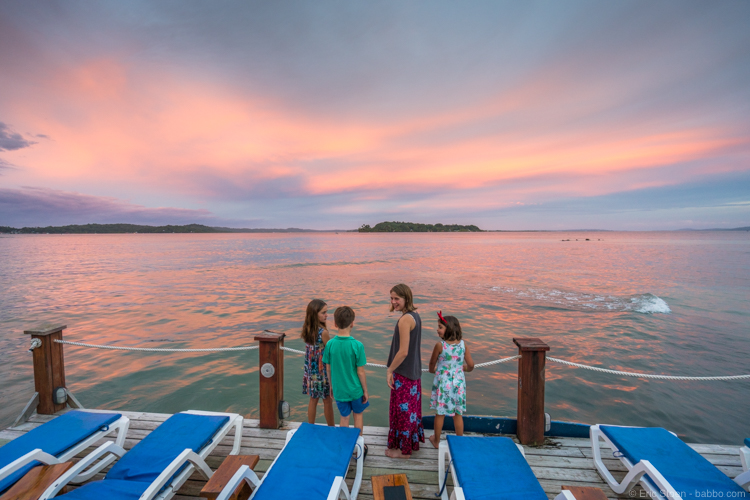
“How Do I Become a Brand Ambassador?”
Most of my brand ambassadorships came about from in-person networking. Per my post on Advice for Travel Bloggers , networking is vital. I attended several AFAR events around the world before they asked me to be an ambassador. I met with Travelocity and Universal Orlando at multiple events. The Thomson Family Adventures ambassadorship came out of a hike during the ATWS conference in Alaska. And if a brand that I really like reaches out to me, I’m willing to be bold and propose an ambassadorship.
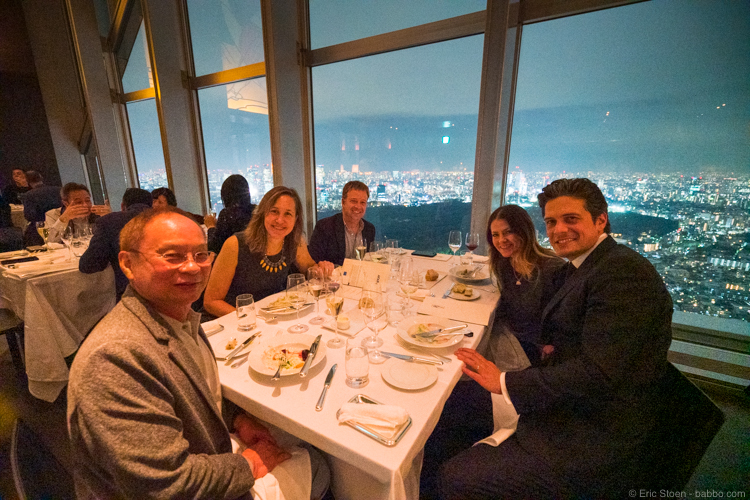
Feel free to send an outbound pitch to a company that you like, but a lot of things need to come together for your pitch to be successful: the company needs to have a budget; an ambassador program needs to be something that they’ve thought about or that they can integrate into their current marketing plan; and you need to be the perfect fit. In your pitch email make sure you emphasize your history with the brand and how they can benefit from partnering with you.
Brand Ambassador Best Practices
Have you been a brand ambassador, or have you managed ambassadors for your company? What am I leaving out above that could be considered a best practice?
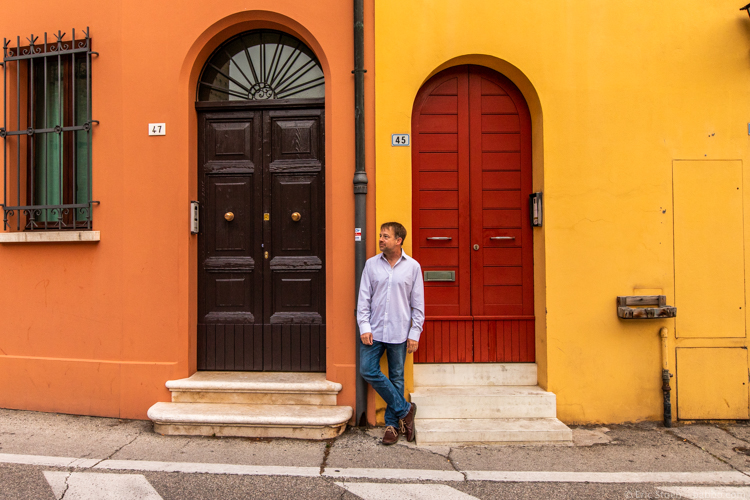
More from Travel Babbo

February 24, 2021 at 7:59 am
Great post, Eric. I like how you incorporated both sides of the equation and it has me thinking about brand ambassadorships that could be a good fit for Dan and me. 🙂
February 24, 2021 at 9:29 am
Thank you Mikkel!
Leave a Reply Cancel reply
Your email address will not be published. Required fields are marked *
Newsletter Signup
Sign up to receive email updates and to hear what’s going on with Travel Babbo!
Privacy Overview
Search Travel Market Report

- Packaged Travel
- Hotels & Resorts
- Destinations
- Retail Strategies
- Niche & Luxury
- Training & Resources
- Brian Israel
- Briana Bonfiglio
- Dan McCarthy
- Dori Saltzman
- Jennifer Arango
- Kelly Fontenelle
- Keri-Anne Slevin
- Louis Intreglia
- Sarah Milner
- Tom McCarthy

First Look: Intrepid Travel’s New Rebrand
Photo: Intrepid Travel
For the first time in more than 15 years, tour operator Intrepid Travel is getting a refreshed look.
Intrepid this week unveiled a new mission, vision, purpose, and an updated rebrand as it readies to embark on its next chapter, a chapter that it hopes includes becoming the first $1 billion dollar adventure travel company and travel B Corp by 2025.
“Intrepid’s new brand identity is so much more than a new logo and look,” CEO James Thornton said. “We’ve reflected on the past 18 months and leveraged our strengths, purpose, and ambition to look to a brighter and more connected future. I couldn’t be more excited to see joy brought back to travel—while renewing our focus on advocating for our planet and its people."
According to Intrepid, the refresh includes four important changes, which start with its first-ever product statement that has been incorporated into its new look.
“This singular product statement acknowledges that sustainability and travel are not mutually exclusive, in fact, Intrepid believes traveling in a way that empowers communities and protects the planet creates a better experience for travelers,” Intrepid said in the release.
The statement includes an evolution of Intrepid’s tour offerings—the company has added 200 tours since the onset of the pandemic, focusing on serving both the environment and communities around the world.
Next, Intrepid has a new vision, going from “changing the way people see the world” to “changing the way we all see the world,” a shift to what Intrepid sees as a more inclusive brand. The vision includes a newly launched Global Ethical Marketing Policy and forthcoming Ethical Marketing Guidelines.
Intrepid created the guidelines with the help of six external consultants who are experts in areas such as BIPOC travel, LGBTQIA+, size inclusivity, modern colonialism, and impact/greenwashing.
Then, Intrepid has installed a new purpose and mission for its future.
The purpose, “We exist to inspire, create, share, and lead the best travel experiences ever—for both people and the planet,” builds on its track record as a carbon-neutral, sustainable, and ethical tour operator.
The mission, “to create positive change through the joy of travel,” also builds on that, with community-based tourism that provides both economic and social benefits to locals in communities around the world.

MOST VIEWED
- Report: Delta Air Lines Plans to Drop Baggage Recheck on Arrival to U.S.
- Op-Ed: Why I Won’t Use Costco for Travel Again
- Catering Strike Causes Delays at Toronto Pearson Airport
- U.S. State Department Updates Warnings for Two European Destinations
- Hawaii Set to Ban Airbnb and Short-Term Rentals State-Wide
- Horseshoe’s Jubilee Tower Becomes the Versailles Tower at Paris Las Vegas
- California Bans Drip Pricing: What It Means for Travel Advisors
- Holland America Group Resigns USTOA Membership
- Carnival Corp. Changes Advertised Pricing Policy & Cancellation Fee Structure to Comply with Calif. Law
- Princess Cruises Transforms Dining System Fleetwide
- American Airlines Pushes AAdvantage Change for Travel Agencies
- Delta Air Lines Is Changing the Way It Boards Flights

Subscribe today to receive daily in-depth coverage, analysis of industry news, trends and issues that affect how you do business. Subscribe now for free.
Subscribe to TMR
If you have clients looking to spend an exciting seven hours in London, we have a land tour for them.

The airline pulled its Porter Escapes program, which paired flights with hotels and attractions.
Jamaica travel specialists share insight on selling the destination in 2024.
Virgin Limited Edition is expanding in Africa with the addition of the award-winning property.
Classic Vacations is expanding its online booking platform for travel advisors to provide more functionality.
In the first phase of its Travel Advisor Portal revamp, the Globus family of brands has introduced several enhancements.


Headquartered in Toronto, Ont., TravelBrands, a division of H.I.S.-Red Label Vacations Inc., is one of Canada’s leading travel groups. Its multi-channel distribution network is comprised of multiple brands and subsidiaries.
Contact Info
- 1-888-485-1481
- 2013-2023 TravelBrands
- 5343 Dundas Street West, 4th Floor Toronto, Ontario, M9B 6K5
- Meet The Team
- Our Mission
- Agent Appreciation
- Media Centre
- Social Responsibility
- Partnerships

Canada’s top names in travel.

Your All-in-One Access to the World.

Learn what Access+ can do for your business!

TravelBrands Charity Golf Classic
What our customers have to say.

VIKAS MALHOTRA

Herman De Souza

Paulina Gutierrez
Travelbrands offers travellers the world – however they may want to experience it..

Our Promise

'Rare' and 'Critically Endangered' Animal Born at Disney's Animal Kingdom Lodge
A "rare" and "critically endangered" animal was born at Disney's Animal Kingdom, and not only is he cute and good news, but he has a great name, too.
On May 10, 2024, Disney Parks took to its blog to share the good news that a new baby had entered the world. Take a look!
“At Disney, every animal birth is important, but there’s something extra special about an odds-defying, critically endangered baby,” the company’s blog reads.
Related: Disney's Animal Kingdom Welcomes Brand New Baby Elephant
Just in time for Mother’s Day at Disney’s Animal Kingdom Lodge , they’re celebrating a win for the Addax species. A boy they’ve named Julien.
“Julien stands just over an adorable two feet tall with a great head of hair and is as cute as can be,” Disney shares on its Parks blog.
“He is welcomed by his mom Juniper and the rest of the herd over at Disney’s Animal Kingdom Lodge and is the first male calf born at the resort.”
The name holds special meaning, too, as it is a hybrid of his parents’ names.
The company explains, “An ode to his mom and dad, Julien’s name is a combination of Juniper and Allen, who are all part of the larger herd.”
“Actually, we at Walt Disney World are one of just 21 AZA accredited institutions who have addax in our care, and what better place to be able to see them than on the savanna at Disney’s Animal Kingdom Lodge.”
Mama Juniper Has Been Through a Lot in Her Life
Chip and Company shared a video about the new Addax's birth, with more details on why this birth is extra special for his mom, Juniper.
“Mom Juniper’s story defies the odds. She was born in August 2021 and during the birth, her mother passed due to complications leaving Juniper without a mom,” the company shared in the caption of a YouTube video.
“Keepers and animal care experts quickly stepped in and showered her with care and helped raise her,” they continued, noting that this is extra special for the zookeepers who are now celebrating Juniper becoming a mom.
The company continues, “Both Juniper and Julien have been nursing, nuzzling, and bonding in a backstage area ahead of Julien’s debut on the savanna.”
Facts About the 'Critically Endangered' Addax
According to the International Union for Conservation of Nature ( IUCN ), Addax is on the brink of leaving the world in the wild.
"Addax is listed as Critically Endangered because the total population is estimated to number under 100," the organization warns. This number is "well below the threshold of 250 mature individuals," and nearly all of these animals in the wild are all in one small area of Niger.
"Numbers continue to decline due to poaching and disturbance from oil exploration," the organization warns.
With the birth of one more Addax, this one at Disney's Animal Kingdom Lodge, it's

NEWS... BUT NOT AS YOU KNOW IT
Tesco shoppers are just learning little-known meaning behind supermarket’s name

Share this with

Some of us nip down to our local Tesco supermarket daily for a meal deal , or weekly to do a big grocery shop — so it’s fair to say we’re pretty acquainted with the brand.
We could recognise the iconic blue and red logo from a mile away, and know off the top of our heads that the company’s slogan is ‘every little helps’.
But there’s one thing many of us probably don’t realise about the retailer, and that’s where the name came from and what it actually means.
Did you know it actually dates back 100 years?
Tesco was founded in 1919 by Jack Cohen, who originally set the business up as a market stall in Hackney, London , after he returned from World War I.

A few years later in 1924, Jack launched the company’s first own-brand product, which was tea. The tea was supplied by a man named Thomas Edward Stockwell, and Jack combined Thomas’ initials, with the first two letters of his own name to call it Tesco Tea.
Thus ‘Tesco’ as a brand was born and the name stuck. This was before the business had any physical stores, as the first one didn’t open until 1929.
The first ever Tesco shop was located in Burnt Oak in Edgware and sold value dry goods and, of course, the all important own-brand tea. It wasn’t until 1958 that the company would open its first supermarket in Maldon in Essex.
Since then Tesco has grown massively and today has stores and supermarkets in five countries and 1,000 cities, with 2,895 branches across the UK. London has the most Tesco stores in the country, with 321 locations in total.
Another brand that has a rather surprising meaning behind its name is B&M . Customers often mistakenly think the retailer’s name is Bargains & More, but this isn’t the case.
When the company was founded back in 1978, it was originally called Billington & Mayman, named after its founders, Malcolm Billington and Brian Mayman.
The name was later shortened to B&M and in 2004 it was taken over by brothers Simon and Bobby Arora. When they bought it there were just 21 stores nationwide, but there are now over a whopping 650 shops across the UK.
It’s not surprising that many people don’t know what the letters really stand for, as even the former CEO Simon Arora, had confessed he didn’t know what it meant.
In an interview with the McKinsey Alumni Center , he revealed: ‘Someone once told me that it was obvious – it stands for “Bargains and More”. That’s good enough for me.’
However, a B&M spokesperson has since settled the debate once and for all, confirming to Metro.co.uk that the letters do actually stand for ‘Billington & Mayman’.
So, there you have it folks, we’ve all learned something new today!
Do you have a story to share?
Get in touch by emailing [email protected] .
MORE : Khloe Kardashian’s favourite skincare brand is available in the UK
MORE : When are clothes shops open on Bank Holiday Monday 2024? Primark, M&S, and more
MORE : Neem London is the hot new menswear brand for all the fashion dads out there

Sign up to our Shopping newsletter
Get the latest trends, offers and trusted reviews

You had blonde hair, were wearing a tan/yellowish jacket and had the…
To the red-haired dancer enjoying a snack watching people and smiling…

Enter your birthday for your free daily horoscope sent straight to your inbox!

Get us in your feed
Money blog: McDonald's changes iconic Happy Meal box; AI-powered mortgage lender cuts rates
The fast food giant has made the change to shine a light on mental health. Read this and all the latest consumer and personal finance news in the Money blog - and leave a comment or your money problem in the box below.
Tuesday 14 May 2024 21:00, UK
- Strong wage growth shrinks hope of interest rate cut
- McDonald's changes iconic Happy Meal box
- AI-powered mortgage lender cuts rates twice in a week
- Traitors winner reveals what he's spent his prize money on so far
Essential reads
- The 'fast food' trend hitting Michelin starred restaurants
- What is PIP - and what could government changes mean?
- How to make sure your car passes its MOT
- 'Loud budgeting': The money-saving trend that has nothing to do with giving up your daily coffee
- Money Problem: My workplace is bringing in new clock-in system to pay us by the minute - is this allowed?
- Best of the Money blog - an archive
Ask a question or make a comment
The Duke and Duchess of Sussex's Archewell Foundation has been labelled "delinquent" in the US for failing to submit annual records.
A letter was sent to the charity on 3 May by by California's Registry of Charities and Fundraisers, saying it has been "listed as delinquent" for "failing to submit required annual report(s) and/or renewal fees".
The letter said an organisation listed as delinquent is banned from "soliciting or disbursing charitable funds" and its registration may be "suspended or revoked".
It is understood that a physical cheque was sent by Archewell Foundation but not received, and a new one has been sent to resolve the issue.
It is believed the charity was only made aware of this when the delinquency notice was published.
Read more on this story below...
Shares of US video game retailer GameStop have soared again today, fuelled by the return of online influencer "Roaring Kitty" to social media.
Real name Keith Gill, the influencer's first online post caused shares to jump yesterday, with another surge reported today.
The retailer's shares rallied 132% in pre-market trading before falling back to about 80% up as US markets opened.
Mr Gill shared a meme and more than 10 clips from movies including The Avengers and Tombstone. Though the posts didn't mention any company names, GameStop and US cinema chain AMC were the most-traded stocks by investors yesterday and today, according to data from JP Morgan.
He is credited with helping to fuel the "meme stock" craze during the COVID pandemic, which saw GameStop shares rise more than 1,000%. They later collapsed as interest faded.
Tesco's managing director has seen his pay deal more than double to almost £10m.
That's 431 times the wage of the average £23,010 salary for a Tesco worker.
Ken Murphy received a pay packet worth £9.93m for the year to February, the supermarket's annual report revealed.
His pay deal came to £4.4m in the previous financial year.
The rise was driven by £4.91m from his performance share plan (PSP) after he helped lead the company to higher profits in the face of challenging inflation.
This PSP payment will be paid out in Tesco shares and is based on the company's performance since 2021.
It comes on top of an annual salary of £1.64m and an annual bonus of £3.38m.
The group's chief finance officer, Imran Nawaz, also saw his annual pay package more than double.
He received a total £4.95m for the year, jumping from £2.27m in the previous financial year.
The retailer was criticised for revealing a £2.83bn profit for the year to February when many customers had been impacted by rampant food and drink inflation.
Alison Platt, chairwoman of the Tesco remuneration committee, said the pay boost reflects the fact "Tesco has delivered for all of its stakeholders over the last year".
She added: "Tesco remains committed to a competitive and fair reward package for all colleagues and over the last two years we have invested more than £800m in colleague pay, as well as significantly enhancing the range of wellbeing benefits we offer."
Sony's operating profit has climbed 5% this business year - even as it forecasts lower PlayStation 5 sales.
The Japanese entertainment and electronics company said its operating profit is expected to come in at 1.28 trillion yen (£6.5bn) in the year ending March.
Sony, a major supplier of image sensors for smartphones, said its chips business is expected to book a 40% rise in operating profit on higher sales and lower costs.
At its gaming unit, revenues are expected to fall with the PlayStation 5 in its fourth year, but Sony said user engagement and cost control could drive future profitability at the business.
It predicted PlayStation 5 sales will fall to 18 million units from last year's 20.8 million.
Cheaper energy deals for new customers could potentially return in October, with the industry regulator announcing a review of their ban.
Ofgem is consulting on removing the block on acquisition-only tariffs in an attempt to encourage competition between suppliers.
The ban was introduced as a short-term measure in April 2022 to protect consumers during the energy crisis, and was due to be lifted in March next year.
Now, the regulator has said that it is the right time to consider removing it as the energy market continues to stabilise.
MoneySavingExpert Martin Lewis welcomed the consultation, saying: "We need anything possible right now to stimulate competition and bring prices down."
"In normal times, I wouldn't call for firms to be allowed to offer new customers cheaper prices than existing, yet these aren't normal times."
Melinda French Gates has left the charity she set up with her former husband, Microsoft billionaire Bill Gates, after the couple's divorce.
In a statement, she said she would step down from her position at the Bill & Melinda Gates Foundation on 7 June.
You can see her full statement below...
The foundation was created in 2000 and it is one of the most influential charitable organisations in the world.
It has spent billions working to tackle poverty and disease around the world.
Bill and Melinda Gates announced they were divorcing three years ago after being married for 27 years.
An AI-powered mortgage lender has cut rates for a second time this week.
MPowered has reduced all its two and five year fixed deals, with rates starting at 4.37% down from 4.59%.
"The swap markets are moving at pace at present, and it is important that as a responsible lender we are able to react and pass on any savings we can to borrowers," said Matt Surridge, sales director of MPowered Mortgages.
"I'm therefore really pleased we are one of the first, if not the first, to cut rates this week, having already cut rates once in the past week."
The company uses AI in its mortgage process and is a fully digital platform.
McDonald's has decided to remove the iconic smile from its Happy Meal box in a bid to teach children about their emotions.
Instead, a sheet of stickers depicting different moods will be placed inside, which children can use to express their feelings.
A QR code for a mental health hub will also be placed on the red packaging to provide its younger customers with different resources about emotional wellbeing.
The move comes as part of Mental Health Week, with research by the fast food chain finding nearly half of children feel pressure to be happy all the time.
Football legend Rio Ferdinand has teamed up with the company to support the campaign, which runs until 19 May.
The father-of-five said: "It's our job to empower our children to express themselves freely and support them every step of the way in understanding that it's okay to not be happy all the time."
The Traitors' winner Harry Clark has revealed he's only spent some of his prize money so far, and it's gone towards clearing his relatives' debts.
The 23-year-old won £95,150 after successfully convincing his fellow contestants that he was a faithful in the second season of the show.
Speaking on the TV BAFTAs red carpet, the former British Army engineer said his dad has stopped him from spending the cash and has been looking after him.
"He's got his head screwed on. He's been making sure I can get my first place," he told reporters.
"I've just given my family some dosh, just to pay off their debts and stuff like that, so they don't have to worry anymore.
"That's all I've wanted to do in my life."
Police are no longer interested in dealing with shoplifting and retailers are being forced to spend "a lot of money" on protecting themselves, the chairman of M&S has claimed.
Archie Norman said stores have resorted to installing new camera systems and employing store detectives to try to keep crime rates down.
"We get very little help from the police," he told LBC's Nick Ferrari at Breakfast.
"I think we have to accept that the police are not interested in this sort of crime any more. Whether we like it or not, that's the way it has gone."
Shoplifting is at the highest levels since records began in 2003, according to the Office for National Statistics.
It has risen by 37% since last year.
Mr Norman said thefts had surged since the pandemic, and the rising cost of living crisis was also causing problems.
"When people are hard up, or particularly when there's a growth in other forms of crime, particularly drugs-related crime, then one way of financing it is to go and steal from shops… it's understandable given what we've been through in the last couple of years, we've seen more of that," he added.
A change to the law in 2014 now means shoplifting goods worth less than £200 is only a summary offence.
This may have prompted police to pay less attention to it, and it has been on the rise since.
Home Office data also show the number of shoplifting charges has fallen in recent years.
Taking further action wasn't considered to be "in the public interest" in most cases.
Sky News has contacted the Home Office for comment.
By James Sillars , business news reporter
The prospects for a Bank of England interest rate cut are almost 50/50.
That's according to the latest financial market expectations in reaction to this morning's employment figures.
They showed the pace of wage growth remaining stubbornly high - overshooting the expectations of economists.
Strong wage growth is not what the Bank wants to see, as it fears a surge in consumer spending power driving a new wave of inflation.
There is a further set of wage data before the Bank's next rate-setting meeting on 20 June.
That may not help those seeking a cut in borrowing costs, however, as it will reflect the impact of April's big rise in the National Living Wage.
Away from the interest rate cut speculation, the FTSE 100 has opened flat for a second day.
Currys is among stocks doing well on the wider stock market.
The electricals retailer saw its shares trading almost 8% higher in early deals after it raised its annual profit outlook.
Those of Greggs, however, were down almost 1% despite a leap in sales.
The bakery to fast food chain said its performance was in line with expectations and, as such, it had no impact on its forecasts for the full year.
Wages grew by 6% in the three months to March, excluding bonuses, according to the Office for National Statistics.
This is slightly above economists' expectations - bad news for the Bank of England, which wants to see wage growth fall to help ease inflation as it weighs when to cut 16-year-high interest rates.
The Bank is watching wages closely as it looks to bring inflation back to its 2% target, and cooling earnings growth is seen as being key to paving the way for it to begin cutting rates.
In real terms - taking Consumer Prices Index inflation into account - pay rose 2.4% across the period.
In March alone, that figure was 3% - the highest level of growth since July 2021, when it hit 3.9%.
"Earnings growth in cash terms remains high, with the recent falls in the rate now levelling off while, with inflation falling, real pay growth remains at its highest level in well over two years," said ONS director of economic statistics Liz McKeown.
Meanwhile, unemployment ticked up to 4.3% from January to March, compared to 4.2% in the previous three months, December to February.
The number of job vacancies remains about pre-pandemic levels, but has been declining for 22 consecutive months, said Ms McKeown.
"With unemployment also increasing, the number of unemployed people per vacancy has continued to rise, approaching levels seen before the onset of COVID-19."
Be the first to get Breaking News
Install the Sky News app for free


IMAGES
VIDEO
COMMENTS
4. Branding increases your value. Brand equity is the value of your brand name. Having a well-known brand name will help establish your company as a leader in your niche and give your business a boost for further expansion — like opening up a tour office in another location. Since brand equity is all about brand recognition, you can increase ...
January 4, 2024. Ultimate Guide to Travel & Tourism Sector Branding. Tourism marketing is a crucial activity (and increasingly so) in the tourism sector. That is why tourism branding takes particular relevance as a differential and success factor. Tourists are increasingly demanding, and tourism competition is fiercer.
Southwest is an example of how company culture can influence a brand image. If your company has a fun and engaging brand, make sure to hire tour guides that promote that image. The airline stays true to its values and principles, and tour operators should do the same. 6. Build a reputation like Tripadvisor.
Travel brands should ensure customers are informed about any changes, cancellations, or safety concerns promptly. Flexible Booking and Cancellation Policies Offering easy rescheduling options or no-fee cancellations during crises can foster goodwill among travelers, ensuring they choose the brand again when stability returns.
This handy article dives into how to create the right name for your tourism brand. In short, aim to: Research competitor names. Keep the brand name short and sharp. Consider how easy the name will be to search for and find online. Include the location within the name, and. Trademark and protect your brand name.
7. Hilton Hotels & Resorts. 5/11. Dating all the way back to 1919, Hilton Worldwide's flagship brand, Hilton Hotels and Resorts is unsurprisingly one of the most trusted brand names in travel but it still has some significant ground to make up in order to catch its rivals. Nonetheless, seventh-place Hilton was ranked number one on Fortune ...
Definition: Positioning is the strategic effort to create a distinctive and appealing image of the brand in the minds of the target audience relative to competitors. For a Travel Brand: Positioning involves communicating the unique value proposition of the travel brand to its target audience. This could be based on factors such as offering ...
Definition of travel agency branding and its significance. Travel agency branding is about creating a unique identity for the agency. This includes a name, logo, and visual style that represent its values and services. It's vital because it helps the agency stand out in a competitive market. A strong brand attracts customers and builds loyalty.
Create a Brand Identity. Your brand identity includes the visible elements of your company like your logo, colour palette, typography, etc. Your brand design should help your business stand out from other tour and activity providers. If it's within your budget, a good marketing or branding agency can work with you to create a professional ...
The danger, however, with lifestyle branding is it is an inherently nebulous concept, which has a variety of meanings to different marketers. "Quite frankly, I think the term 'lifestyle brand' is overused because it means many different things in many different market segments," said Hoyt Harper II, SVP and global brand leader for Starwood's The Luxury Collection.
Key Takeaways. Eight of the top 10 most trusted travel and hospitality brands are hotels or resorts, with only one airline on the list: Southwest Airlines. Thirteen of the 20 top most trusted travel and hospitality brands are hotels. For consumer trust, the coronavirus pandemic was a net positive for the travel industry: Brands overall are ...
Travel brands are highly trusted, but headwinds abound: While the industry is highly trusted after emerging from pandemic restrictions, many challenges lay ahead that could threaten trust. Holiday Inn keeps its top position as the most trusted travel brand: High usage, affordability and continuity of experience have kept Holiday Inn at the top ...
A strong, solid marketing strategy is important for any brand - and it's no different for the travel industry, one of the fastest-growing markets in the world. These days, the power and magnitude of the internet are undeniable, meaning the world is becoming way more visible than ever before. While this means that there are … Continued
Designers from around the world pitch you ideas. You provide feedback, hone your favorites and choose a winner. Find the perfect designer to match your style and budget. Then collaborate one-on-one to create a custom brand. 4.9 average from 119 logo & brand identity pack design customer reviews.
Designers from around the world pitch you ideas. You provide feedback, hone your favorites and choose a winner. Find the perfect designer to match your style and budget. Then collaborate one-on-one to create a custom brand. 4.9 average from 119 logo & brand identity pack design customer reviews.
Travel brands didn't invent loyalty programs, which have been traced to as far back as the 18th century. 1 James J. Nagle, "Trading stamps: A long history," New York Times, December 26, 1971. But ever since the first major airline frequent flier programs appeared in the early 1980s—soon to be followed by similar programs from hotel chains—the travel industry has become known for ...
You'll also find bikinis, cover-ups, and various other travel accessories for women, like hats, sunglasses, and beach bags. We tested The Amalfi One Piece and fell in love with the thick, durable ...
Travel brand partnerships are the result of one company collaborating with another brand for some kind of special promotion or offer. The right kind of strategic partnership can result in many benefits to your travel company and the other business. This is in terms of accessing a broader market and offering more value to your customers.
AFAR is the award-winning travel media brand that makes a positive impact on the world through high-quality storytelling that inspires, empowers, and enriches travelers who care. We believe in the power of travel to make the world a better place through experiences that enrich the traveler personally, support the communities visited, and are ...
Brand Ambassador Definition What is a Brand Ambassador? Loosely speaking, a brand ambassador is someone who represents your company in a positive light, generating increased brand awareness and, ideally, increased revenue. With social media, brand ambassadorships have increased exponentially. However, there are many types of brand ambassadorships, and they're not
For the first time in more than 15 years, tour operator Intrepid Travel is getting a refreshed look. Intrepid this week unveiled a new mission, vision, purpose, and an updated rebrand as it ...
Mar 24, 2024,06:00am EDT. India's surging middle class is projected to spend as much as $144 billion a year on international travel by 2030. And hotels, airlines and cities are spending millions ...
KLM Royal Dutch Airlines has announced the launch of its new brand platform " Travel Well ," to promote meaningful travel. KLM has launched "Travel Well" to share the belief that travel is ...
Giving millions of Canadian consumers access to the world, TravelBrands is the most comprehensive one-stop-shop in the travel industry. Working closely with the travel agent community and global partners, TravelBrands strives to offer Canadian travel agents and travellers innovative solutions to fulfill travel wants and needs. Get Free Quote.
Related: Disney's Animal Kingdom Welcomes Brand New Baby Elephant. ... The name holds special meaning, too, as it is a hybrid of his parents' names. The company explains, "An ode to his mom ...
The tea was supplied by a man named Thomas Edward Stockwell, and Jack combined Thomas' initials, with the first two letters of his own name to call it Tesco Tea. Thus 'Tesco' as a brand was ...
The fast food giant has made the change to shine a light on mental health. Read this and all the latest consumer and personal finance news in the Money blog - and leave a comment or your money ...